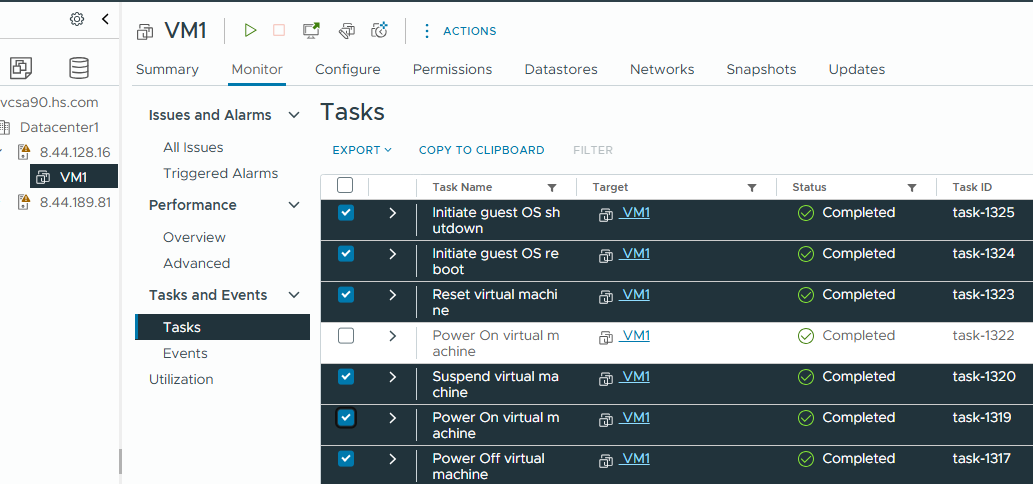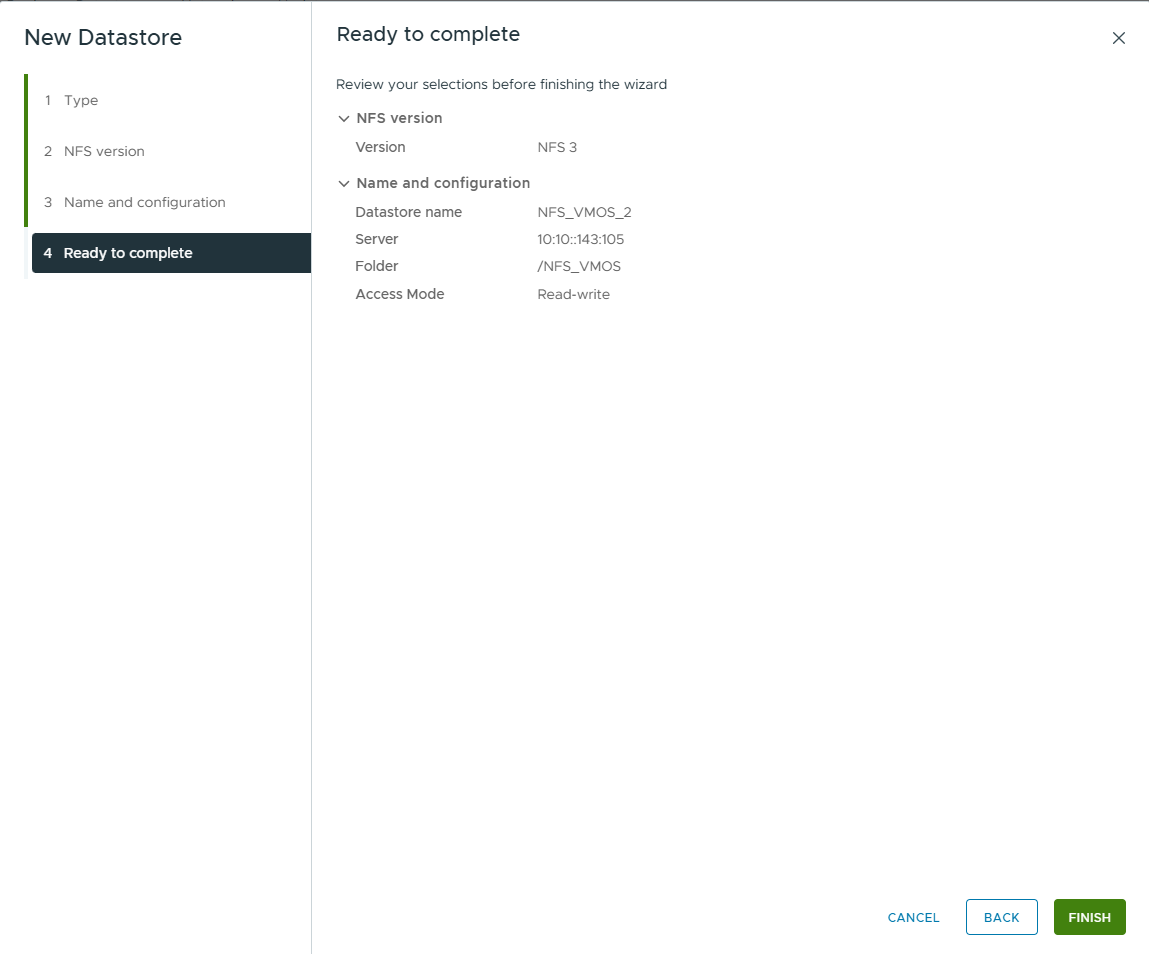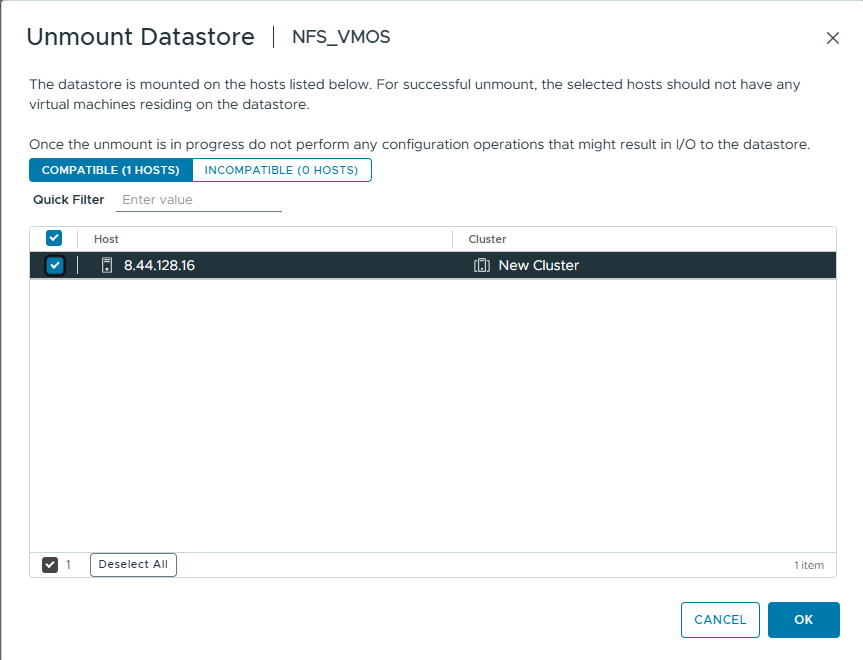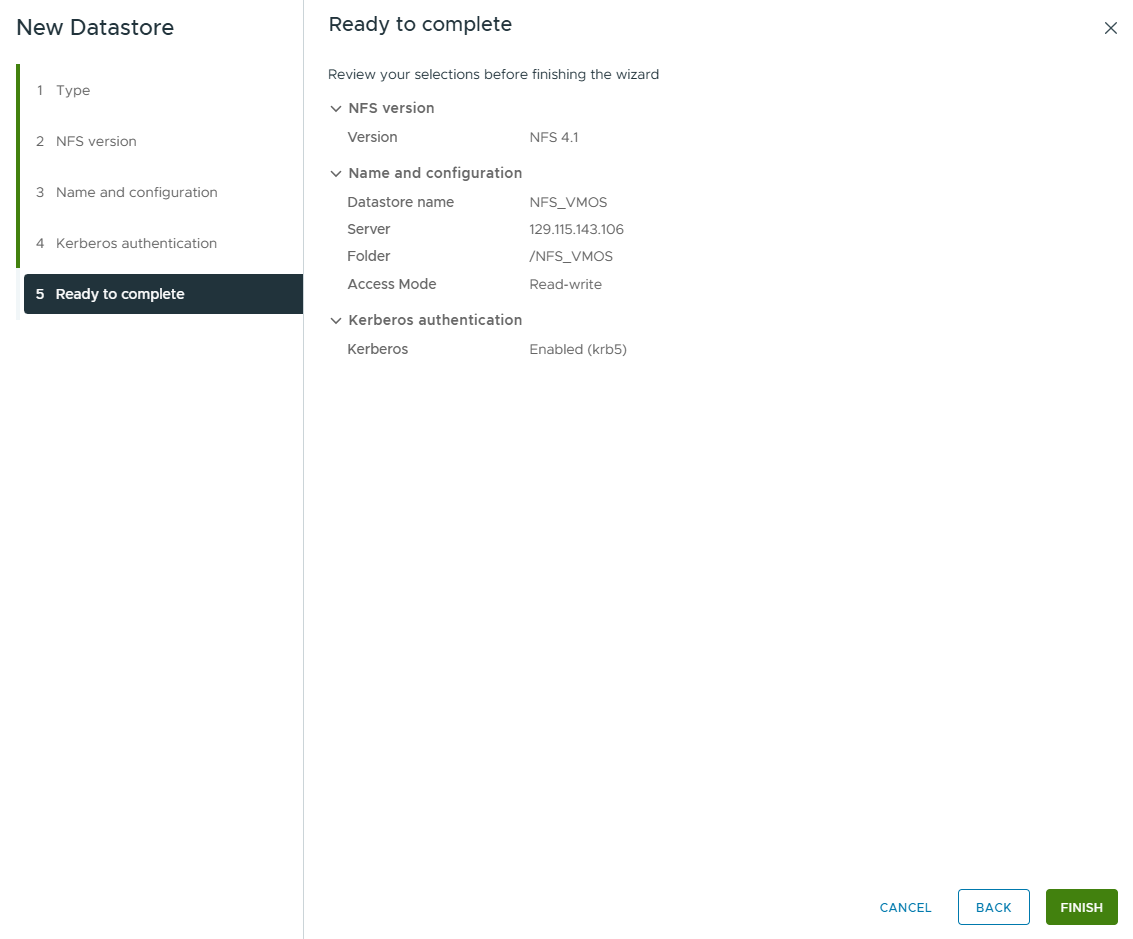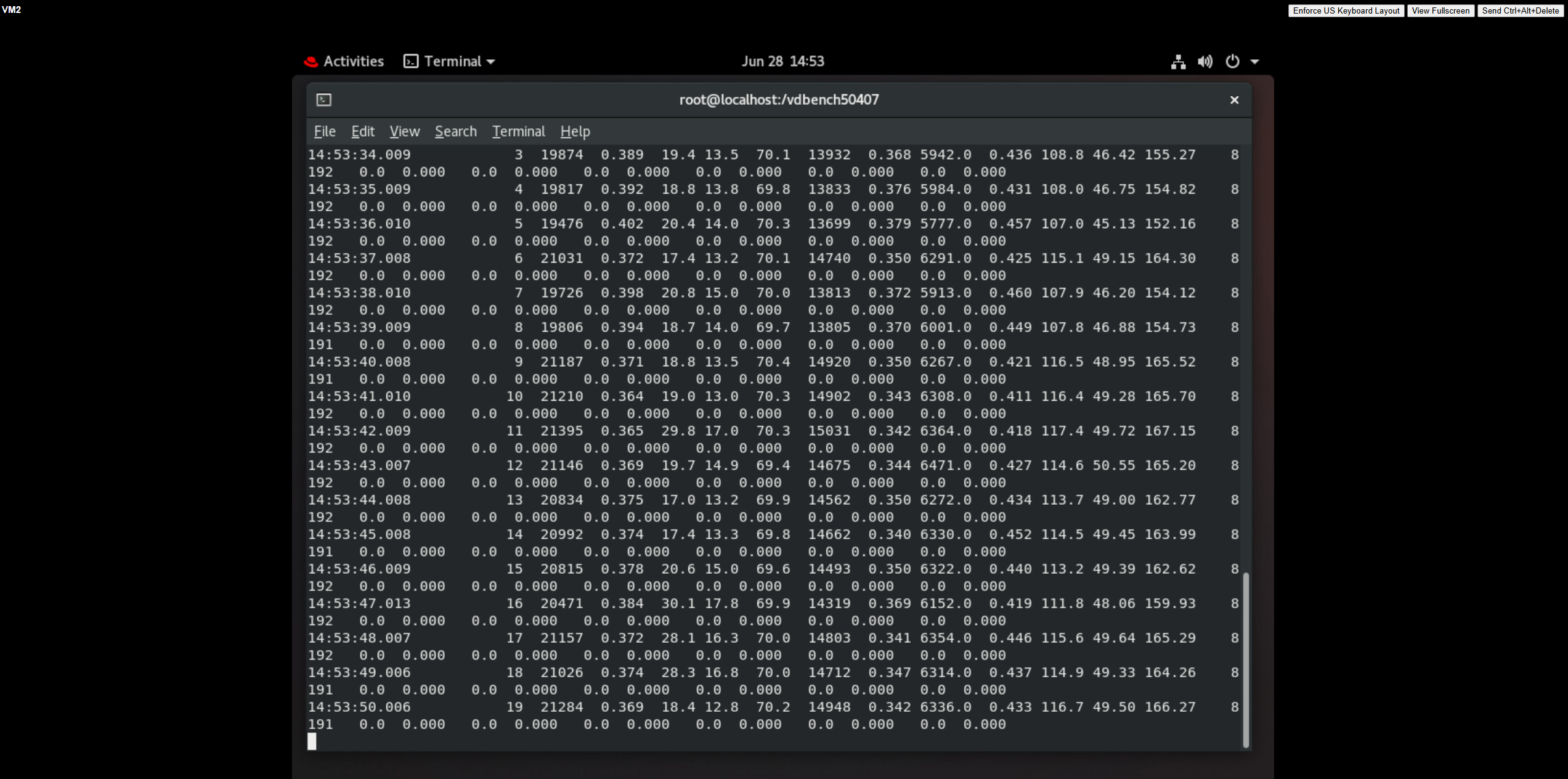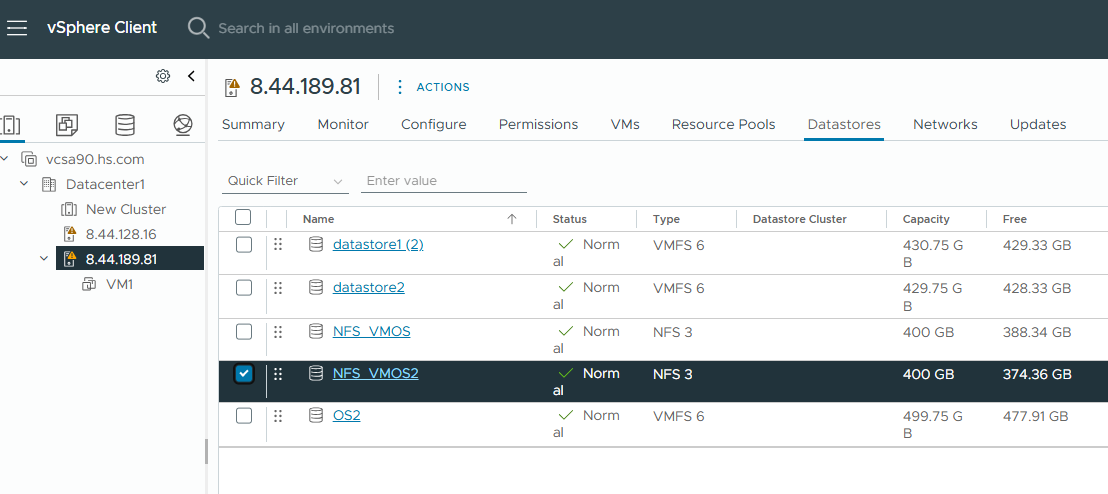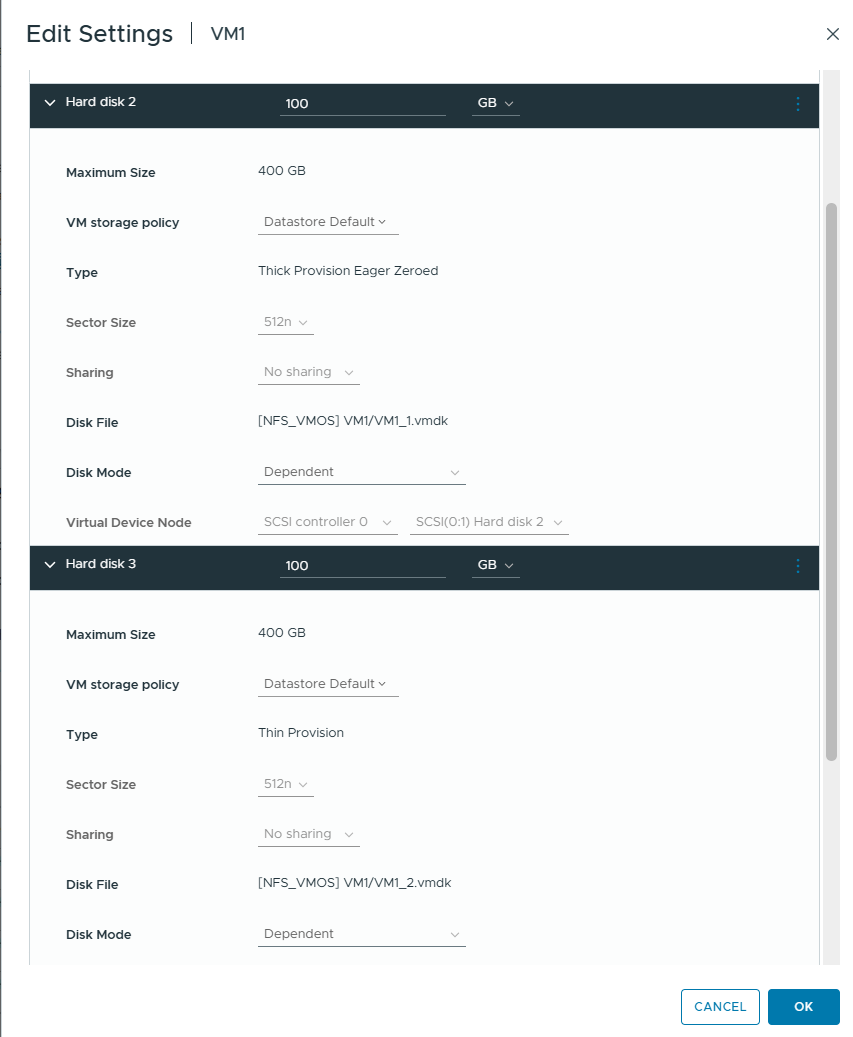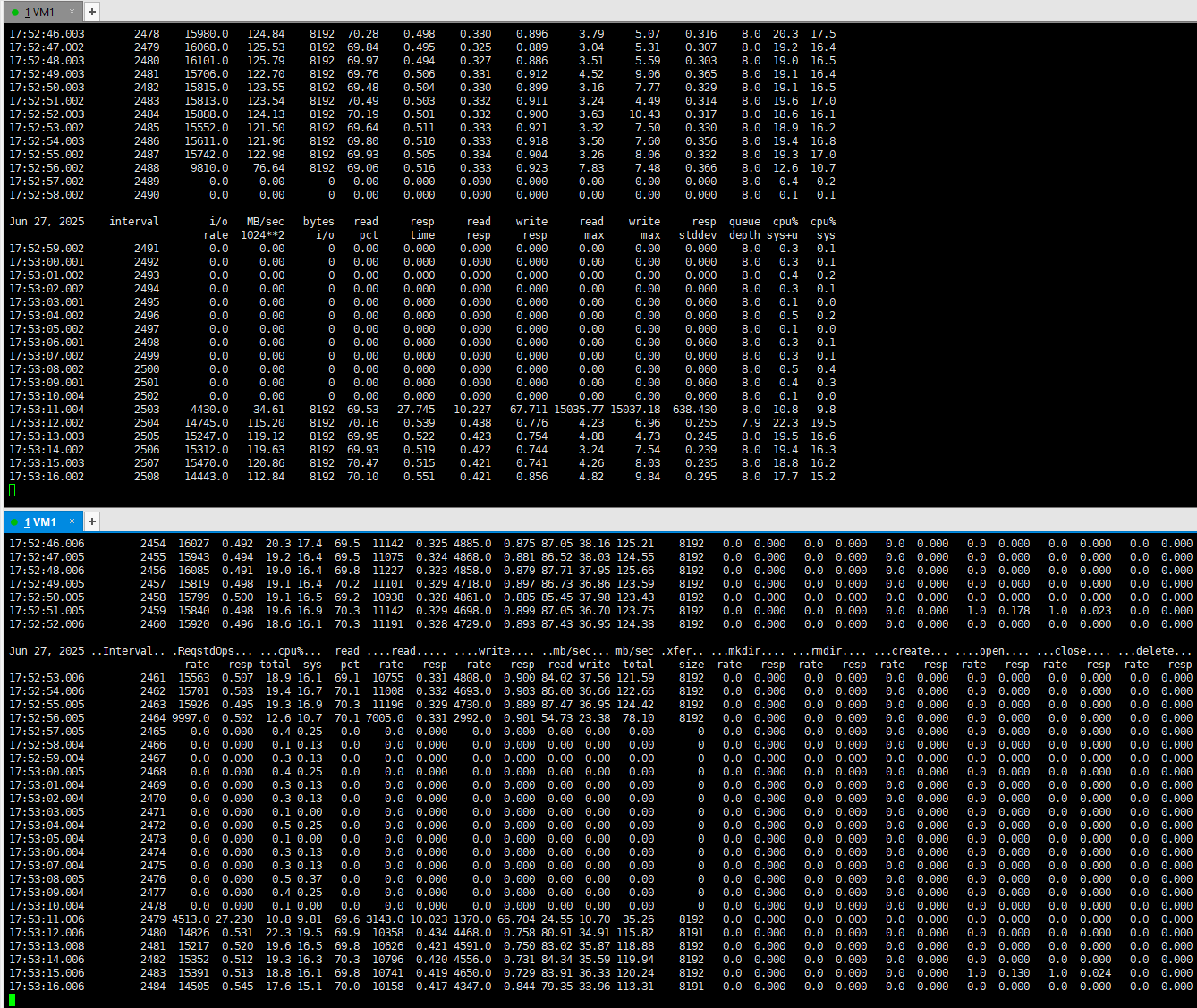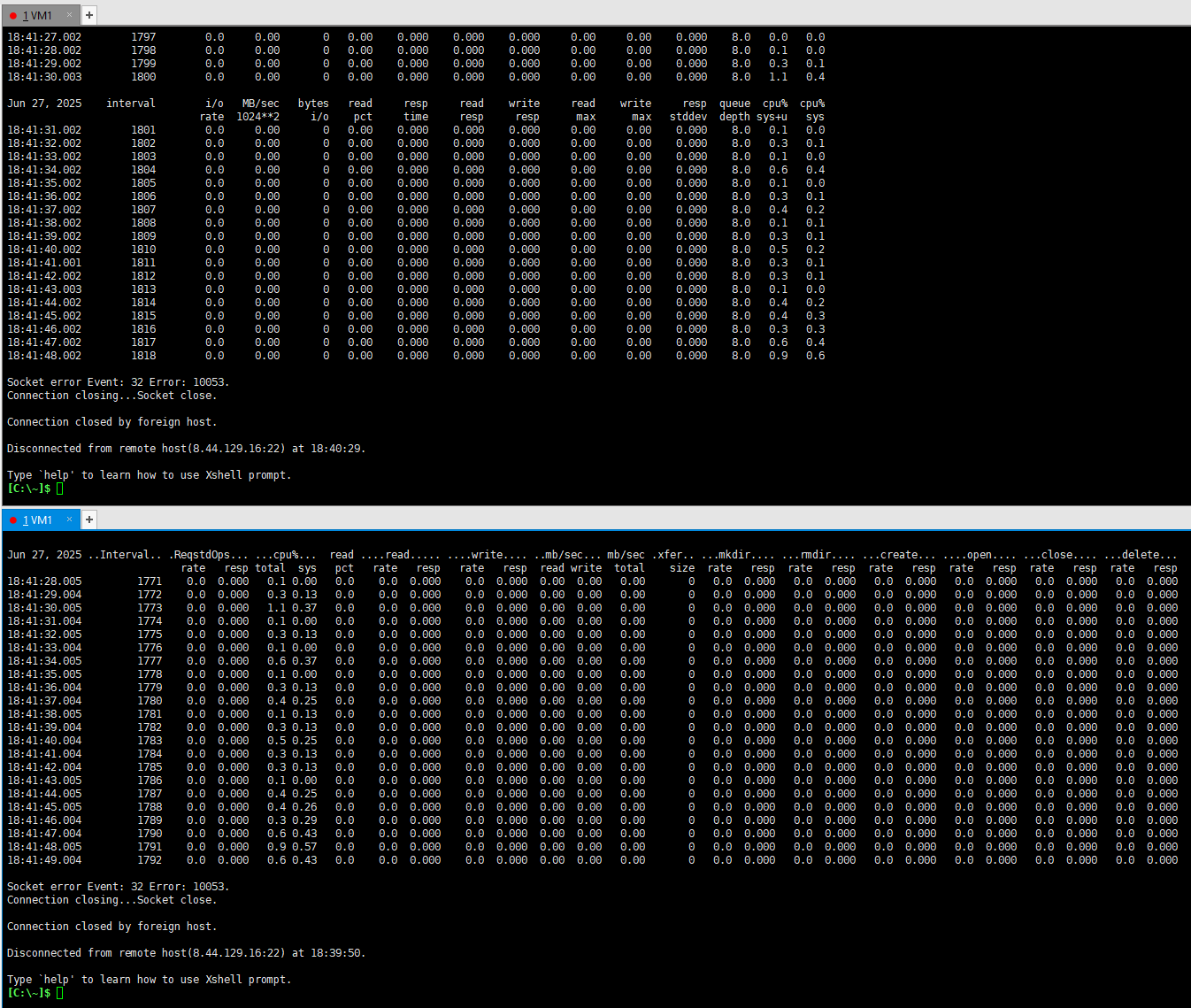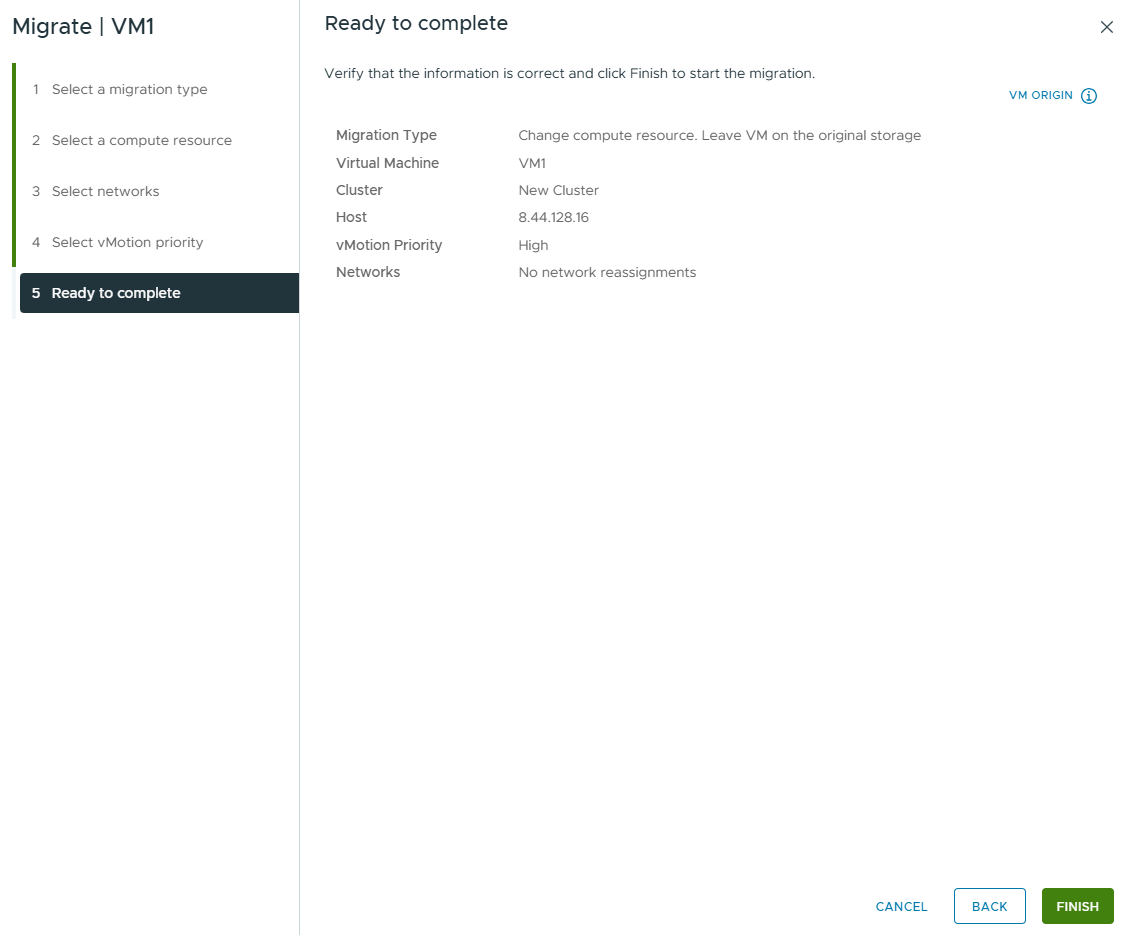Huawei OceanStor NAS Storage and VMware ESXi 9.0
Interoperability Test Report
![]()
Axians Global
All Rights Reserved
Executive Summary
Axians Global (“Axians”) assessed the interoperability of Huawei OceanStor Dorado All-Flash Storage & Huawei OceanStor Hybrid Storage (hereinafter referred to as “the storage” as well) and VMware ESXi 9.0 operating system through NFS.
In the assessment, Axians has determined that VMware ESXi 9.0 operating system will function with Huawei OceanStor Dorado All-Flash Storage & Huawei OceanStor Hybrid Storage for the following scenarios:
Storage Tested | Protocol(s) Tested | Test Scenario | Result |
OceanStor Dorado All-Flash Storage & OceanStor Hybrid Flash Storage | NFSv3 & NFSv4.1 | Basic Connectivity Test | Passed |
Reliability Test | Passed |
1. Environment Configuration
1.1 Networking Diagram
Figure 1.1 Storage and VMware ESXi Compatibility Test Networking
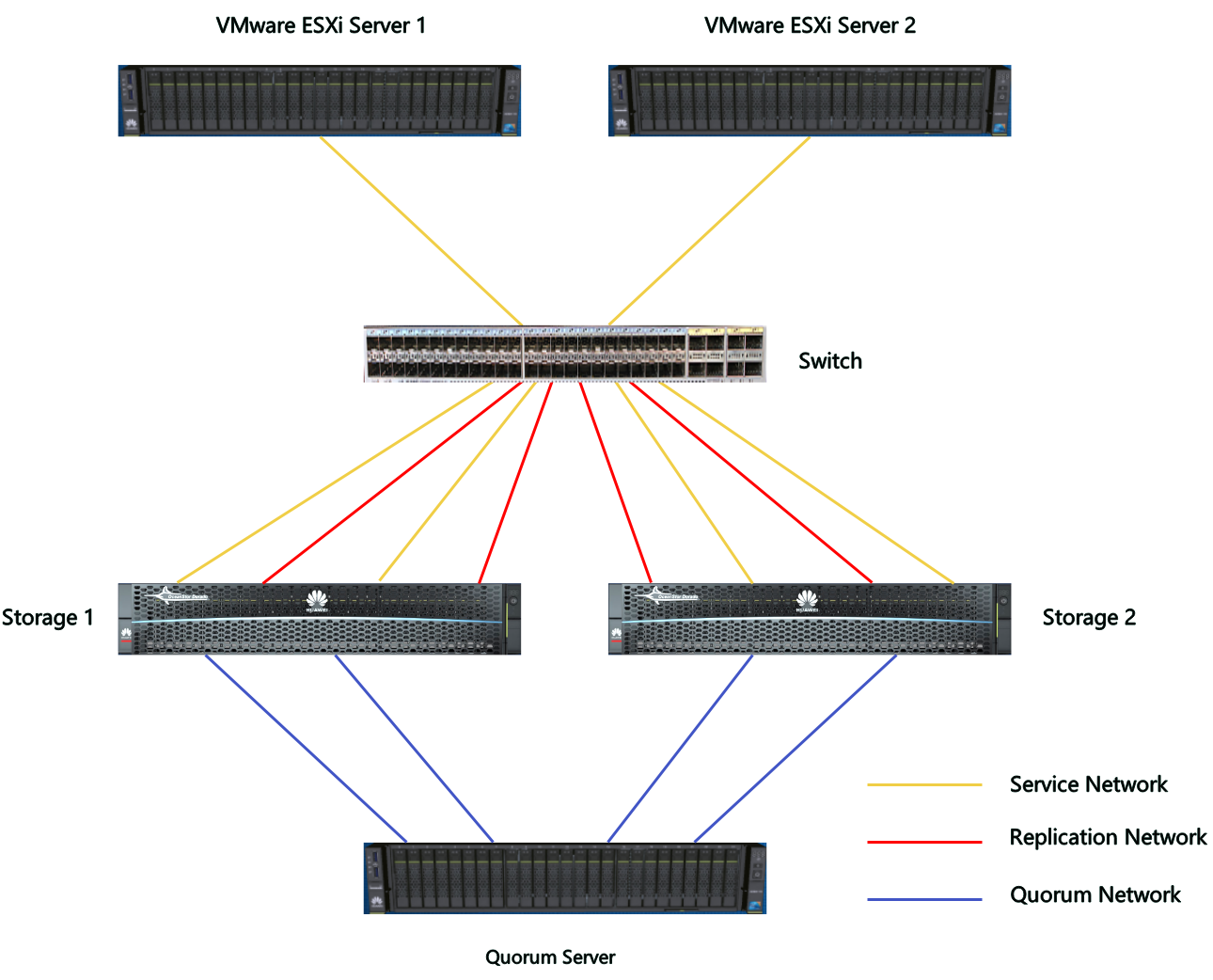
Networking description:
Each host connects one network port to the switch as service network port.
Each storage controller connects two network ports to the switch, one as a service network port connected to the host, and the other as a replication link port connected to the peer storage.
Each controller has a network port configured with an IP to connect to the quorum server network.
1.2 Hardware and Software Configuration
1.2.1 Storage Configuration
Table 1-1 Storage Configuration Table
Name | Description | Quantity |
Storage | OceanStor Dorado All-Flash Storage | 2 |
Storage | OceanStor Hybrid Flash Storage | 2 |
1.2.2 Other Hardware Configuration
Table 1-2 Hardware Configuration
Name | Description | Quantity | Usage |
VMWare ESXi Server |
| 2 | Host Server |
Ethernet Switch | Huawei CE6850 Ethernet Switch | 1 | Service Network Switch |
1.2.3 Test Software and Tools
Table 1-3 Test Software and Tool List
Software Name | Description | Version |
VMware ESXi | VMware Virtualization Platform | 9.0 |
Vdbench | IO Test Tool | 50407 |
Red Hat Enterprise Linux | Virtual Machine | 8.8 |
2. Basic Connectivity Test
2.1 Mount the Share as Datastore
Test Purpose | To Verify That the Storage Share Could Be Mounted and Created as Datastore |
Test Networking | Storage and VMware ESXi Compatibility Test Networking |
Prerequisites | 1.The network is correctly configured according to the network diagram, and the physical links are normal. 2.The host has installed with ESXi operating system. 3.A logical port has been created successfully on the storage. 4.A file system and NFS share has been created successfully on the storage. |
Test Procedure | 1.Create an NFS datastore on the ESXi host. 2.Check the information about the NFS datastore. 3.Unmount the datastore. 4.Recreate an NFS datastore on the ESXi host. |
Expected Result | 1.In step 1, the NFS datastore is created successfully. 2.In step 2, the NFS datastore information is correct. 3.In step 3, the NFS datastore is unmounted successfully. 4.In step 4, the NFS datastore is created successfully. |
Test Record | 1.In step 1, the NFS datastore is created successfully. 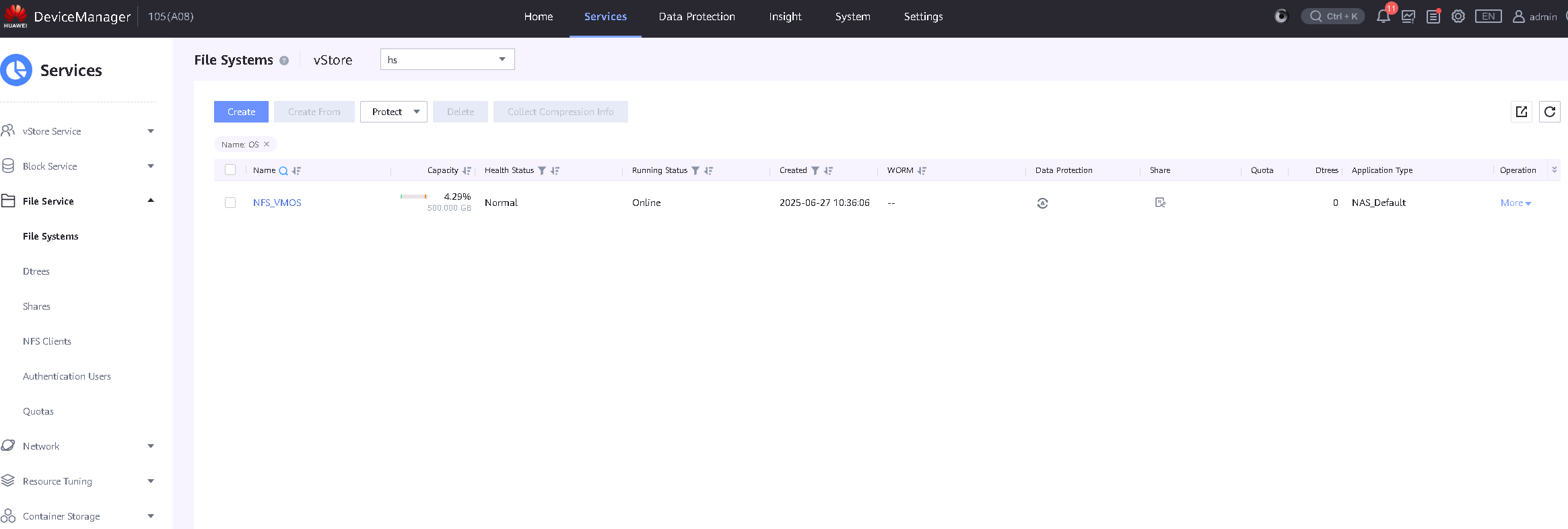
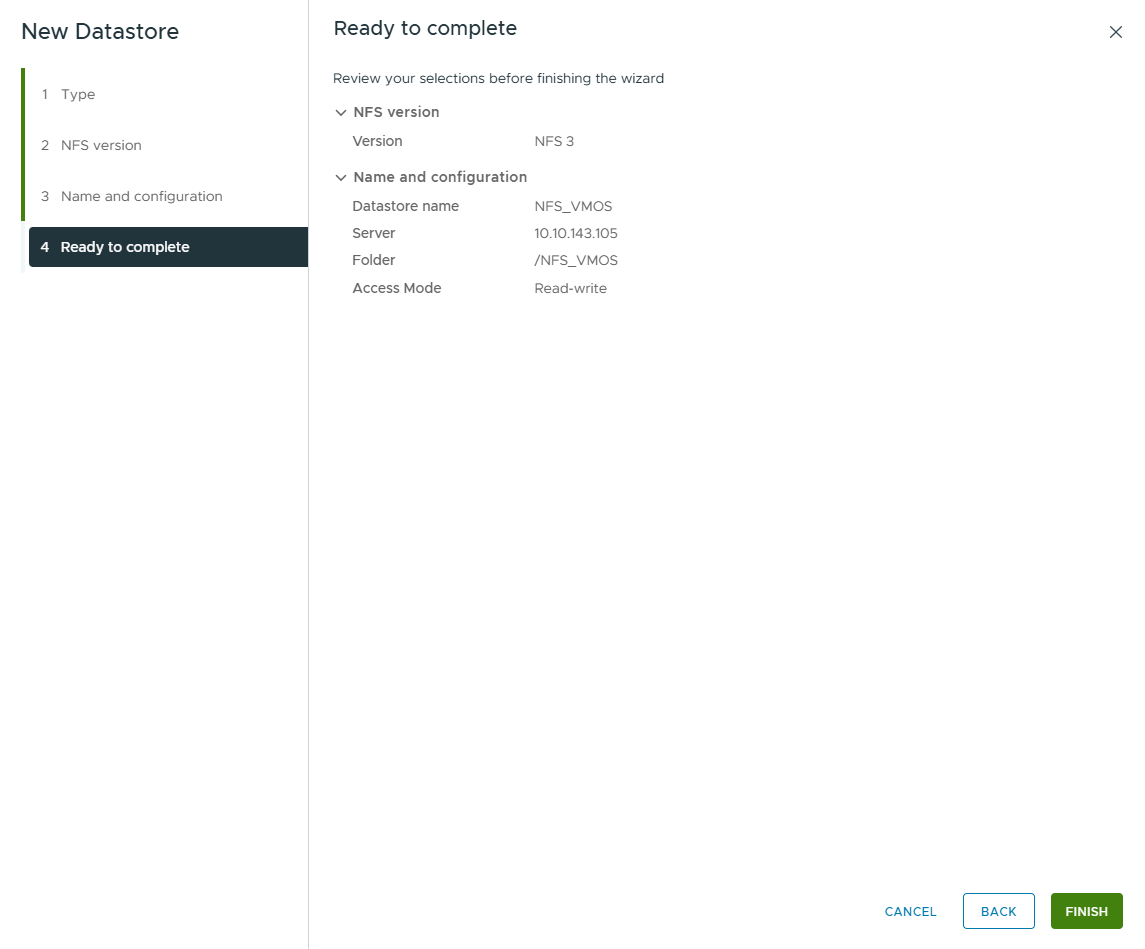

2.In step 2, the NFS datastore information is correct. 
3.In step 3, the NFS datastore is unmounted successfully. 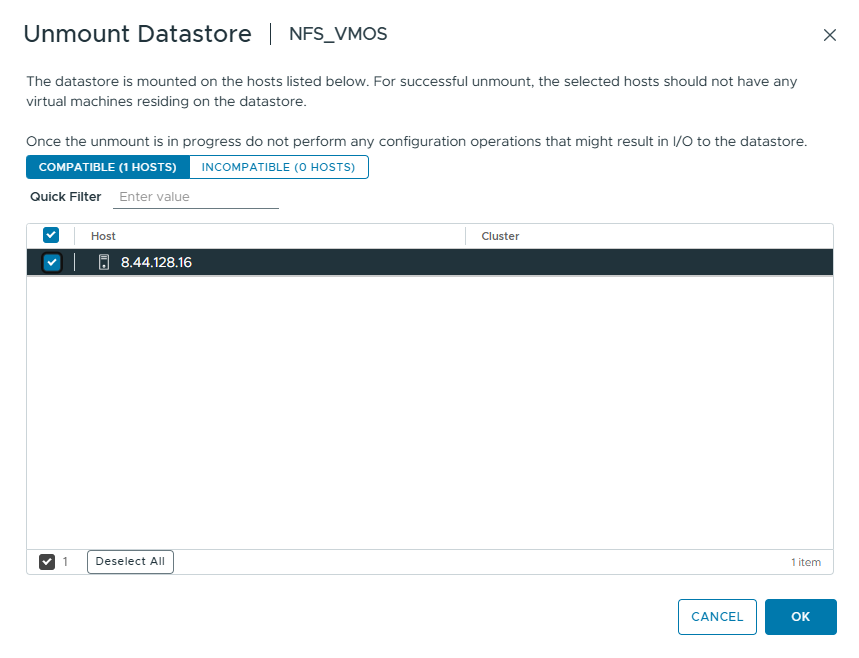

4.In step 4, the NFS datastore is created successfully. 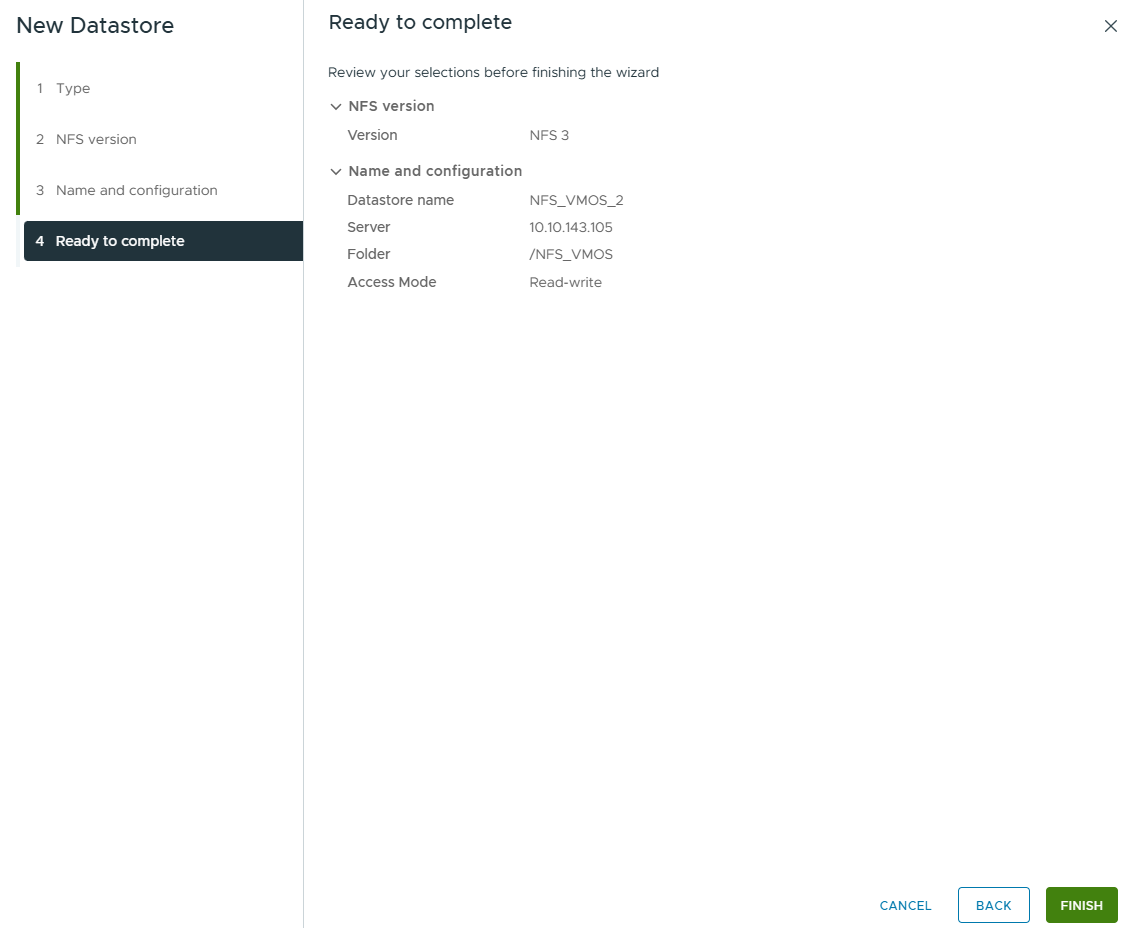

|
Test Conclusion | Passed |
2.2 Virtual Machine Creation and Operation
Test Purpose | To Verify That the Virtual Machine Could Be Created and Operated on the NFS Datastore |
Test Networking | Storage and VMware ESXi Compatibility Test Networking |
Prerequisites | 1.The network is correctly configured according to the network diagram, and the physical links are normal. 2.The host has installed with ESXi operating system. 3.A logical port has been created successfully on the storage. 4.A file system and NFS share has been created successfully on the storage. 5.An NFS datastore has been created on the ESXi host. |
Test Procedure | 1.Create a virtual machine on the NFS datastore and install the operating system on the newly created virtual machine. 2.Perform operations such as power on, power off, suspend, reset, shut down the guest operating system, and restart the guest operating system on the virtual machine. |
Expected Result | 1.In step 1, the virtual machine created successfully and the installation of the guest operating system is completed successfully. 2.In step 2, the related operations are executed successfully. |
Test Record | 1.In step 1, the virtual machine created successfully and the installation of the guest operating system is completed successfully. 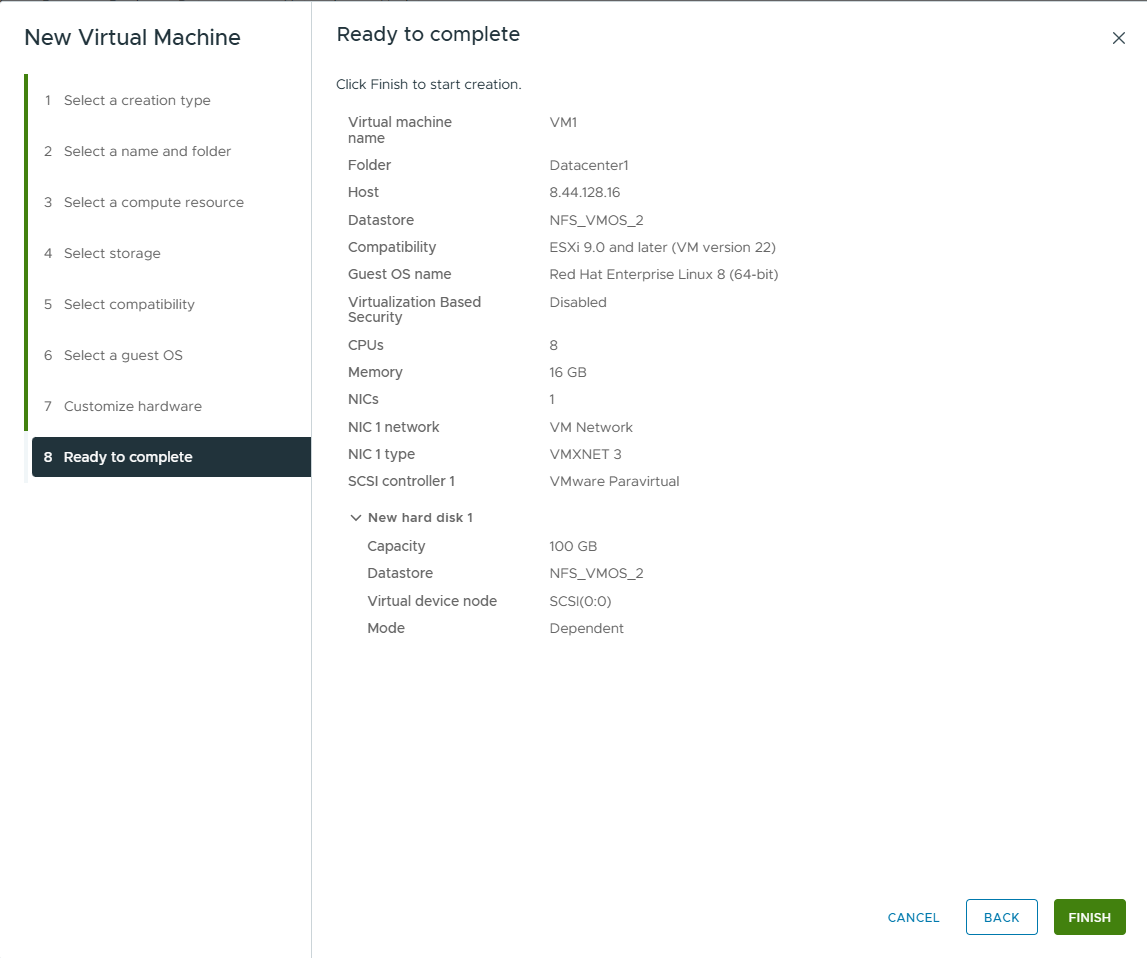

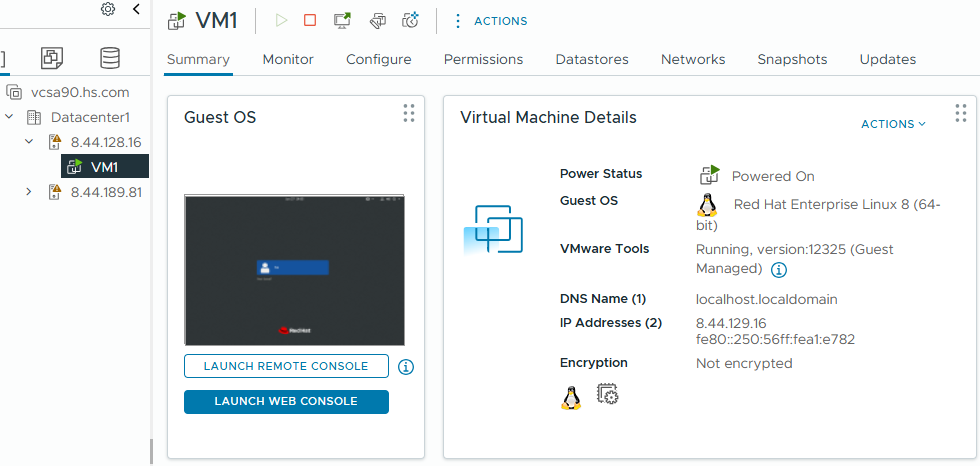
2.In step 2, the related operations are executed successfully, and the virtual machine is normal.
|
Test Conclusion | Passed |
2.3 Support IPv6
Test Purpose | To Verify That the Share Could Be Mount with IPv6 |
Test Networking | Storage and VMware ESXi Compatibility Test Networking |
Prerequisites | 1.The network is correctly configured according to the network diagram, and the physical links are normal. 2.The host has installed with ESXi operating system. 3.A logical port has been created successfully on the storage. 4.A file system and NFS share has been created successfully on the storage. 5.An NFS datastore has been created on the ESXi host. |
Test Procedure | 1.Power off the virtual machine and unmount the NFS datastore. 2.Configure IPv6 for the host and storage, remount the share with IPv6, and power on the virtual machine. |
Expected Result | 1.In step 1, the NFS datastore is unmounted successfully. 2.In step 2, mount the share with IPv6 successfully and the virtual machine is running normally. |
Test Record | 1.In step 1, the NFS datastore is unmounted successfully. 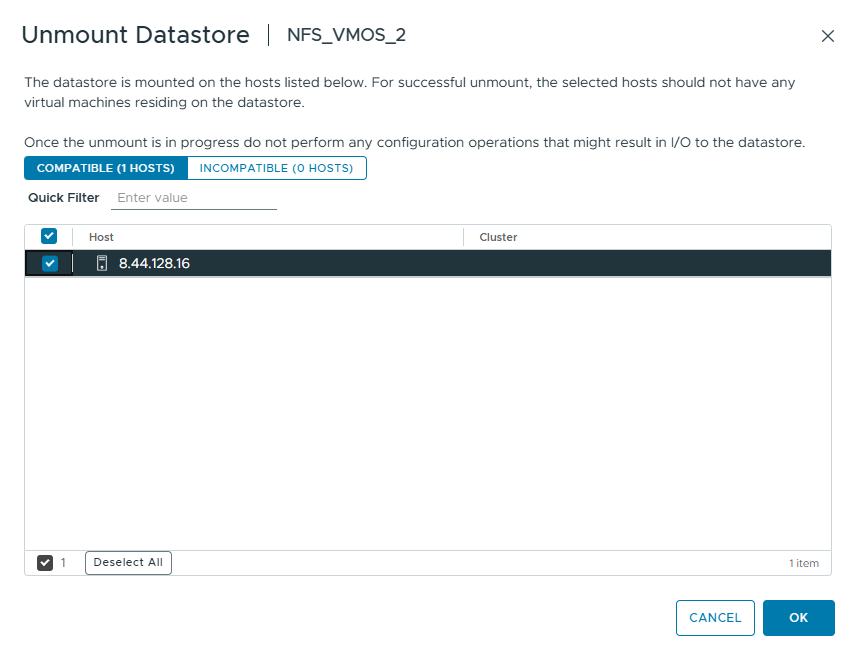
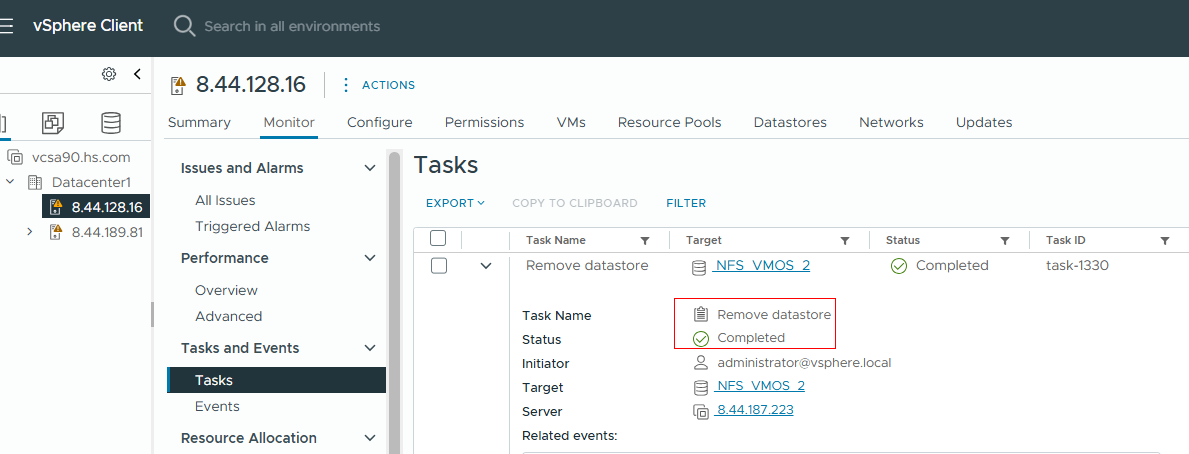
2.In step 2, mount the share with IPv6 successfully and the virtual machine is running normally.

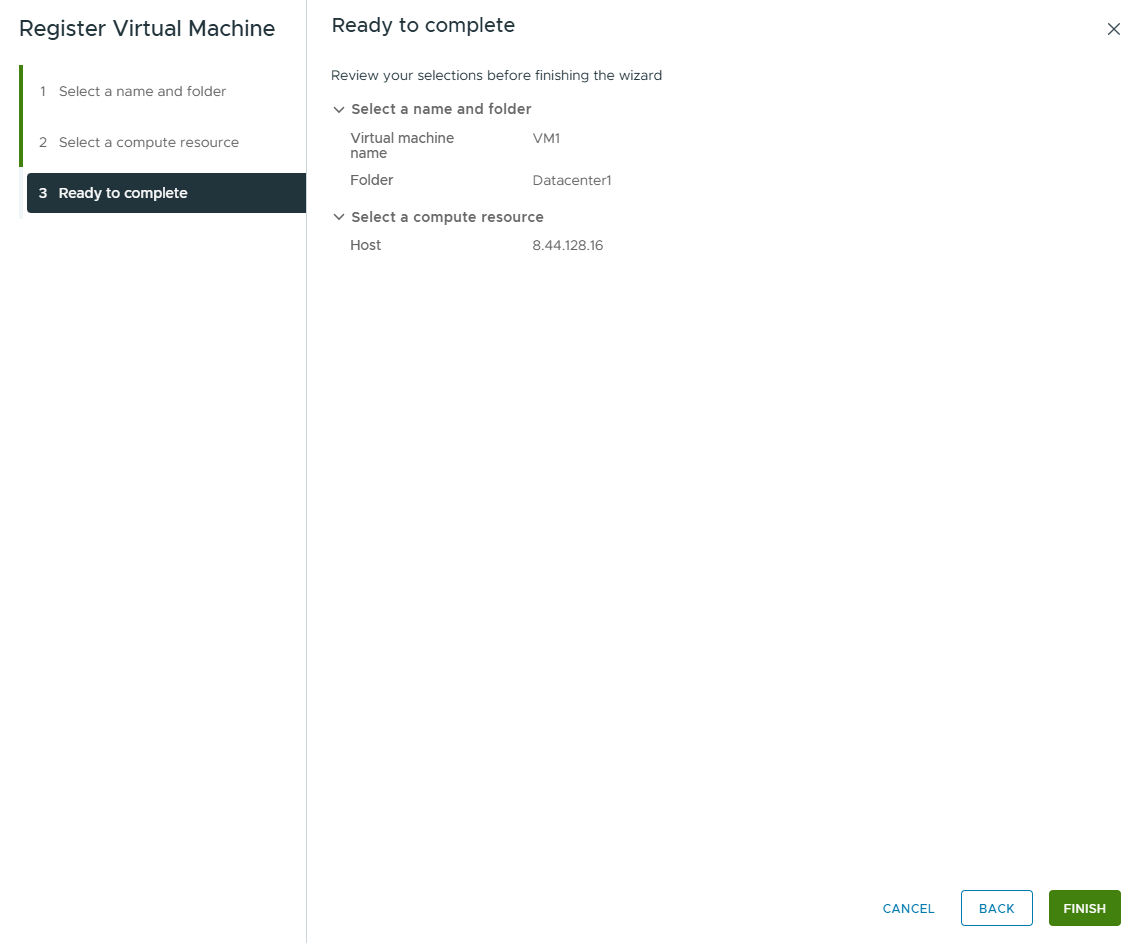

|
Test Conclusion | Passed |
2.4 Online Addition of Virtual Disks to Virtual Machine
Test Purpose | To Verify That Virtual Disks Could Be Added to Virtual Machine and Run I/O Stress |
Test Networking | Storage and VMware ESXi Compatibility Test Networking |
Prerequisites | 1.The network is correctly configured according to the network diagram, and the physical links are normal. 2.The host has installed with ESXi operating system. 3.A logical port has been created successfully on the storage. 4.A file system and NFS share has been created successfully on the storage. 5.An NFS datastore has been created on the ESXi host. |
Test Procedure | 1.Add two virtual data disks to the virtual machine. 2.Run raw disk I/O stress on disk1, create file system and run I/O stress on disk2, observing the I/O status. |
Expected Result | 1.In step 1, the virtual data disks could be added to virtual machine successfully. 2.In step 2, the I/O stress is running normally on raw disk and file system. |
Test Record | 1.In step 1, the virtual data disks could be added to virtual machine successfully. 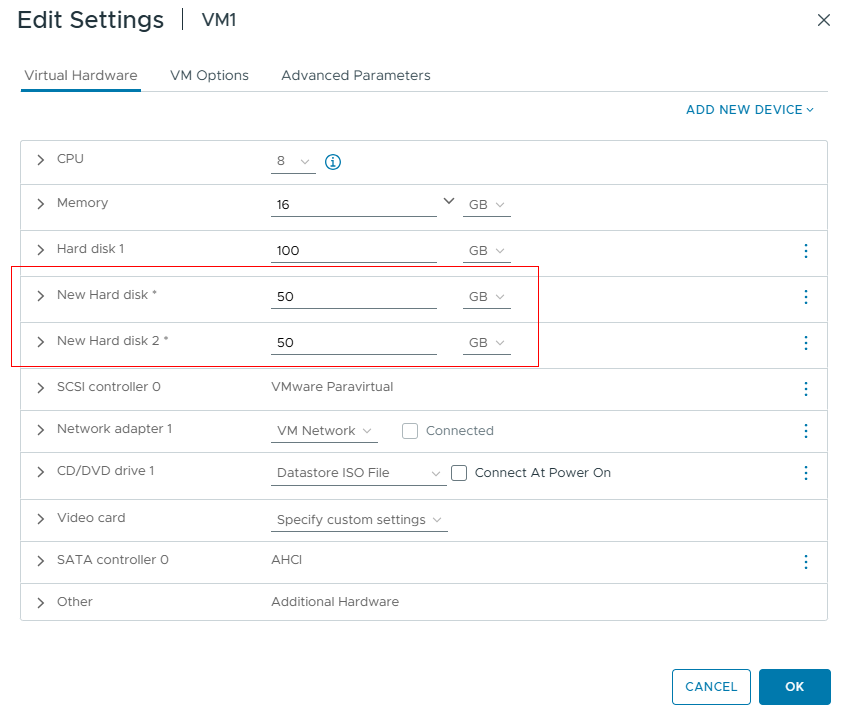

2.In step 2, the I/O stress is running normally on raw disk and file system. 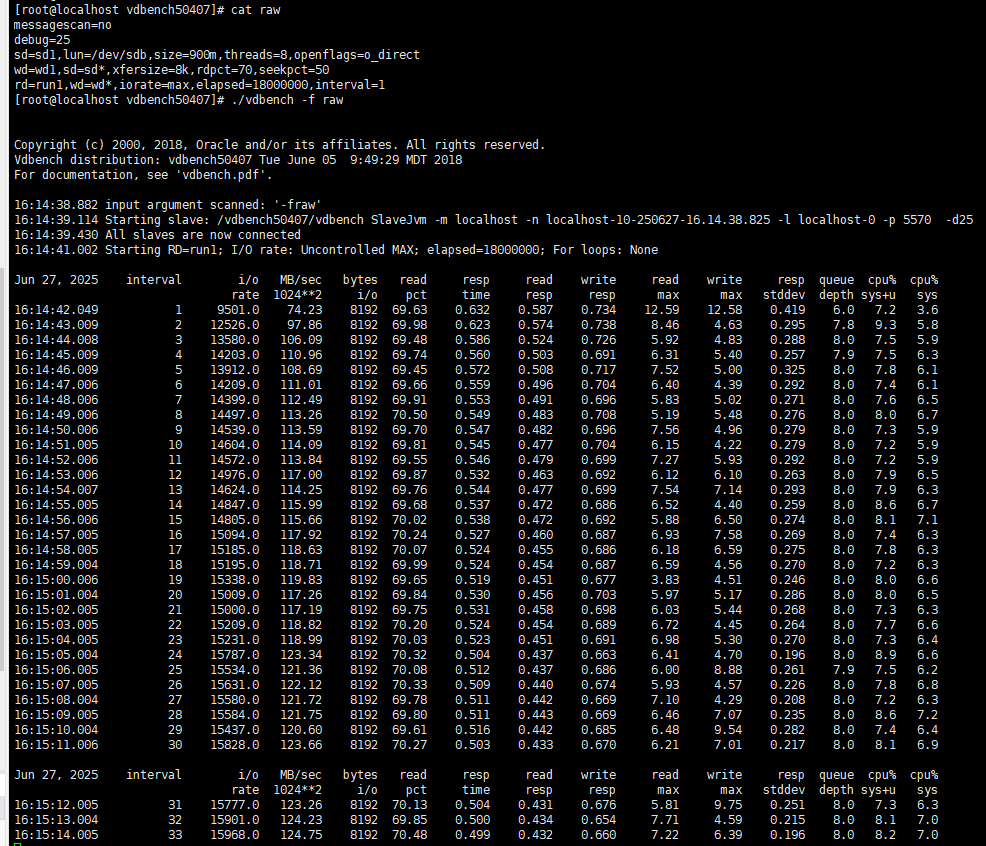
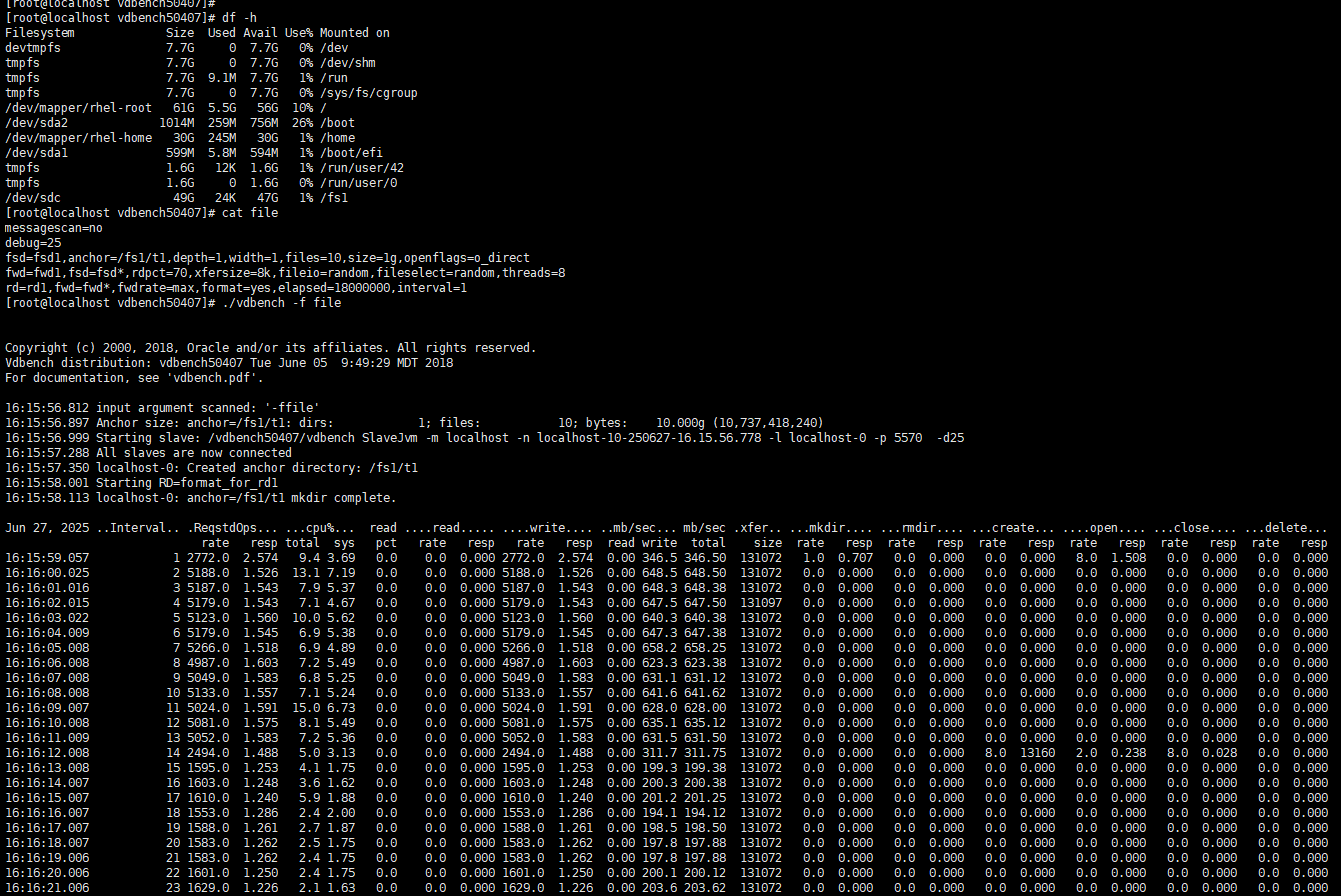
|
Test Conclusion | Passed |
2.5 Online Expansion of Virtual Disk
Test Purpose | To Verify That the Virtual Disk of Virtual Machine Could Be Expanded Online |
Test Networking | Storage and VMware ESXi Compatibility Test Networking |
Prerequisites | 1.The network is correctly configured according to the network diagram, and the physical links are normal. 2.The host has installed with ESXi operating system. 3.A logical port has been created successfully on the storage. 4.A file system and NFS share has been created successfully on the storage. 5.An NFS datastore has been created on the ESXi host. 6.The virtual disks has been added to the virtual machine. |
Test Procedure | 1.Run raw disk I/O stress on disk1, create file system and run I/O stress on disk2. 2.Expand the capacity of disk1, observe the I/O stress and capacity of virtual disk in the virtual machine. 3.Expand the capacity of disk2, expand the file system in the virtual machine 4.Observe the I/O stress. |
Expected Result | 1.In step 2, the capacity of raw disk grown normally, and the I/O stress is unaffected. 2.In step 3, the capacity of file system grown normally. 3.In step 4, the I/O stress is unaffected. |
Test Record | 1.In step 2, the capacity of raw disk grown normally, and the I/O stress is unaffected. 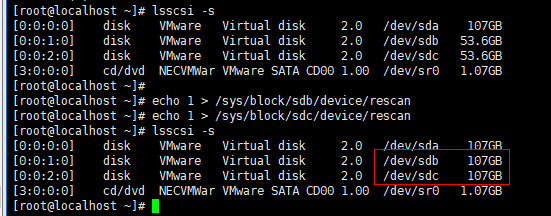
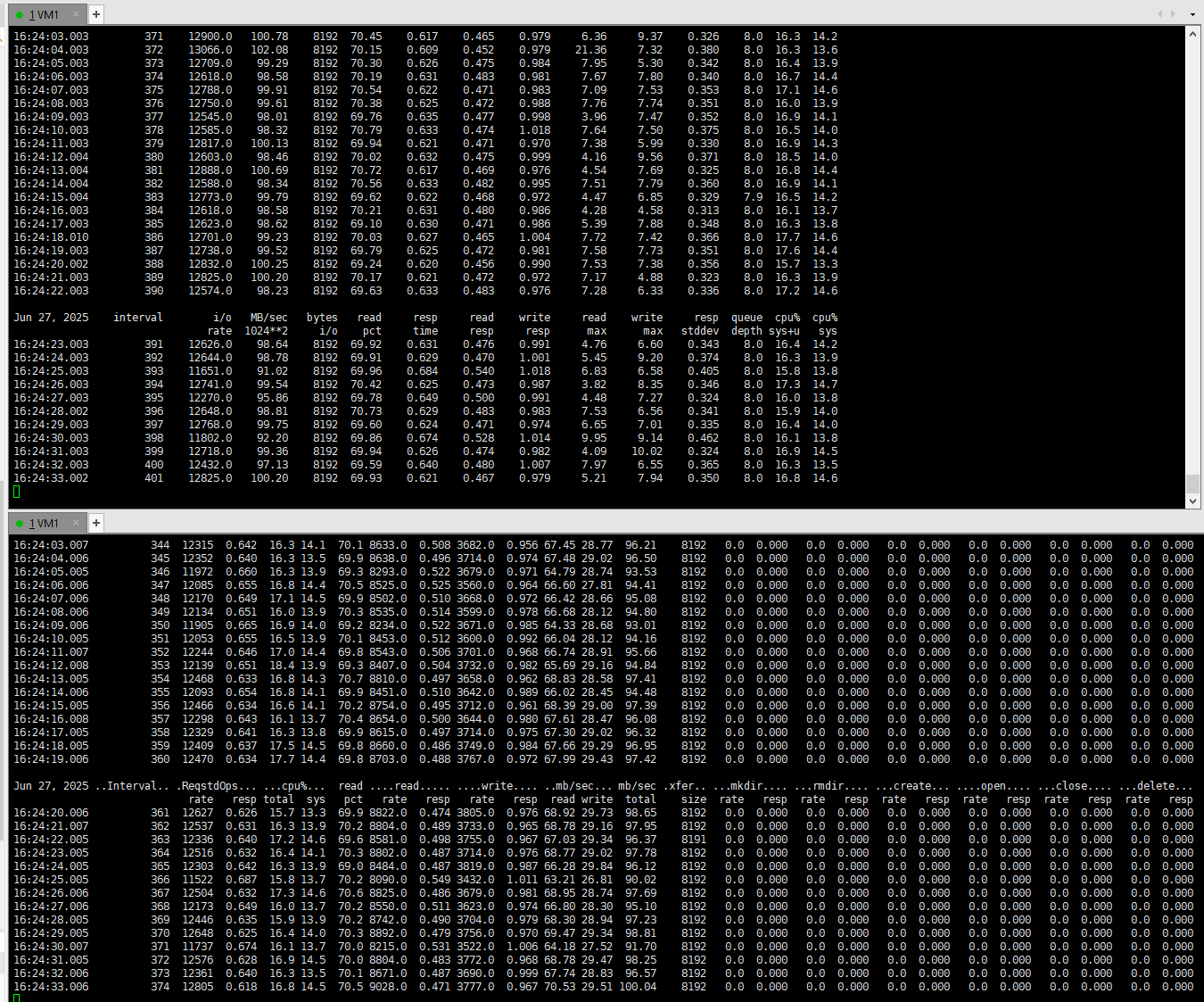
2.In step 3, the capacity of file system grown normally. 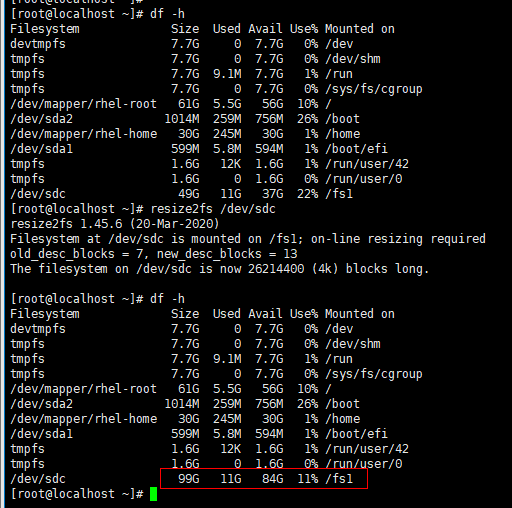
3.In step 4, the I/O stress is unaffected. 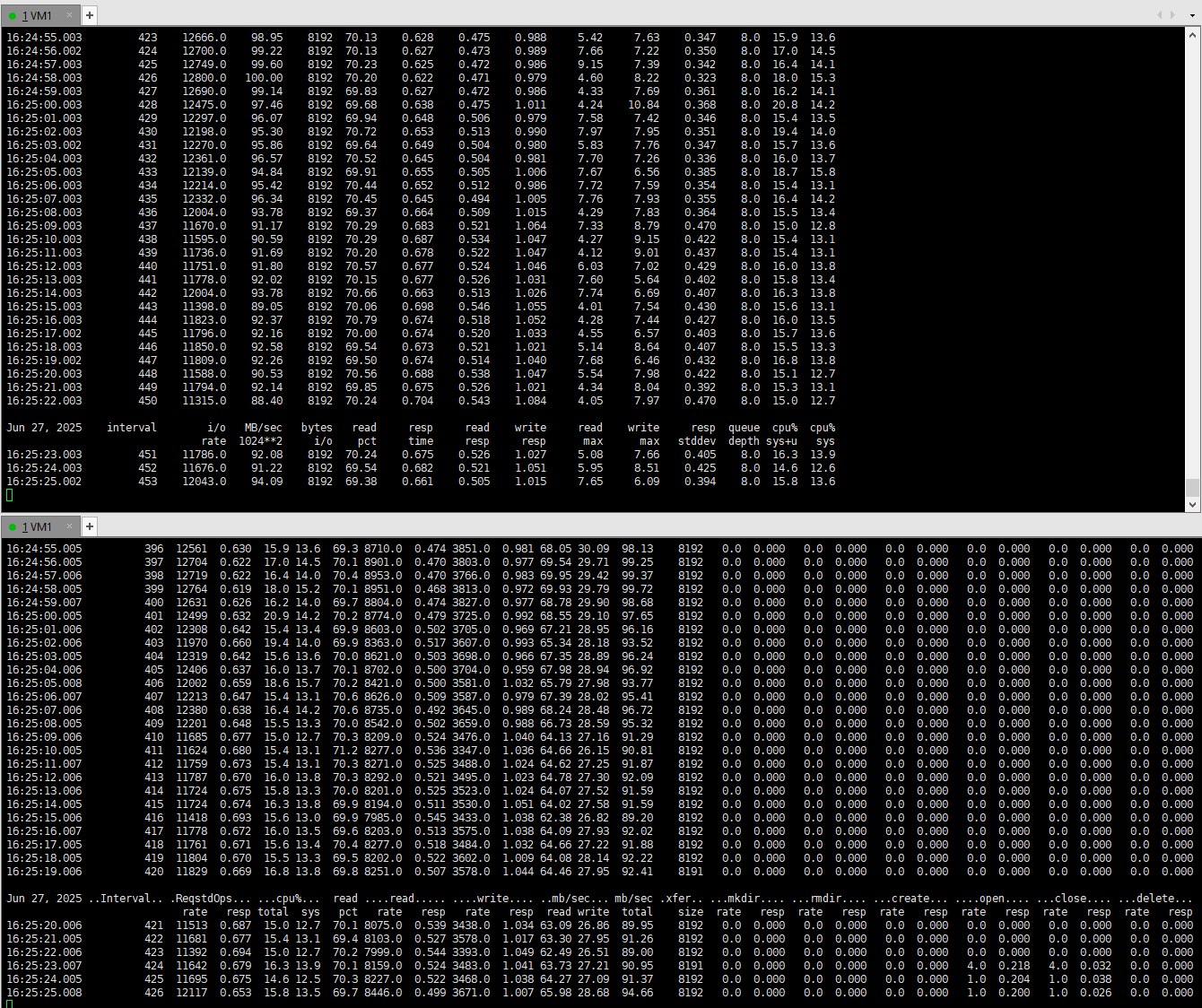
|
Test Conclusion | Passed |
2.6 Change IP Address of The Logical Port with Kerberos Enabled
Test Purpose | To Verify That After Changing the IP Address of Logical Port the Datastore Could Be Mounted Normally. |
Test Networking | Storage and VMware ESXi Compatibility Test Networking |
Prerequisites | 1.The network is correctly configured according to the network diagram, and the physical links are normal. 2.The host has installed ESXi operating system. 3.A logical port has been created successfully on the storage. 4.A file system and NFS share has been created successfully on the storage. 5.The kerberos is correctly configured and the ESXi host and logical port of storage have been added to KDC successfully. 6.The virtual disks has been added to the virtual machine. |
Test Procedure | 1.Power off the virtual machine and unmount the datastore. 2.Change the IP address of storage logical port. 3.Mount the datastore again, and power on the virtual machine. |
Expected Result | 1.In step 1, the datastore could be unmount successfully. 2.In step 2, the IP address of storage logical port changed successfully. 3.In step 3, the datastore could be mounted successfully and the virtual machine could be powered on successfully. |
Test Record |
1.In step 1, the datastore could be unmount successfully.


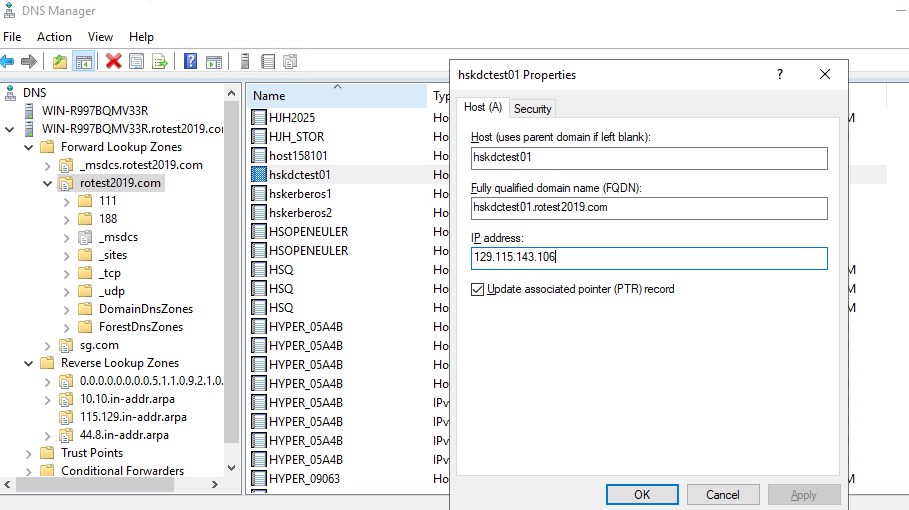
2.In step 2, the IP address of storage logical port changed successfully.
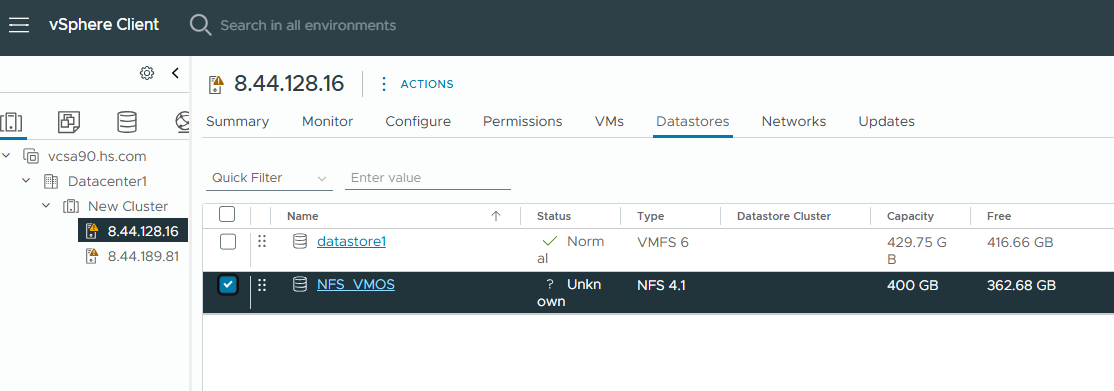
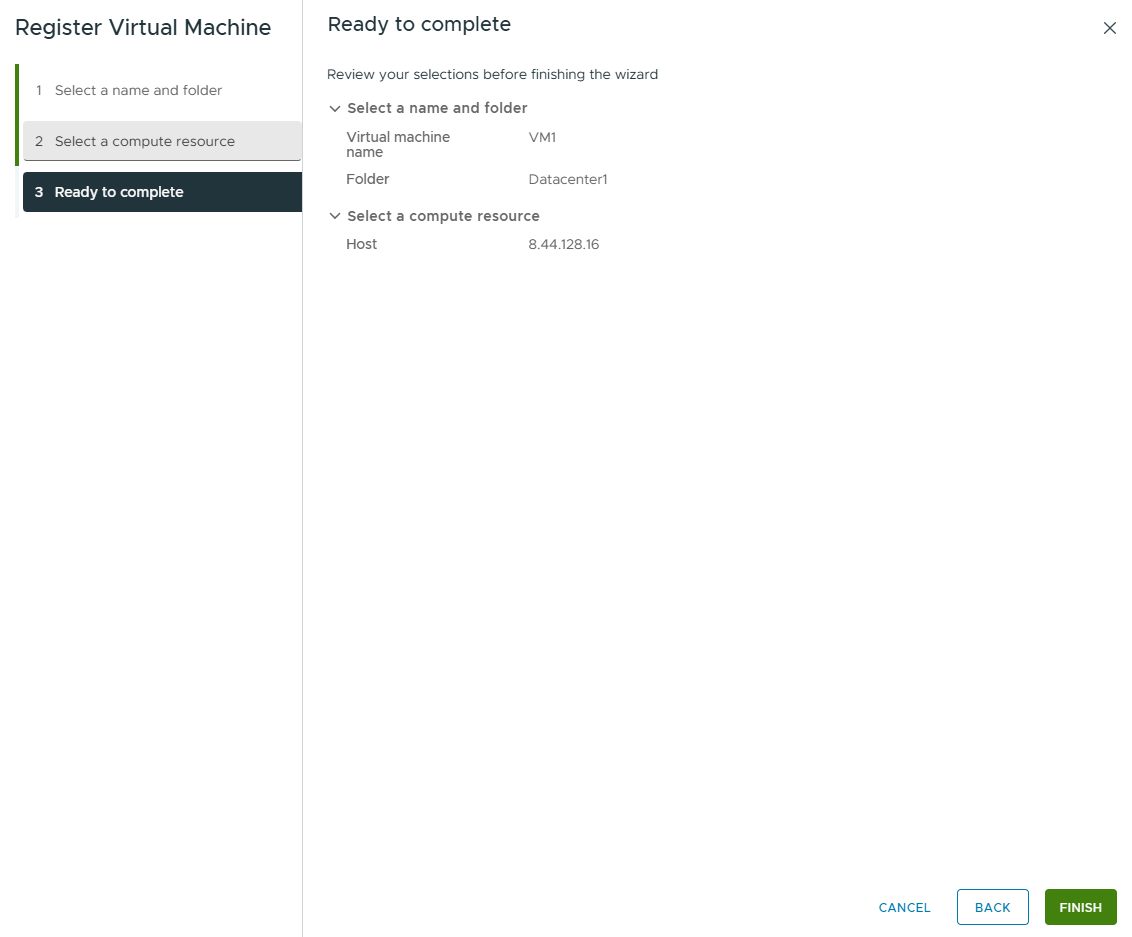
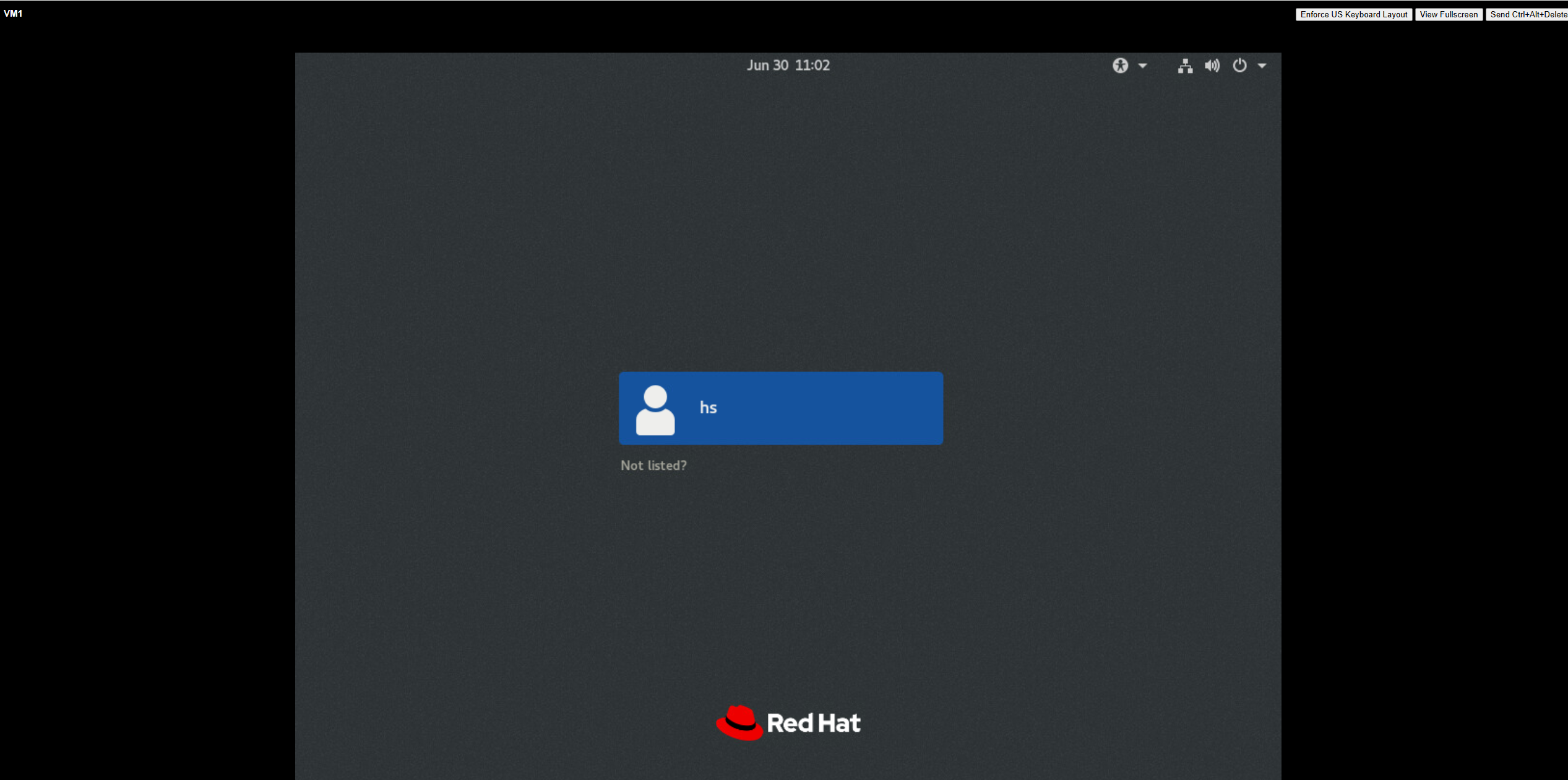
3.In step 3, the datastore could be mounted successfully and the virtual machine could be powered on successfully. 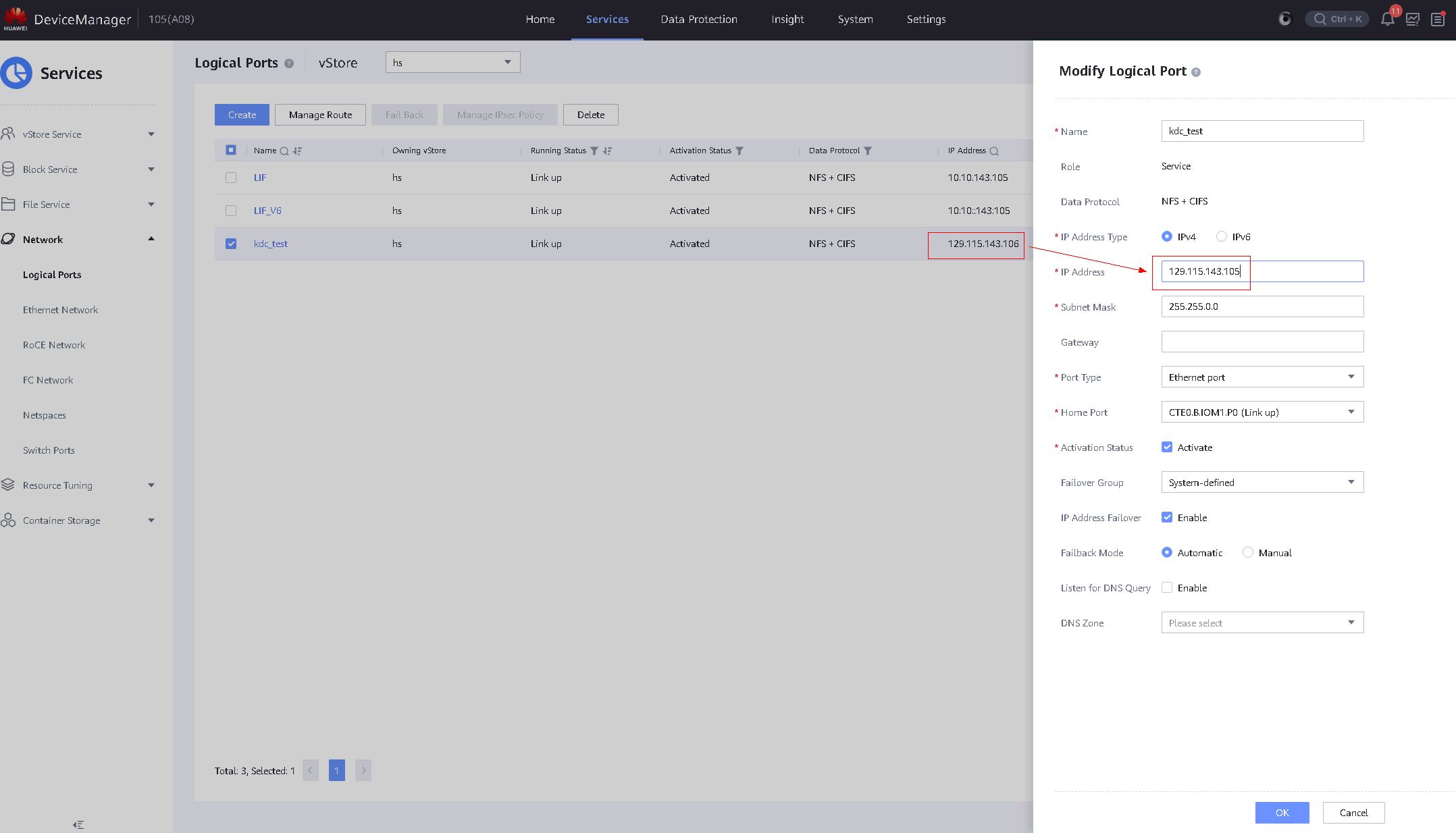
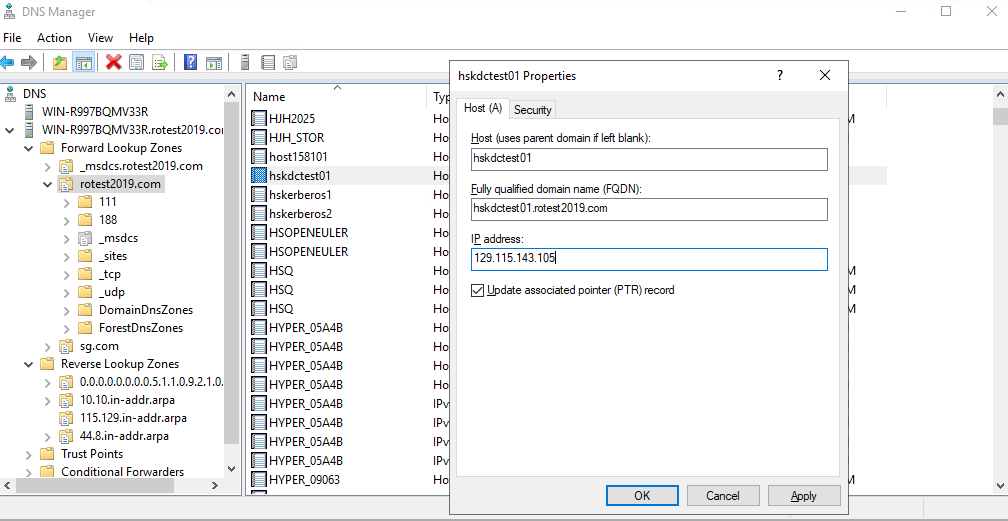
4.In step 4, the share is mounted successfully and the virtual machine is running normally 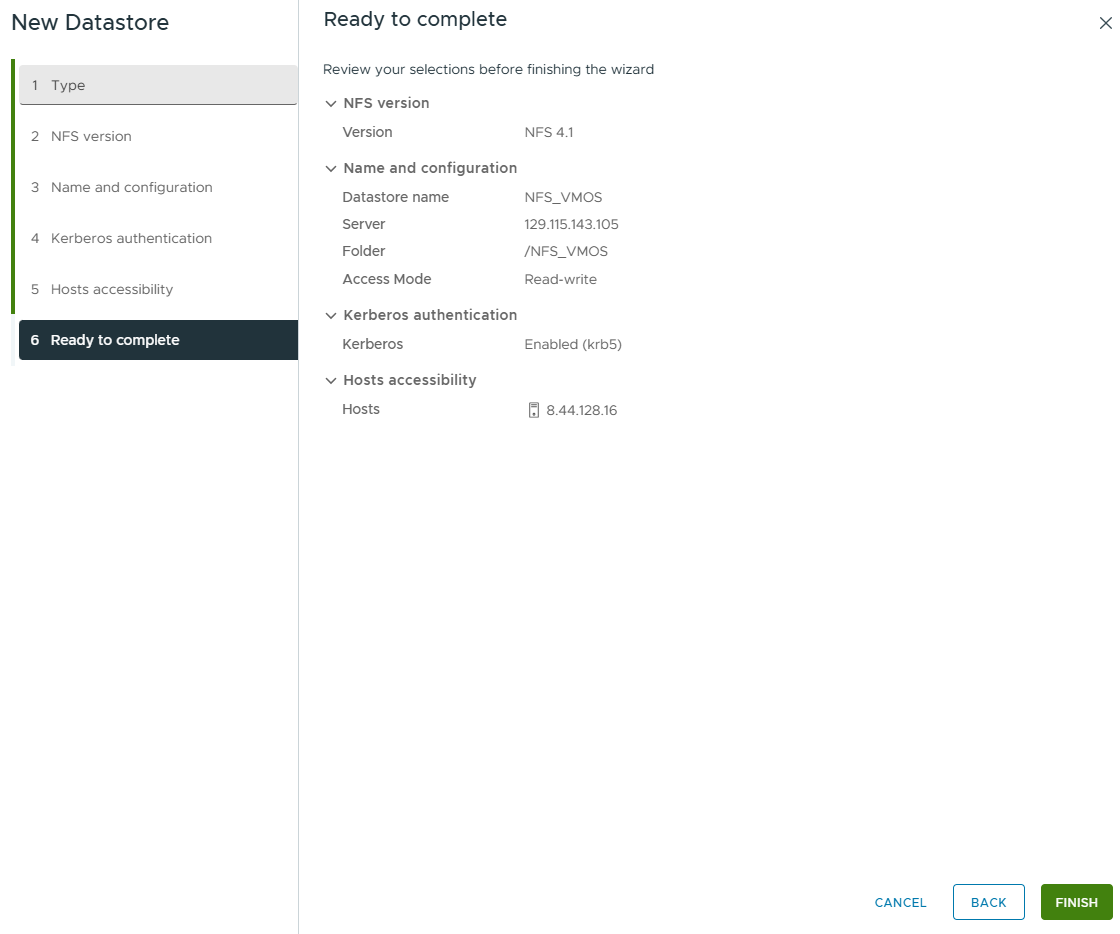

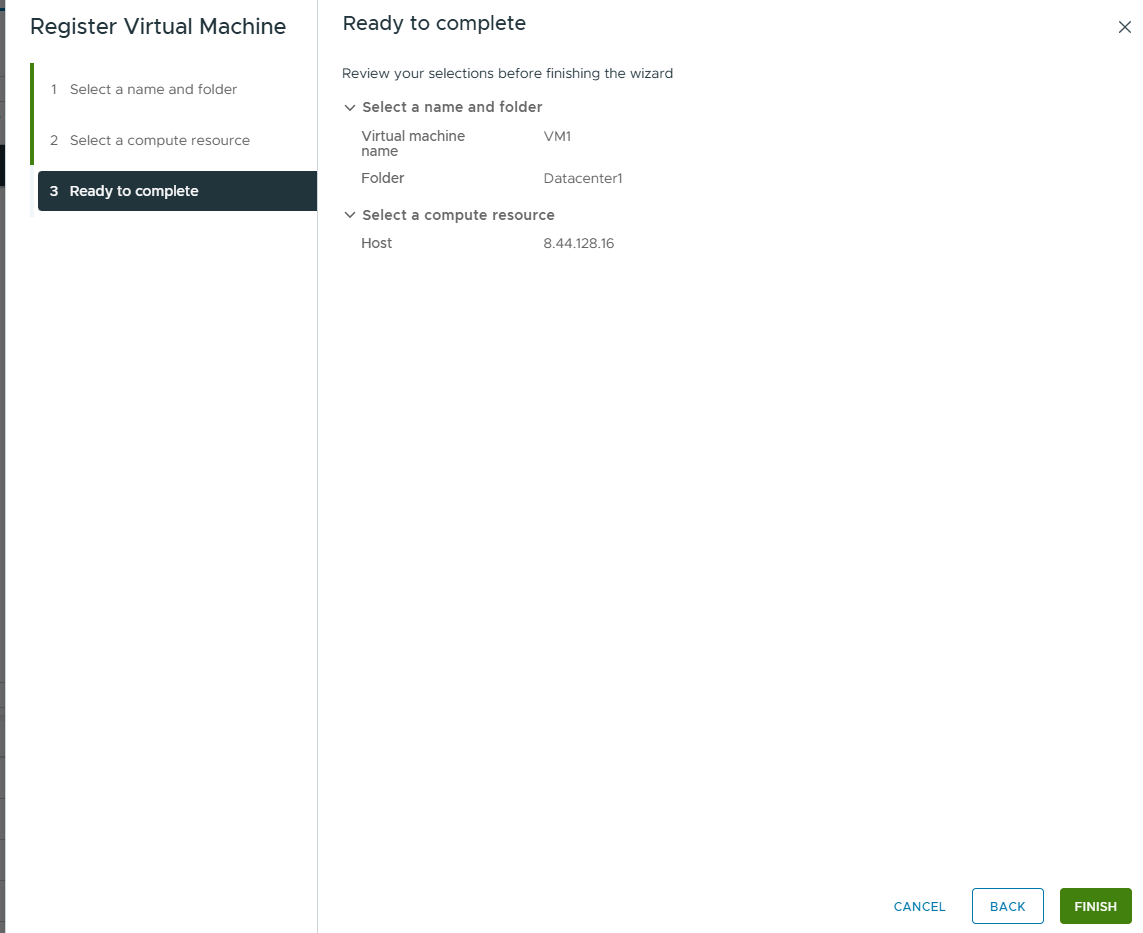
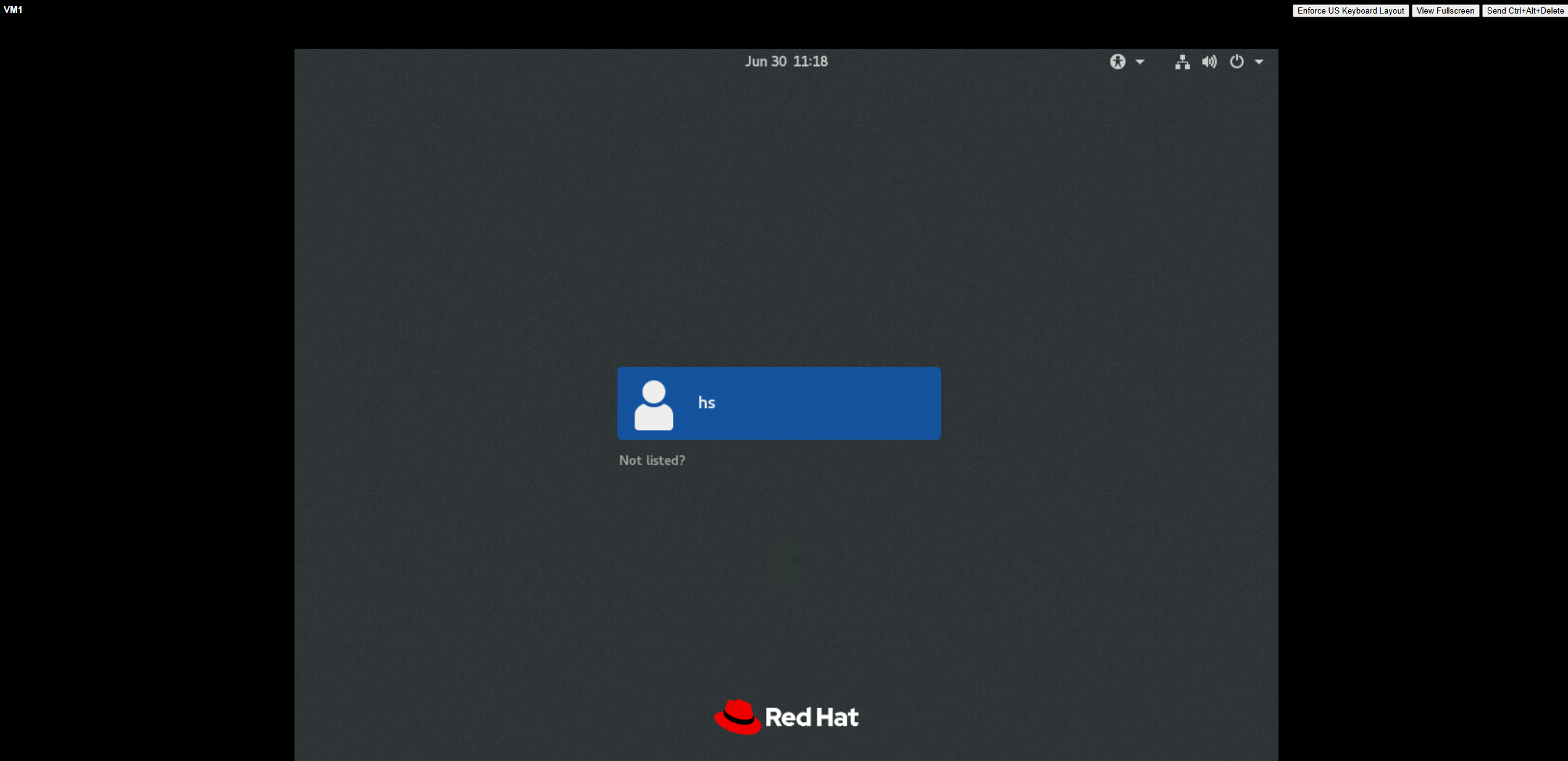
|
Test Conclusion | Passed |
2.7 Clone Virtual Machine with VAAI-NAS Enabled
Test Purpose | To Verify That Virtual Machine Could Be Cloned Successfully Through VAAI-NAS Full Clone |
Test Networking | Storage and VMware ESXi Compatibility Test Networking |
Prerequisites | 1.The network is correctly configured according to the network diagram, and the physical links are normal. 2.The host has installed with ESXi operating system. 3.A logical port has been created successfully on the storage. 4.A file system and NFS share has been created successfully on the storage. 5.An NFS datastore has been created on the ESXi host. 6.A template VM has been pre-configuerd on Datastore. 7.VAAI-NAS plug-in is installed on the ESXi host, and VAAI-NAS is enabled on the storage. 8.The snapshot.alwaysAllowNative parameter of the virtual machine is set to TRUE |
Test Procedure | 1.Run I/O stress in the source virtual machine (with snapshot created). 2.Clone the source virtual machine, set the destination storage to the same datastore. 3.Power on the cloned virtual machine, and run I/O stress in the cloned virtual machine. |
Expected Result | 1.In step 1, the I/O stress is running normally. 2.In step 2, the virtual machine is cloned successfully, and the fullclone task on the storage is completed normally. 3.In step 3, the cloned virtual machine is powered on successfully, and the I/O stress is running normally. |
Test Record |
1.In step 1, the I/O stress is running normally.
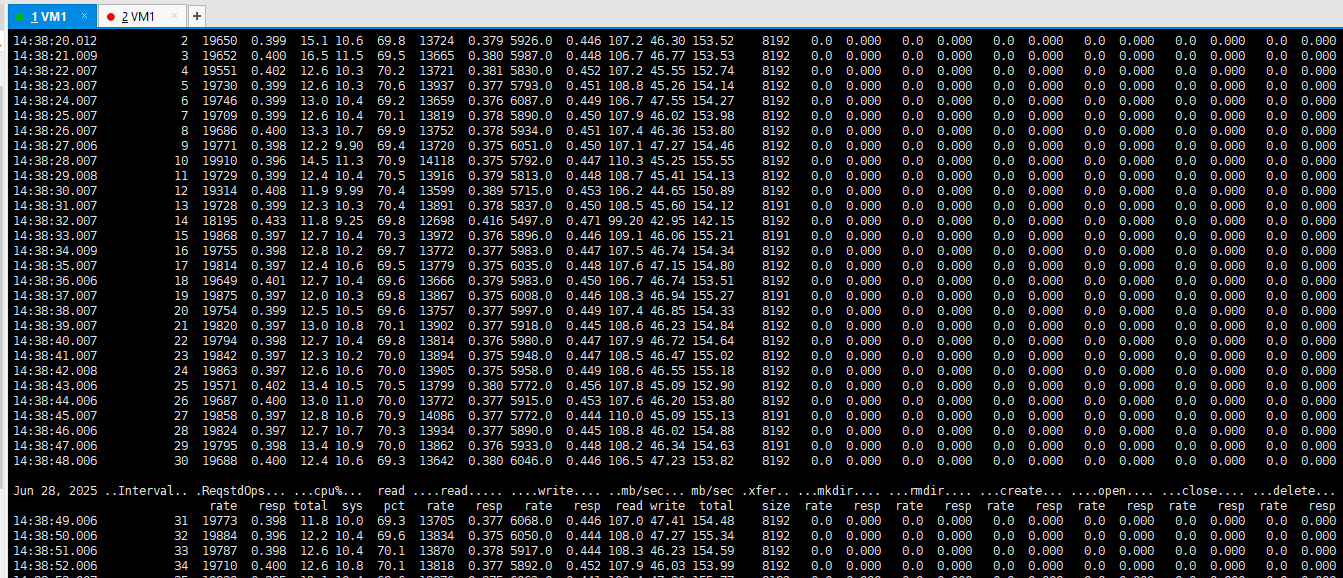
2.In step 2, the virtual machine is cloned successfully, and the fullclone task on the storage is completed normally. 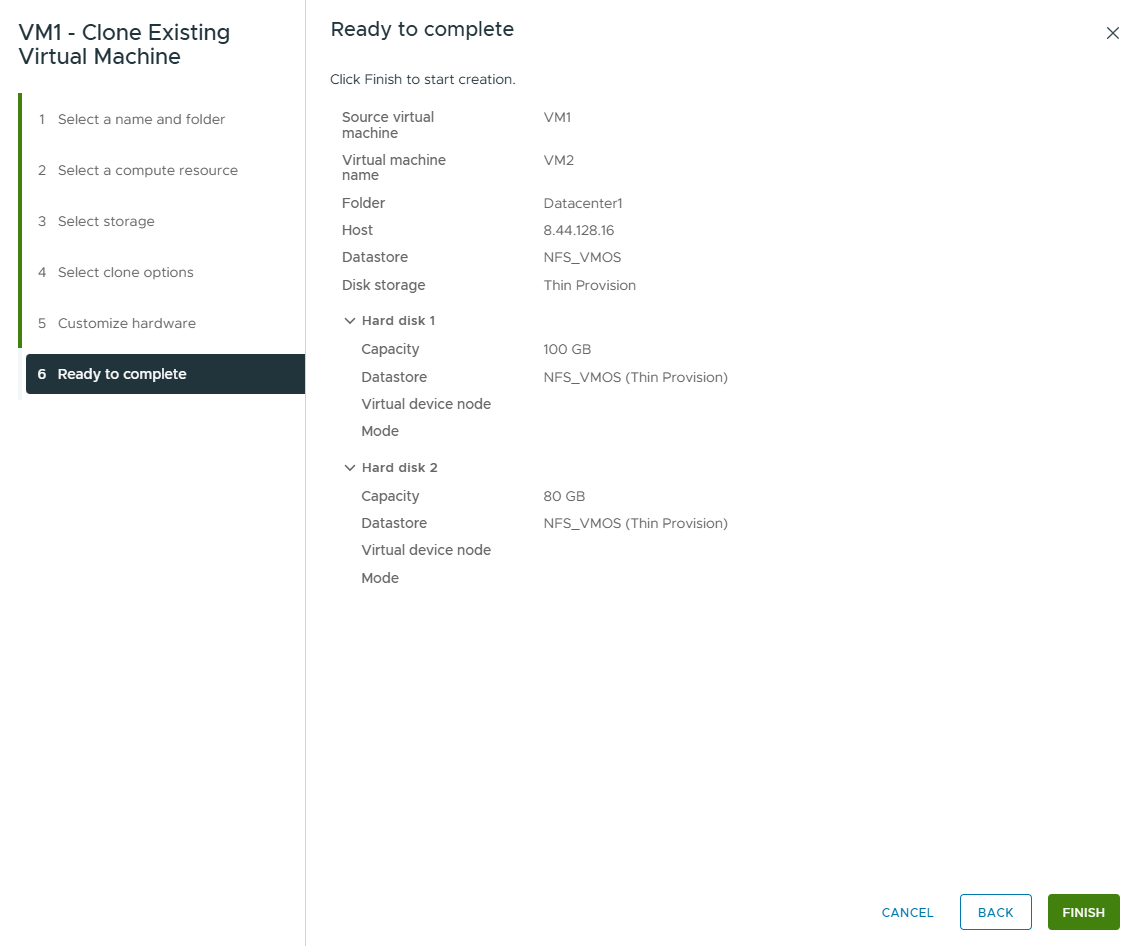
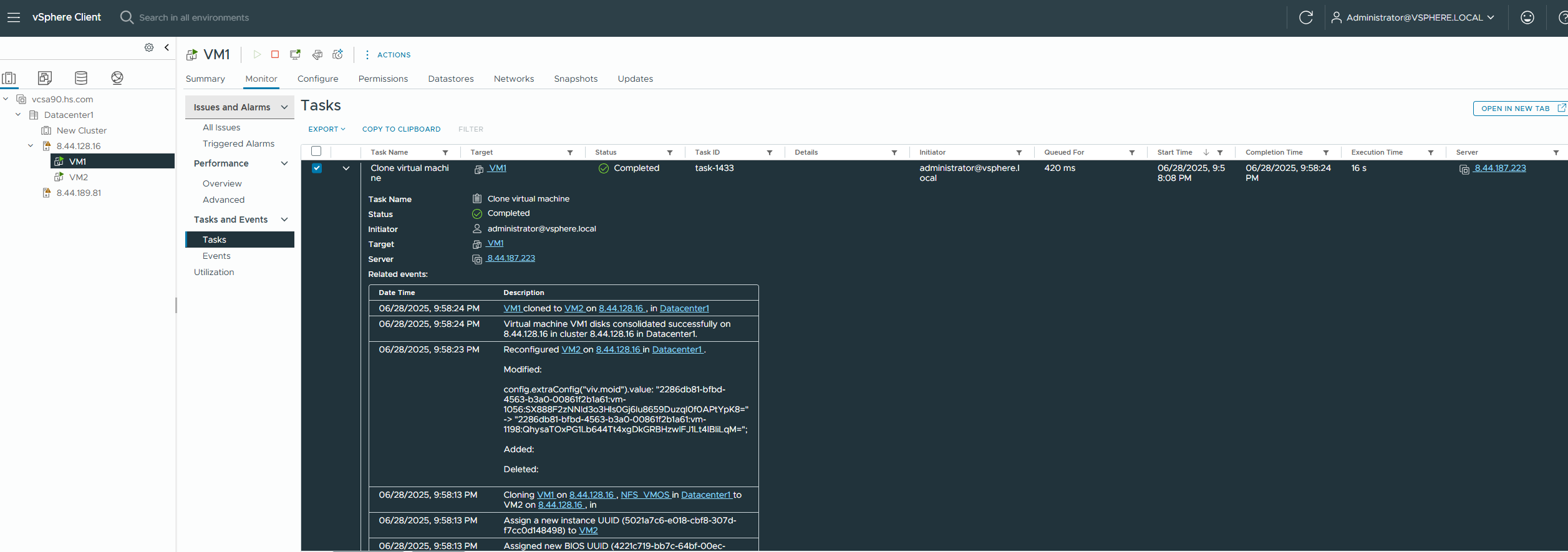
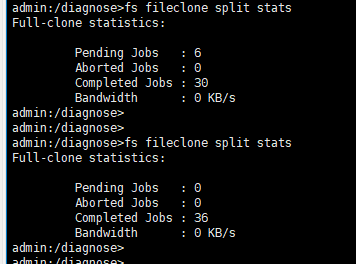
3.In step 3, the cloned virtual machine is powered on successfully, and the I/O stress is running normally.
|
Test Conclusion | Passed |
2.8 Migrate Virtual Machine with VAAI-NAS Enabled
Test Purpose | To Verify That Virtual Machine Could Be Migrated Successfully Through VAAI-NAS Full Clone |
Test Networking | Storage and VMware ESXi Compatibility Test Networking |
Prerequisites | 1.The network is correctly configured according to the network diagram, and the physical links are normal. 2.The host has installed with ESXi operating system. 3.A logical port has been created successfully on the storage. 4.Two file systems and NFS shares have been created successfully on the storage. 5.Two NFS datastores have been created on the ESXi host. 6.Source virtual machine is pre-configured in datastore1. 7.VAAI-NAS plug-in is installed on the ESXi host, and VAAI-NAS is enabled on the storage. 8.Source virtual machine is powered off. |
Test Procedure | 1.Migrate the virtual machine to datastore2, select migrate both compute resource and storage. 2.Observe the space occupation of datastore2 and file system on the storage. |
Expected Result | 1.In step 1, the virtual machine is migrated successfully, and the fullclone task on the storage is completed normally. 2.In step 2, the space occupation of datastore2 and file system on the storage is normal. |
Test Record | 1.In step 1, the virtual machine is migrated successfully, and the fullclone task on the storage is completed normally. 
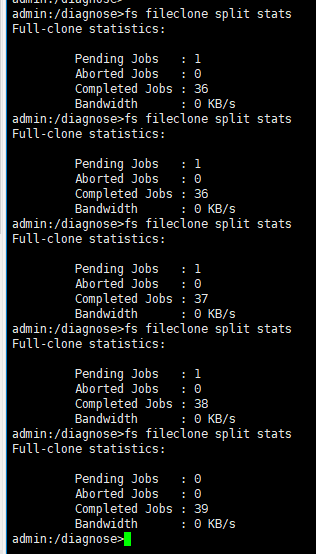
2.In step 2, the space occupation of datastore2 and file system on the storage is normal.
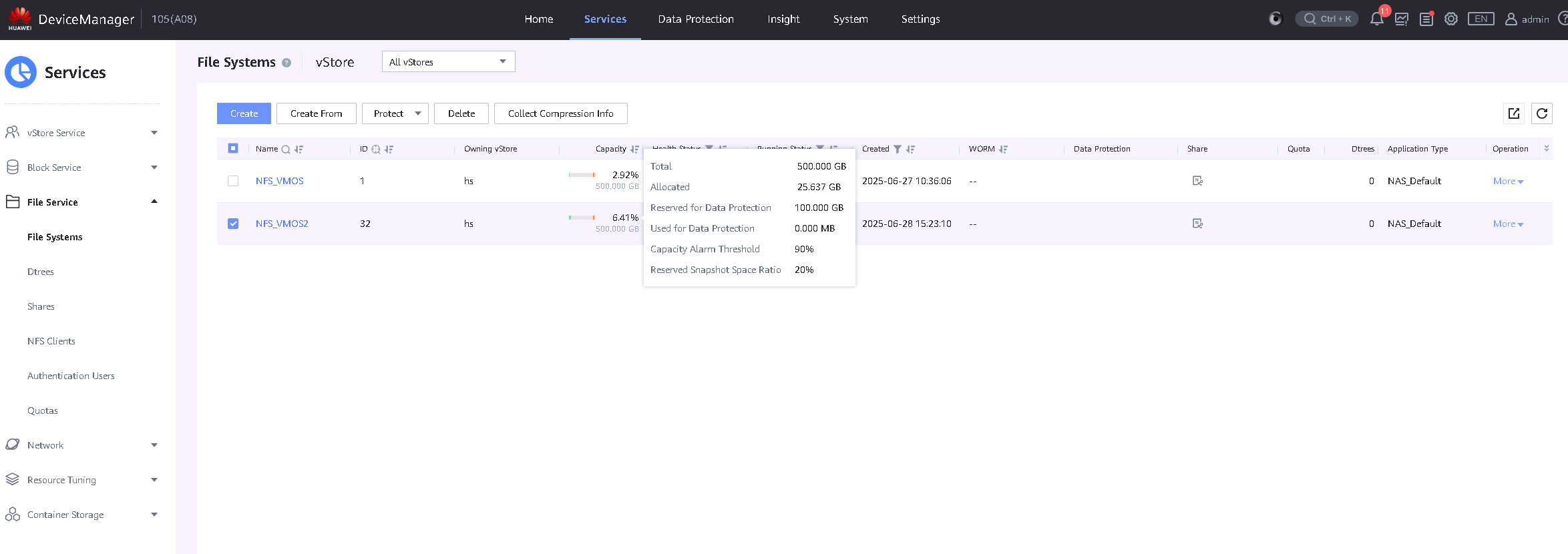
|
Test Conclusion | Passed |
2.9 Snapshot Creation and Reversion with VAAI-NAS Enabled
Test Purpose | To Verify That Snapshots Could Be Created and Reverted Successfully |
Test Networking | Storage and VMware ESXi Compatibility Test Networking |
Prerequisites | 1.The network is correctly configured according to the network diagram, and the physical links are normal. 2.The host has installed ESXi operating system. 3.A logical port has been created successfully on the storage. 4.A file system and NFS share has been created successfully on the storage. 5.An NFS datastore has been created on the ESXi host. 6.A template VM has been pre-configuerd on Datastore. 7.VAAI-NAS plug-in is installed on the ESXi host, and VAAI-NAS is enabled on the storage. 8.Source virtual machine is powered on. |
Test Procedure | 1.Create a snapshot of a virtual machine without memory. 2.Observe the value of the lazyclone parameter for snapshot files and source files. 3.Check that the IO operations of the virtual machine are normal. 4.Revert the snapshot. |
Expected Result | 1.In step 1, the creation is successful and the record creation snapshot time is as expected. 2.In step 2, the values of the lazyclone parameter for the snapshot file and the source file are as expected. 3.In step 3, IO operations of the VM are normal. 4.In step 4, snapshot recovery is successful, and the virtual machine files are in the same state as they were when the snapshot was rolled back. |
Test Record | 1.In step 1, the creation is successful and the record creation snapshot time is as expected. 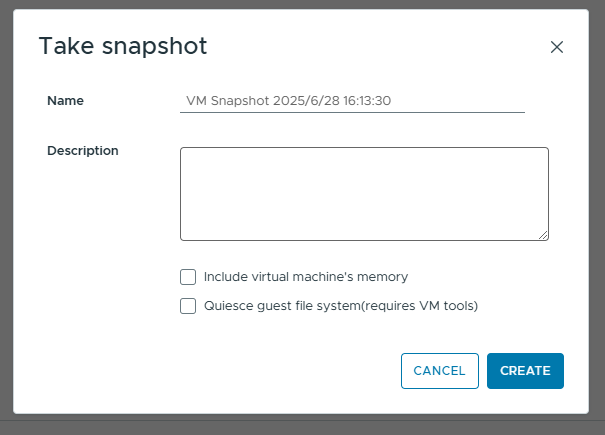
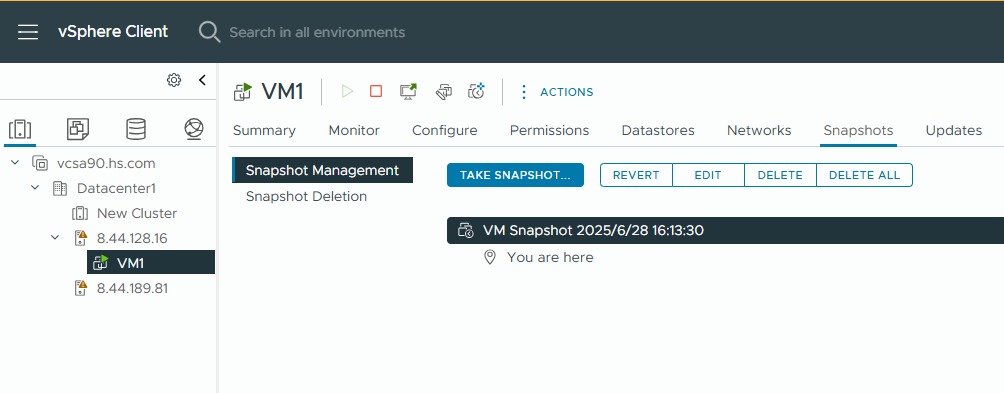

2.In step 2, the values of the lazyclone parameter for the snapshot file and the source file are as expected. 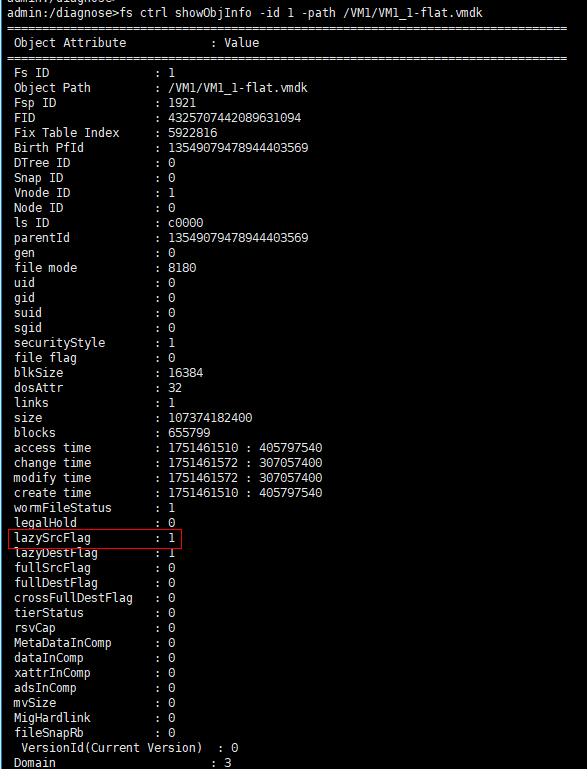
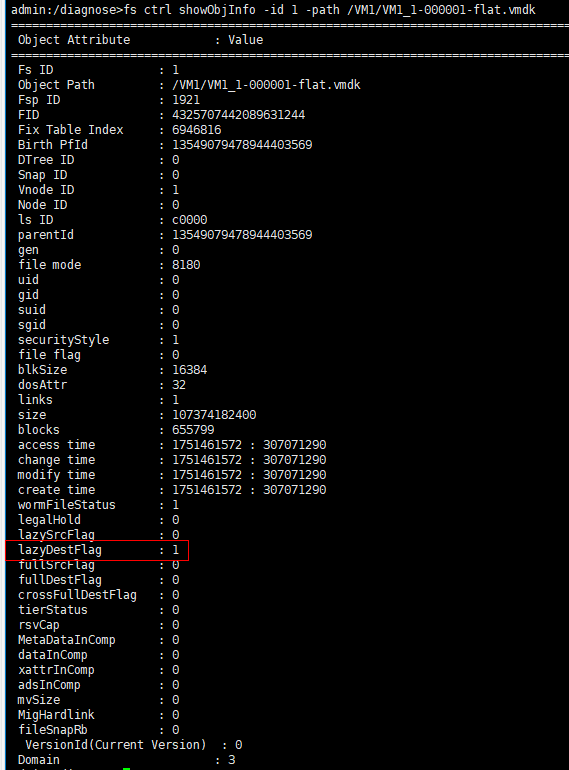
3.In step 3, IO operations of the VM are normal. 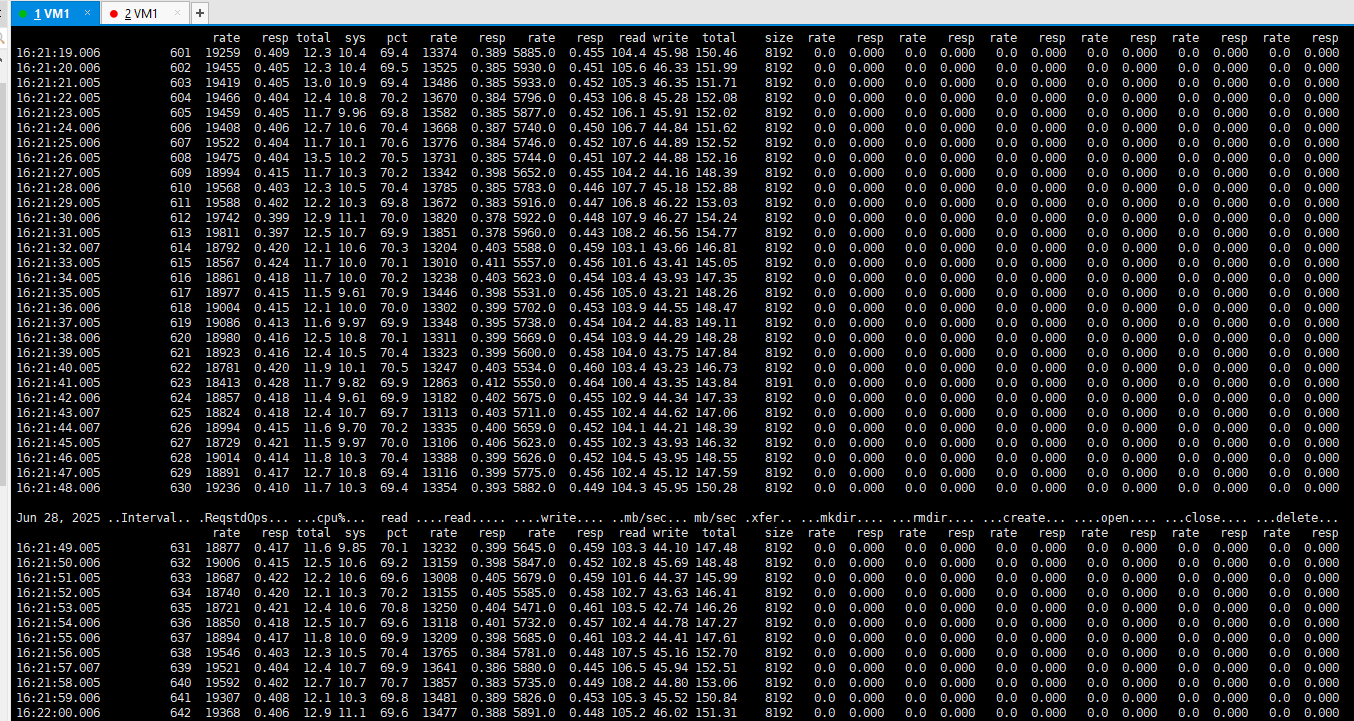
4.In step 4, snapshot recovery is successful, and the virtual machine files are in the same state as they were when the snapshot was rolled back. 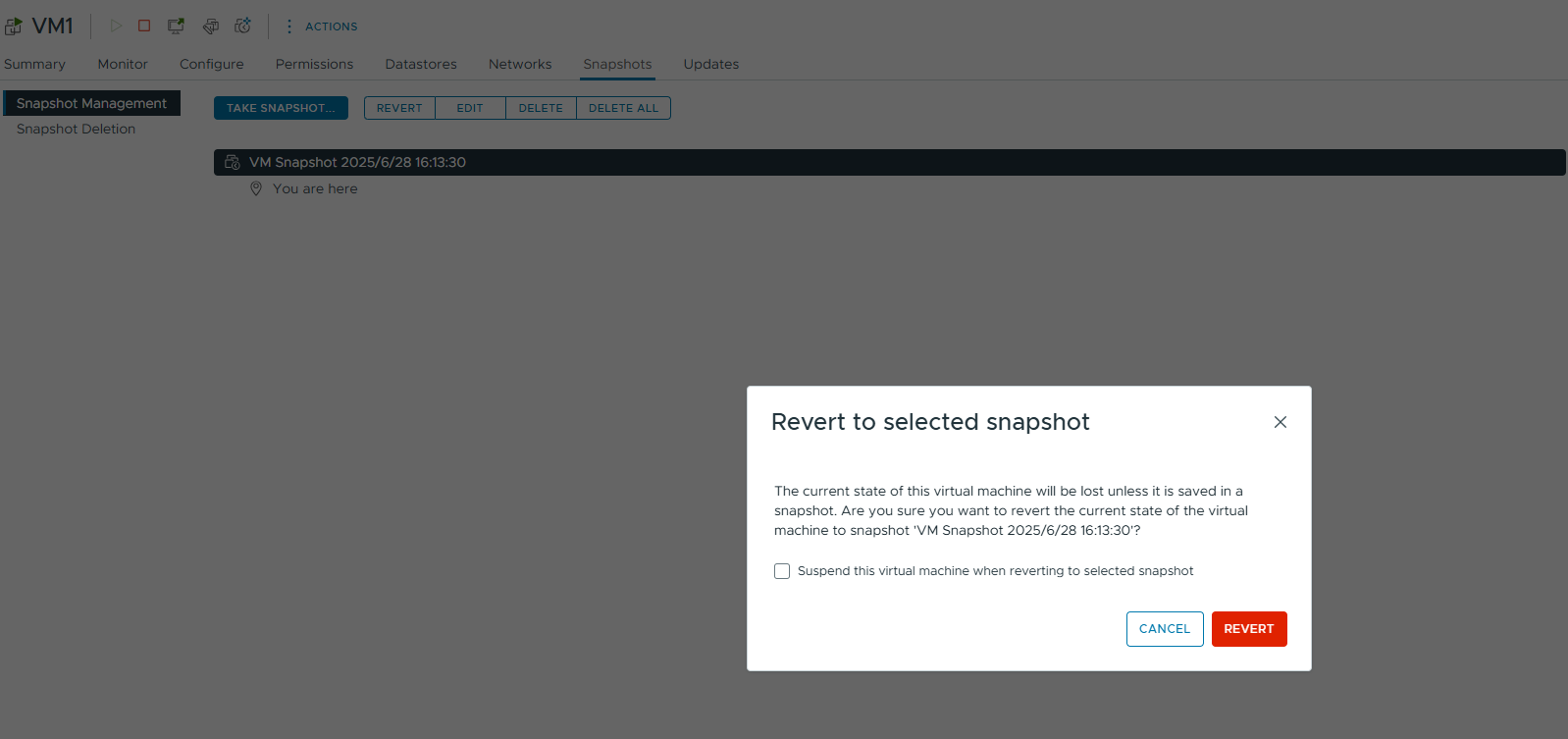
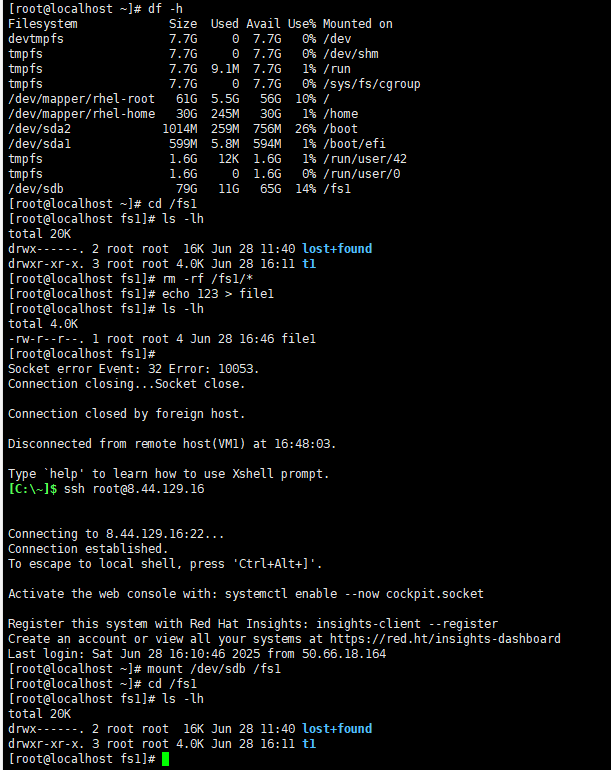
|
Test Conclusion | Passed |
2.10 Space Statistics with VAAI-NAS Enabled
Test Purpose | To Verify That the Space Statistics of Virtual Machine Are as Expected |
Test Networking | Storage and VMware ESXi Compatibility Test Networking |
Prerequisites | 1.The network is correctly configured according to the network diagram, and the physical links are normal. 2.The host has installed ESXi operating system. 3.A logical port has been created successfully on the storage. 4.A file system and NFS share has been created successfully on the storage. 5.An NFS datastore has been created on the ESXi host. 6.VAAI-NAS plug-in is installed on the ESXi host, and VAAI-NAS is enabled on the storage. |
Test Procedure | 1.Add 100GB of Thick Provision Eager Zeroed and Thin Provision disks to the source virtual machine, and pre-loads 10GB of data. Observe the space statistics of the virtual disks. 2.Create a snapshot and observe the space statistics of the virtual disks. |
Expected Result | 1.In step 1, the disks are added to the virtual machine successfully and the space statistics of the virtual disks are shown as follow: Thick Provision Eager Zeroed: 100GB Logical Space / 100GB Physical Space (after disk formatting) / 100GB Exclusive Space Thin Provision: 100GB Logical Space / 12GB Physical Space (after disk formatting) / 12GB Exclusive Space 2.In step 2, the snapshot is created successfully and the space statistics of the virtual disks are shown as follow: Thick Provision Eager Zeroed: 100GB Logical Space / 100GB Physical Space (after disk formatting) / OGB Exclusive Space Thin Provision: 100GB Logical Space / 12GB Physical Space (after disk formatting) / 0GB Exclusive Space |
Test Record | 1.In step 1, the disks are added to the virtual machine successfully and the space statistics of the virtual disks are shown as follow: Thick Provision Eager Zeroed: 100GB Logical Space / 100GB Physical Space (after disk formatting) / 100GB Exclusive Space
Thin Provision: 100GB Logical Space / 12GB Physical Space (after disk formatting) / 12GB Exclusive Space
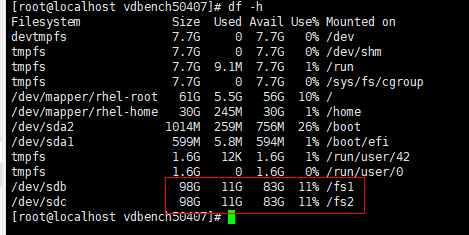
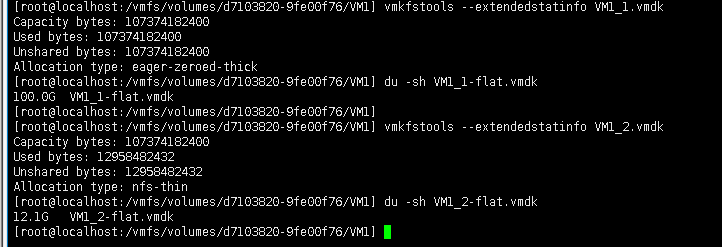
2.In step 2, the snapshot is created successfully and the space statistics of the virtual disks are shown as follow: Thick Provision Eager Zeroed: 100GB Logical Space / 100GB Physical Space (after disk formatting) / OGB Exclusive Space
Thin Provision: 100GB Logical Space / 12GB Physical Space (after disk formatting) / 0GB Exclusive Space
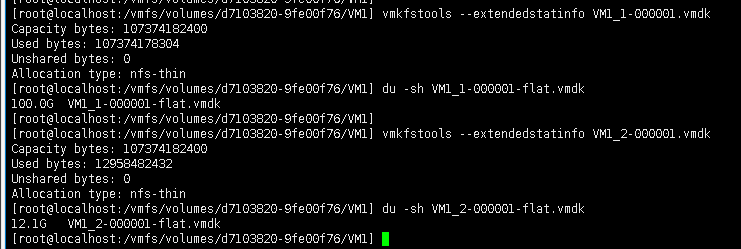
|
Test Conclusion | Passed |
3. Reliability Test
3.1 Storage HyperMetro Pair Split and Synchronize
Test Purpose | To Verify That Business Is Normal in the Storage HyperMetro Pair Split and Synchronize Scenario |
Test Networking | Storage and VMware ESXi Compatibility Test Networking |
Prerequisites | 1.The network is correctly configured according to the network diagram, and the physical links are normal. 2.The host has installed ESXi operating system. 3.The storage HyperMetro is configured correctly. 4.A HyperMetro vStore pair has been created. 5.A logical port has been created in HyperMetro vStore, and the running status is link up on the preferred site. 6.A file system and an NFS share have been created in HyperMetro vStore. 7.An NFS datastore has been created on the ESXi host. 8.Vdbench is running normally on the virtual machine. |
Test Procedure | 1.Set the preferred site of the HyperMetro pairs to storage 1, then split the HyperMetro domain and pause the preferred site. Observe the running status of the logical port and observe the I/O stress. 2.Recover the HyperMetro domain then wait for the HyperMetro pair synchronization to complete. Observe the running status of the logical port and observe the I/O stress. |
Expected Result | 1.In step 1, I/O is uninterrupted, the reset time is within the specification range, and the running status of the logical port is link up on storage 2. 2.In step 2, I/O is uninterrupted, the reset time is within the specification range, and the running status of the logical port is link up on storage 1. |
Test Record | 1.In step 1, I/O is uninterrupted, the reset time is within the specification range, and the running status of the logical port is link up on storage 2. 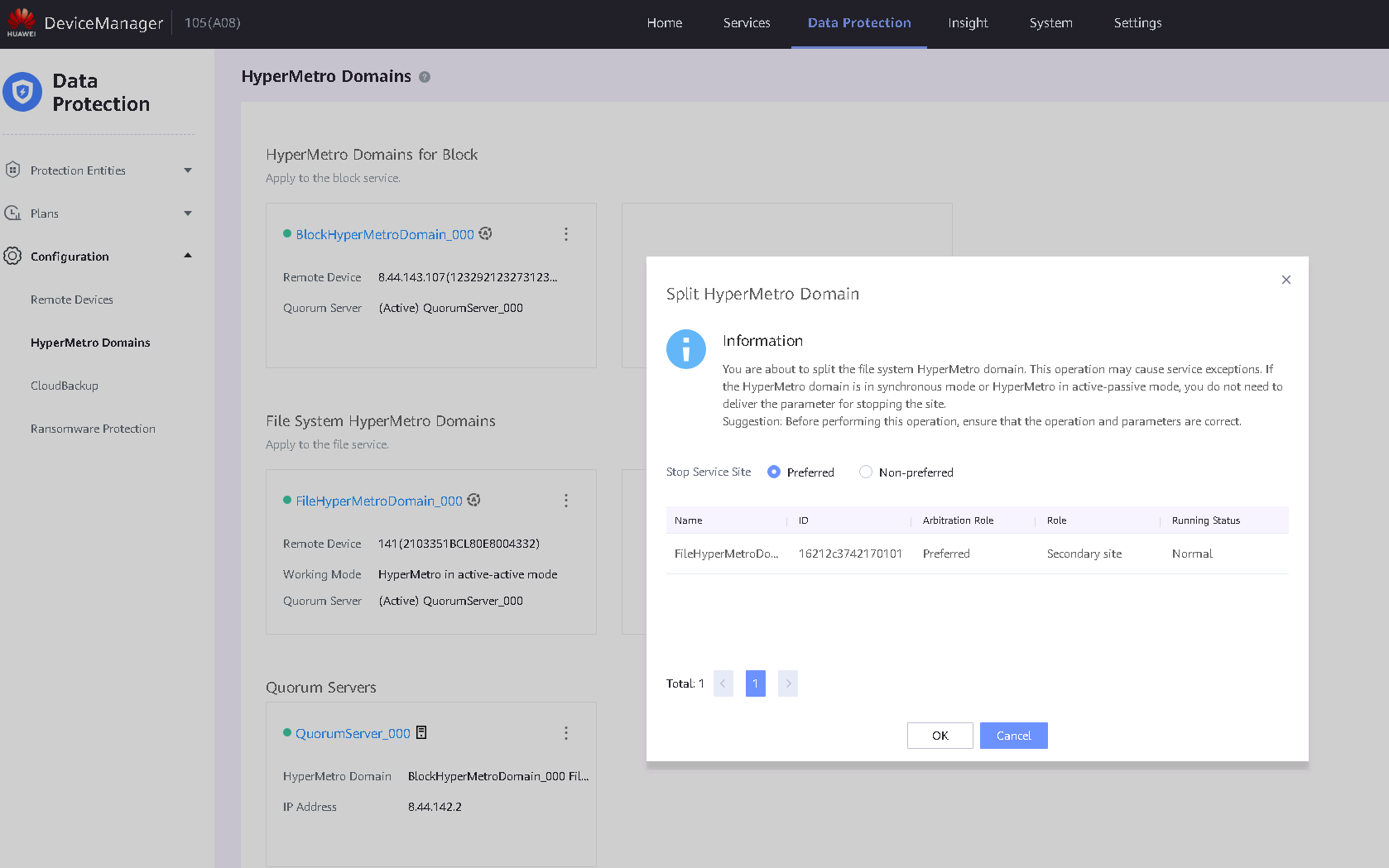
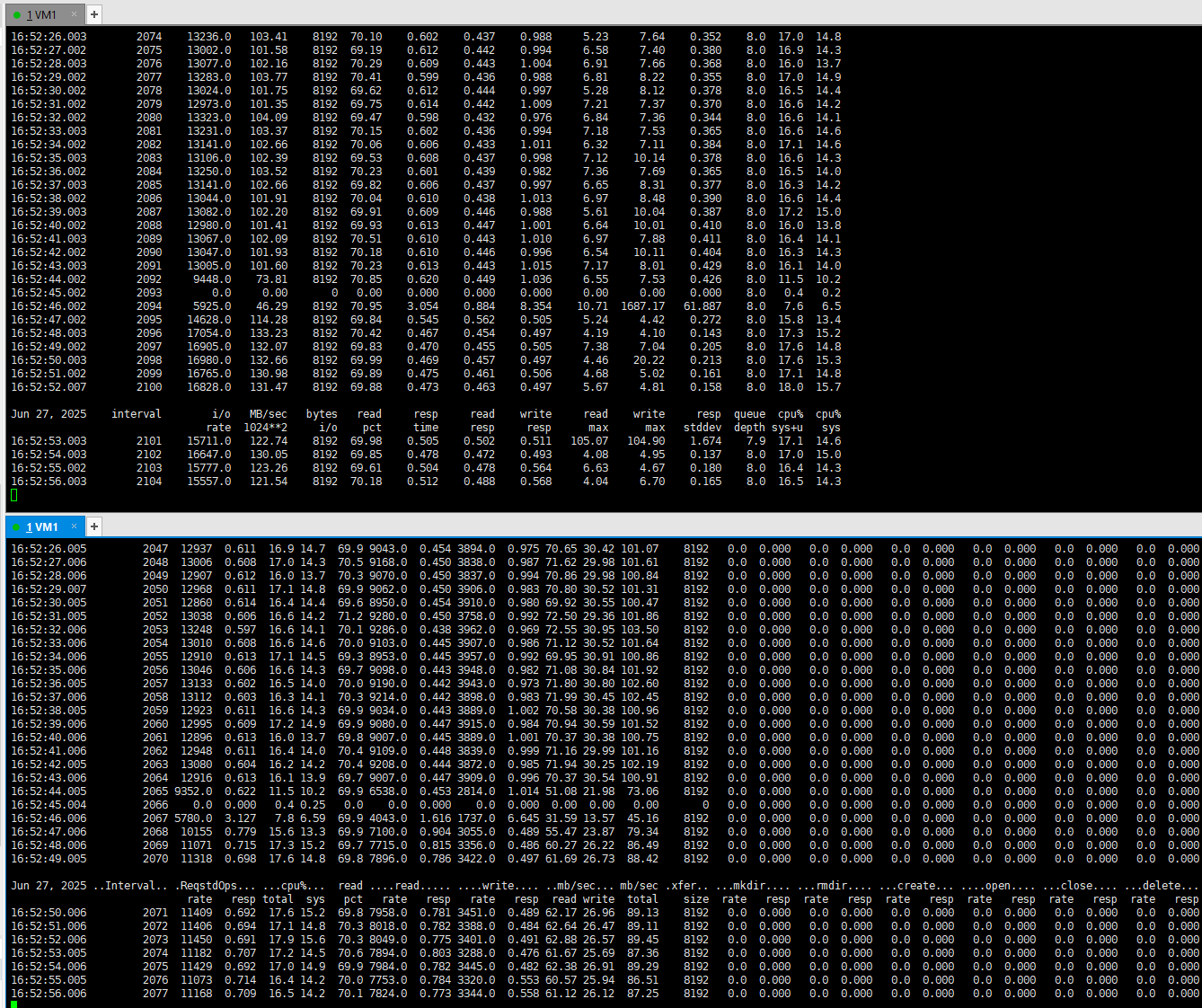
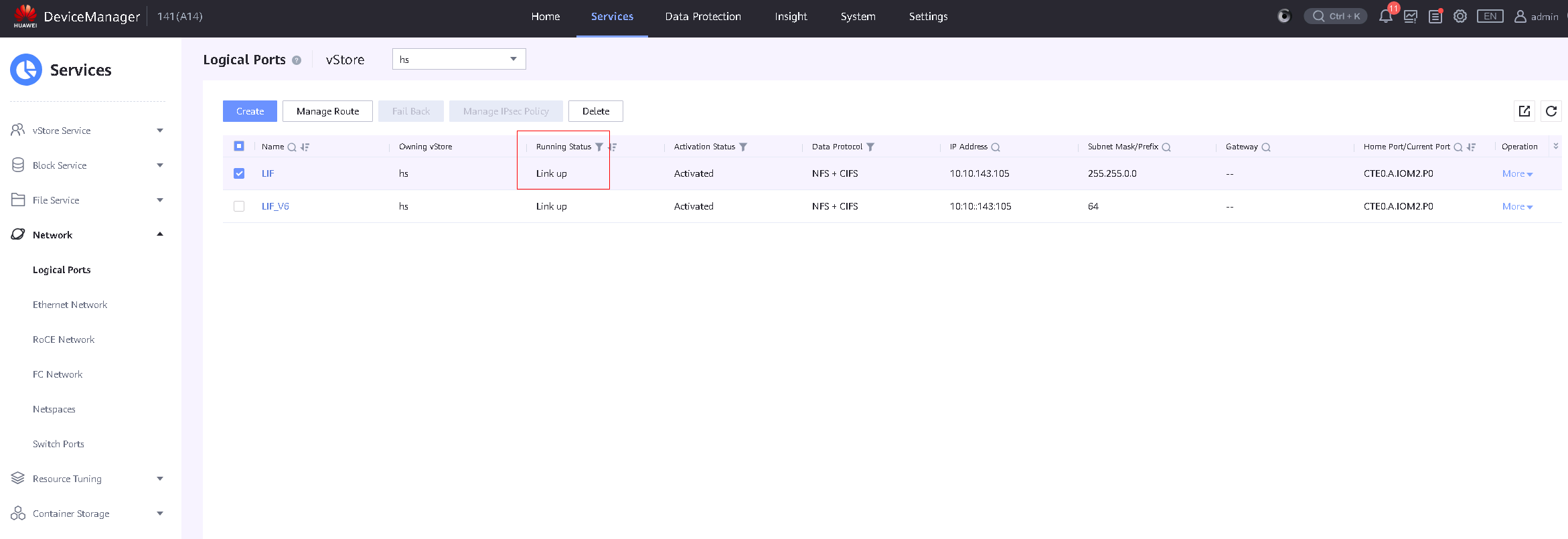
1.In step 2, I/O is uninterrupted, the reset time is within the specification range, and the running status of the logical port is link up on storage 1. 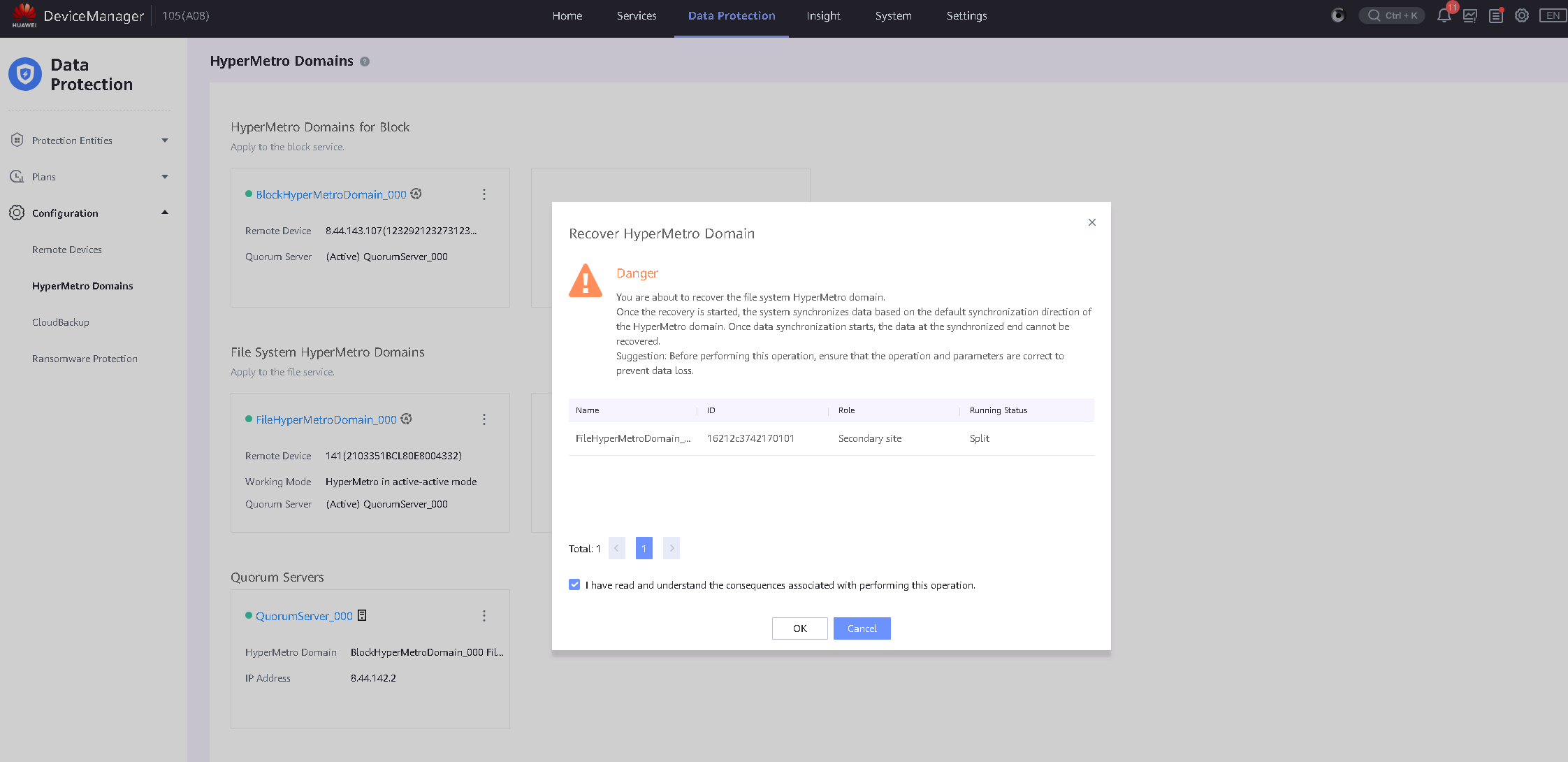
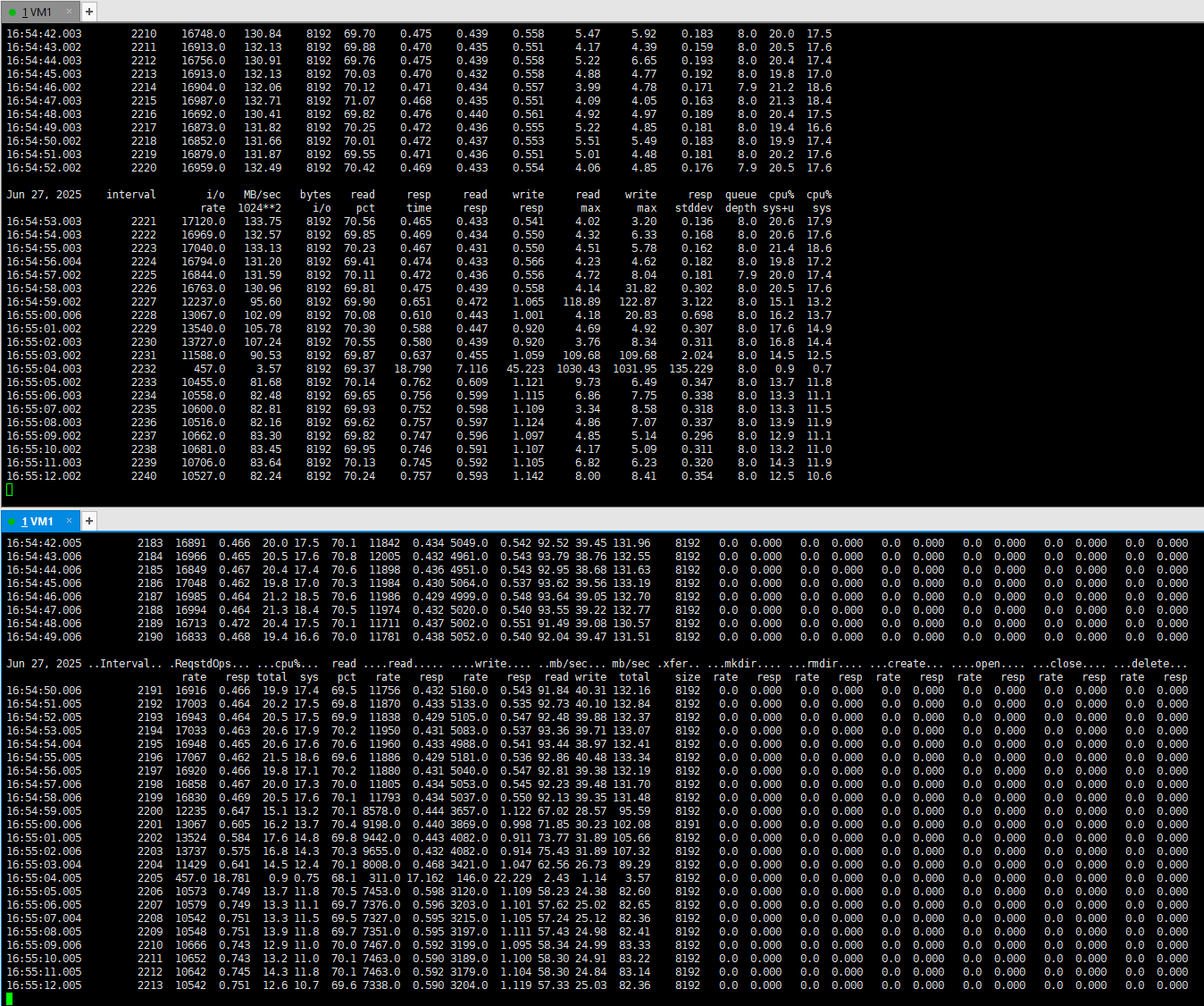
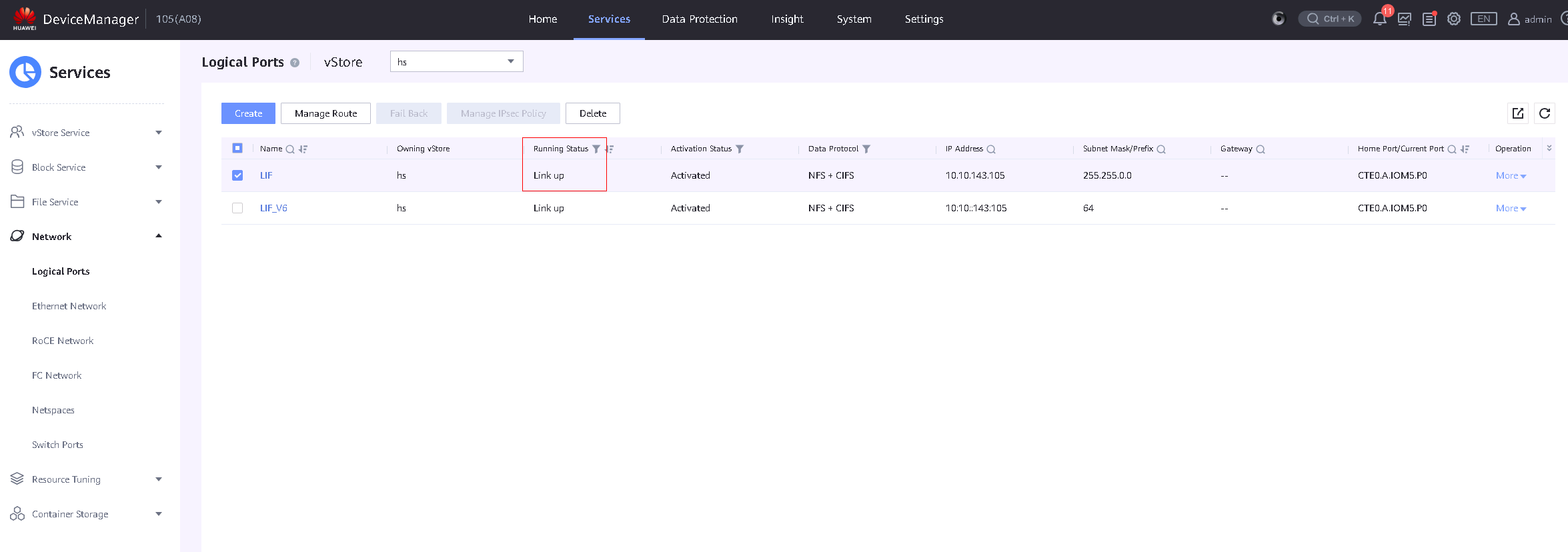
|
Test Conclusion | Passed |
3.2 Storage Replication Link Failure and Recovery
Test Purpose | To Verify That Business Is Normal in the Storage Replication Link Failure Scenario |
Test Networking | Storage and VMware ESXi Compatibility Test Networking |
Prerequisites | 1.The network is correctly configured according to the network diagram, and the physical links are normal. 2.The host has installed ESXi operating system. 3.The storage HyperMetro is configured correctly. 4.A HyperMetro vStore pair has been created. 5.A logical port has been created in HyperMetro vStore, and the running status is link up on the preferred site. 6.A file system and an NFS share have been created in HyperMetro vStore. 7.An NFS datastore has been created on the ESXi host. 8.Vdbench is running normally on the virtual machine. |
Test Procedure | 1.Set the preferred site of the HyperMetro pairs to storage 1, then unplug all cables of replication links between the storages. Observe the running status of the logical port and observe the I/O stress. 2.Plug back the cables back in, then wait for the HyperMetro pair synchronization to complete. Observe the running status of the logical port and observe the I/O stress. |
Expected Result | 1.In step 1, I/O is uninterrupted, the reset time is within the specification range, and the running status of the logical port is link up on storage 2. 2.In step 2, I/O is uninterrupted, the reset time is within the specification range, and the running status of the logical port is link up on storage 1. |
Test Record | 1.In step 1, I/O is uninterrupted, the reset time is within the specification range, and the running status of the logical port is link up on storage 2. 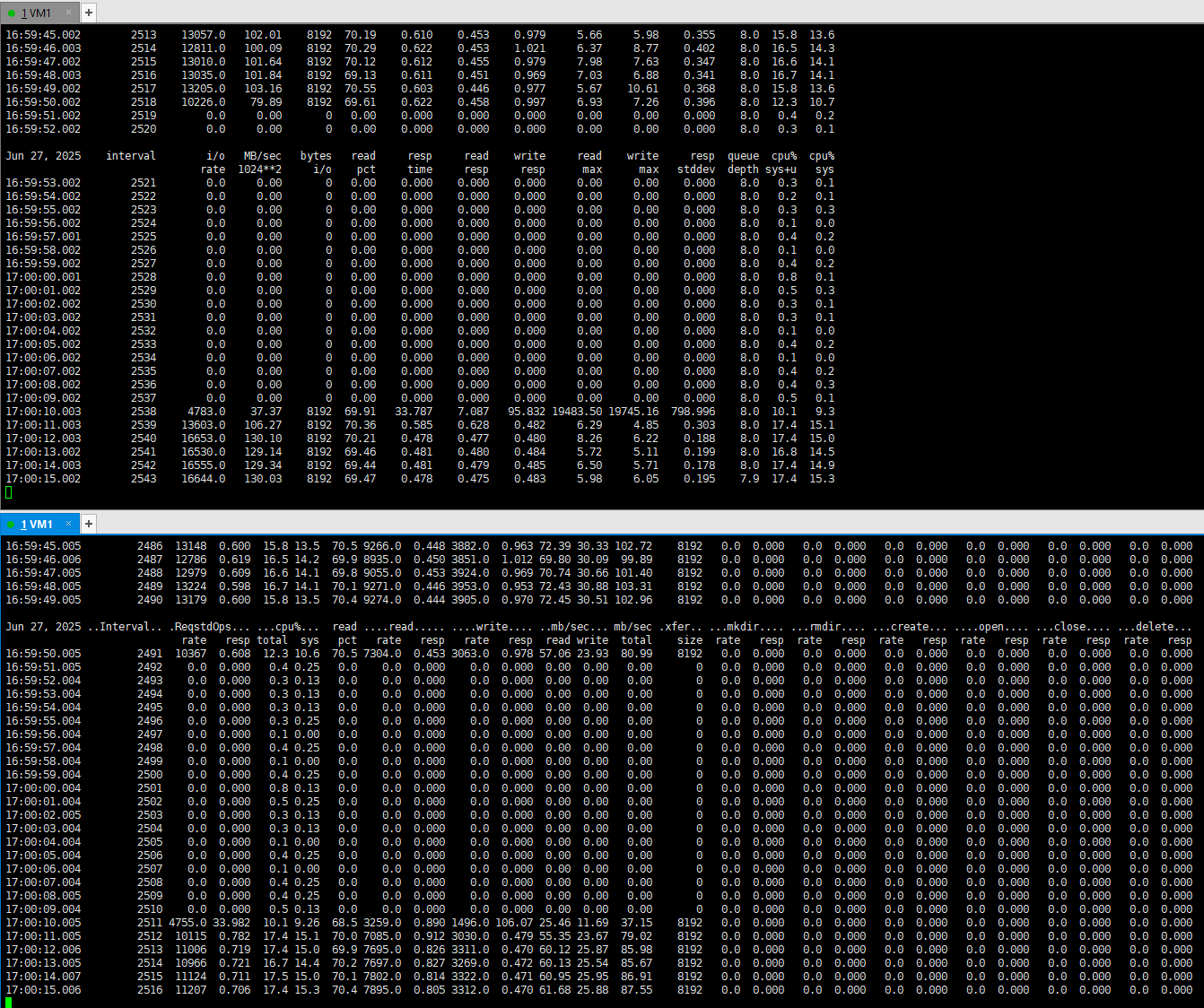
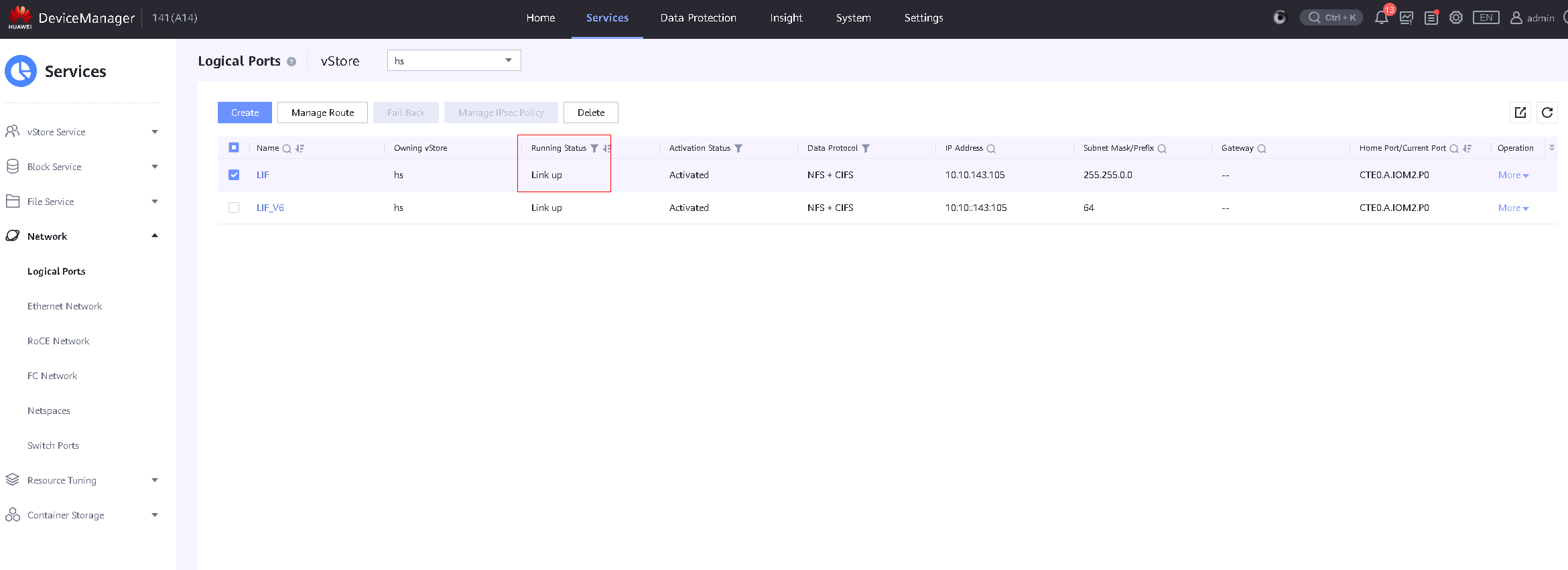
2.In step 2, I/O is uninterrupted, the reset time is within the specification range, and the running status of the logical port is link up on storage 1. 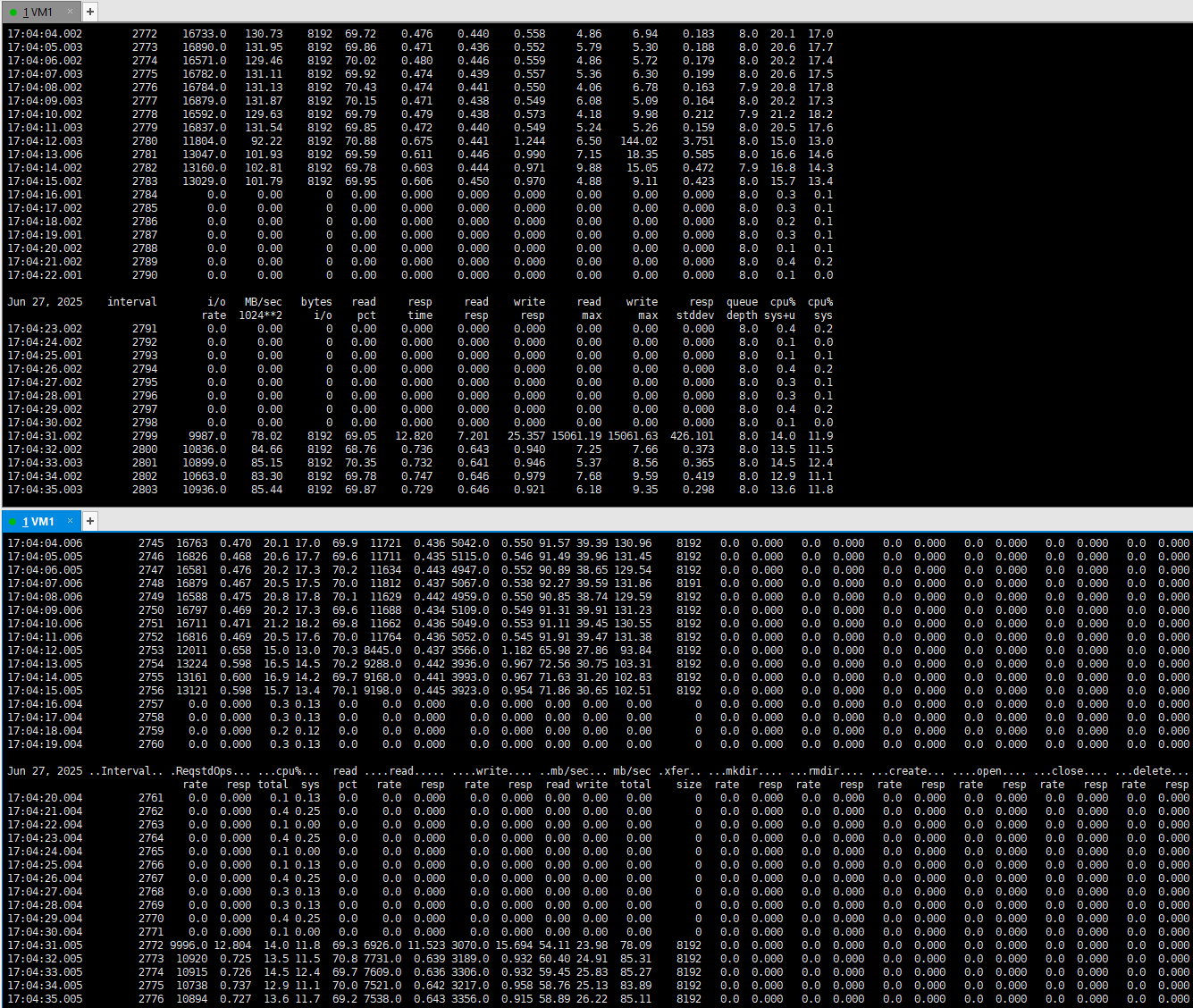
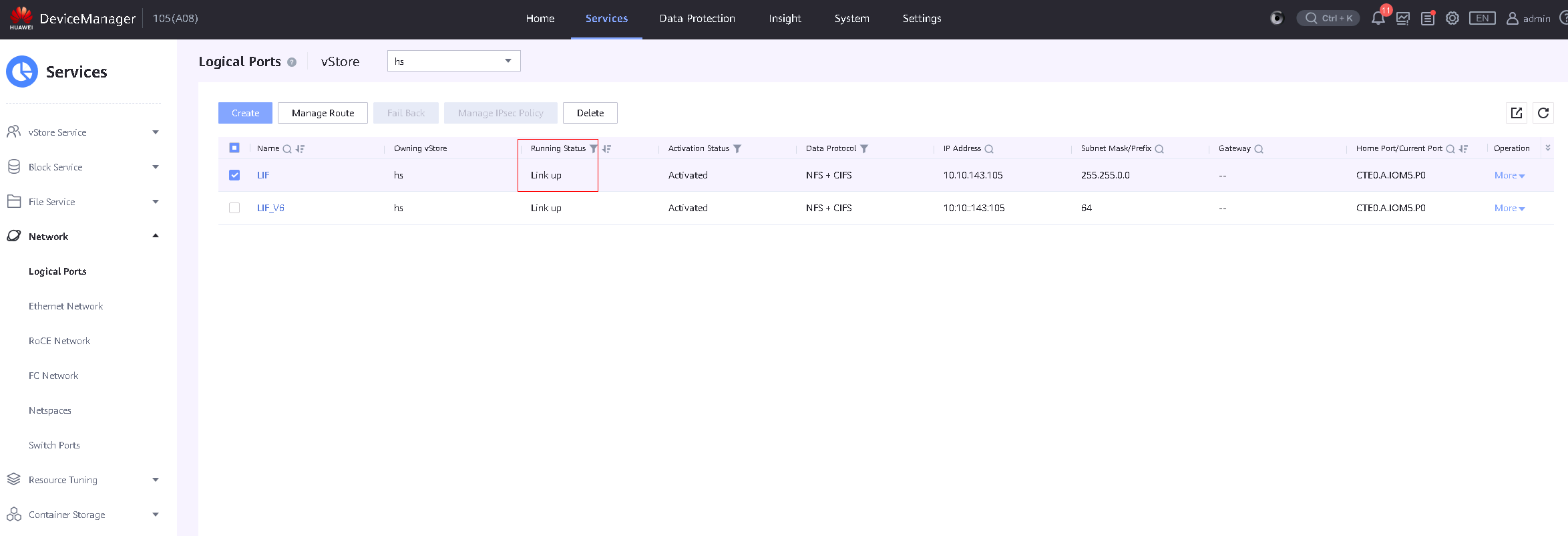
|
Test Conclusion | Passed |
3.3 One Sit of HyperMetro Storages Abnormal Power Off and Recovery
Test Purpose | To Verify That Business Is Normal in the One Sit of HyperMetro Storages Abnormal Power Off Scenario |
Test Networking | Storage and VMware ESXi Compatibility Test Networking |
Prerequisites | 1.The network is correctly configured according to the network diagram, and the physical links are normal. 2.The host has installed ESXi operating system. 3.The storage HyperMetro is configured correctly. 4.A HyperMetro vStore pair has been created. 5.A logical port has been created in HyperMetro vStore, and the running status is link up on the preferred site. 6.A file system and an NFS share have been created in HyperMetro vStore. 7.An NFS datastore has been created on the ESXi host. 8.Vdbench is running normally on the virtual machine. |
Test Procedure | 1.Remove the power supply of the preferred site, then wait for the BBU to discharge. Observe the running status of the logical port and observe the I/O stress. 2.Power on the storage. Observe the running status of the logical port and observe the I/O stress. |
Expected Result | 1.In step 1, I/O is uninterrupted, the reset time is within the specification range, and the running status of the logical port is link up on storage 2. 2.In step 2, I/O is uninterrupted, the reset time is within the specification range, and the running status of the logical port is link up on storage 1. |
Test Record | 1.In step 1, I/O is uninterrupted, the reset time is within the specification range, and the running status of the logical port is link up on storage 2. 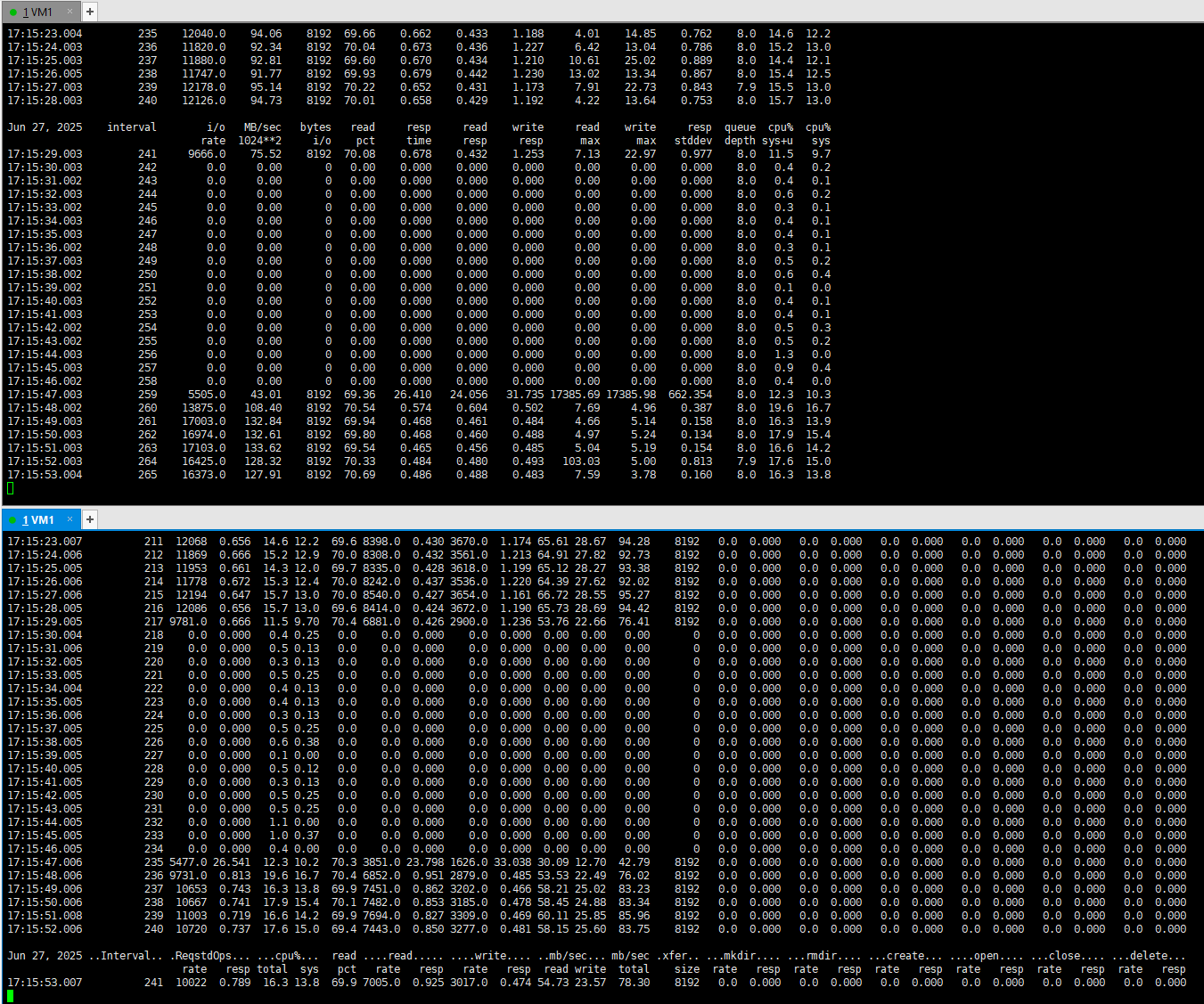
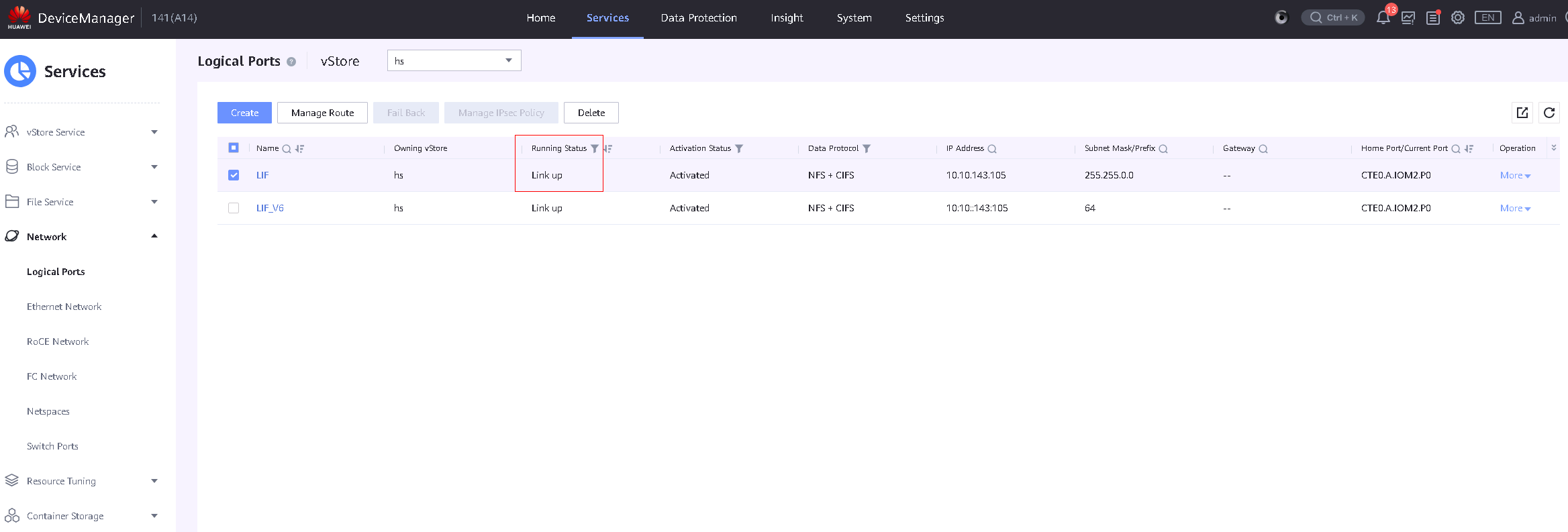
1.In step 2, I/O is uninterrupted, the reset time is within the specification range, and the running status of the logical port is link up on storage 1. 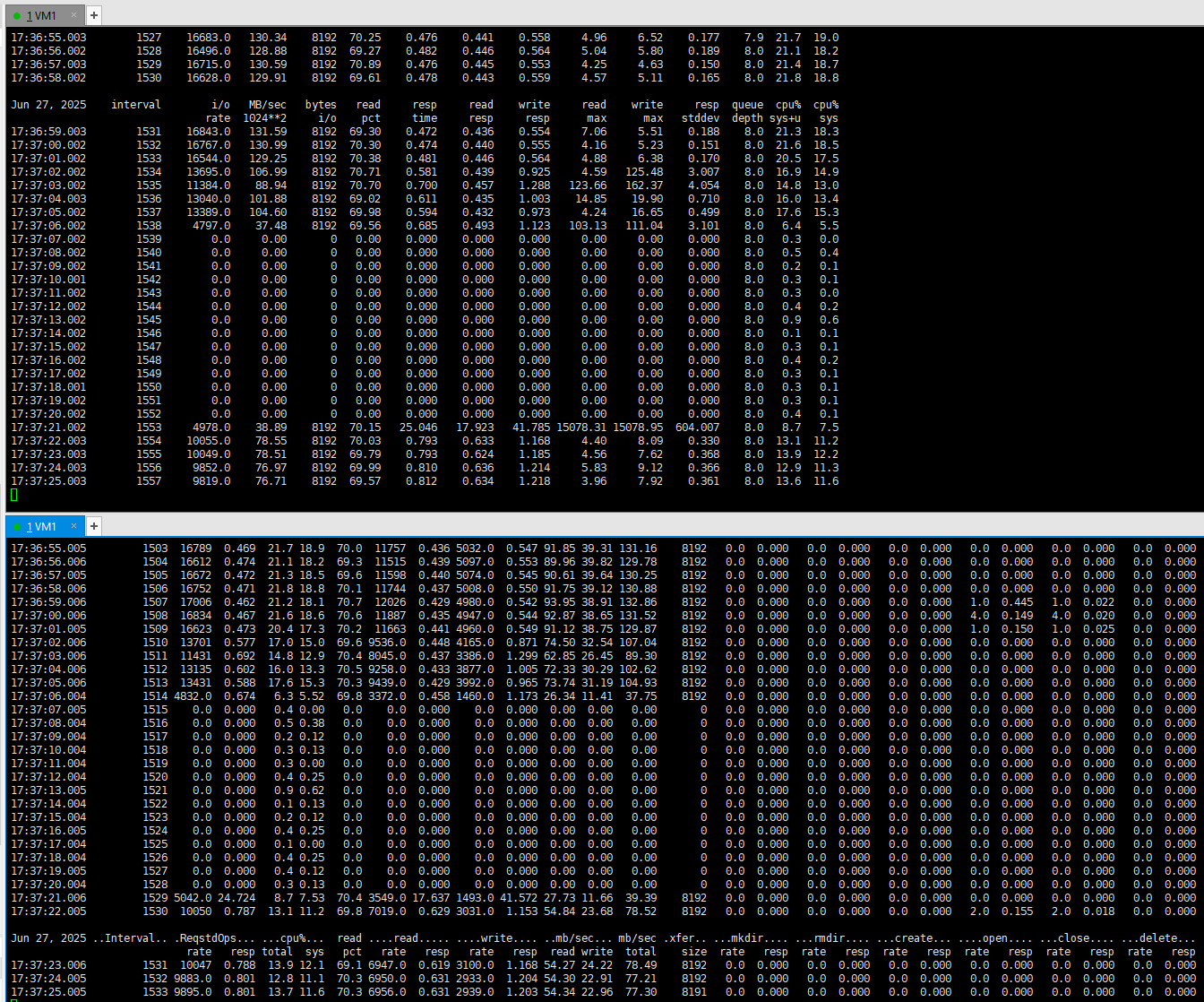
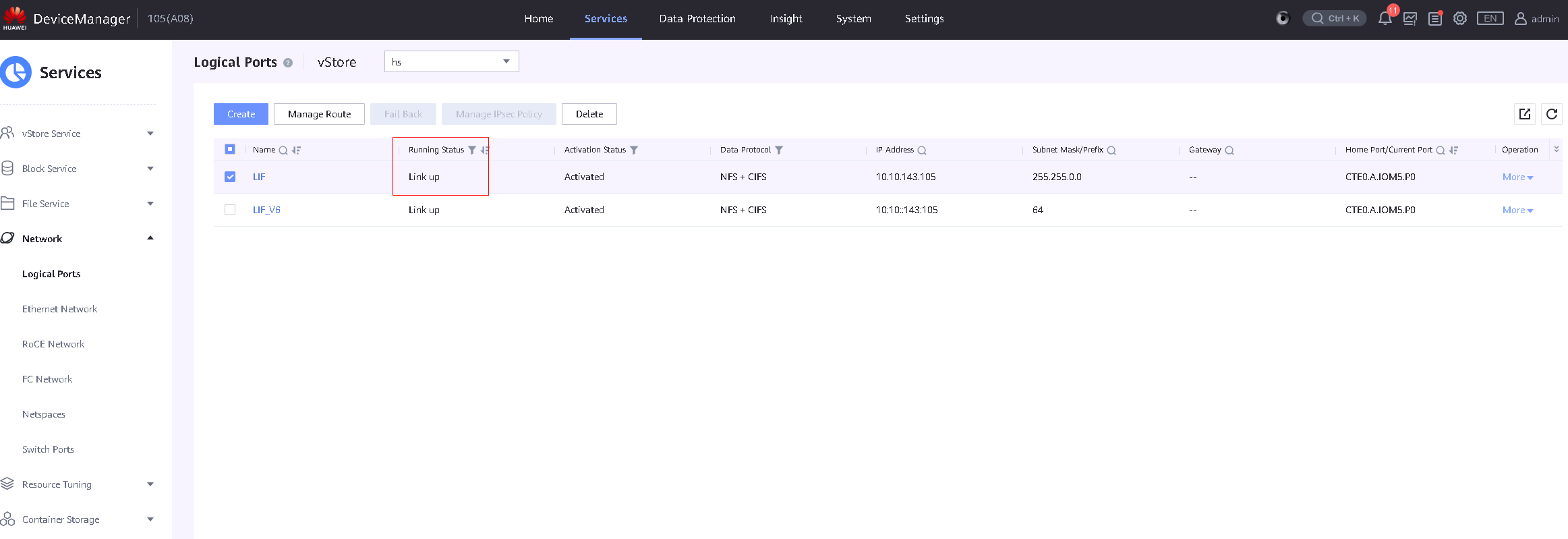
|
Test Conclusion | Passed |
3.4 Controller Failure and Recovery
Test Purpose | To Verify That Business Is Normal in the Controller Failure Scenario |
Test Networking | Storage and VMware ESXi Compatibility Test Networking |
Prerequisites | 1.The network is correctly configured according to the network diagram, and the physical links are normal. 2.The host has installed ESXi operating system. 3.The storage HyperMetro is configured correctly. 4.A HyperMetro vStore pair has been created. 5.A logical port has been created in HyperMetro vStore, and the running status is link up on the preferred site. 6.A file system and an NFS share have been created in HyperMetro vStore. 7.An NFS datastore has been created on the ESXi host. 8.Vdbench is running normally on the virtual machine. |
Test Procedure | 1.Unplug the controller A from both storages at the same time. Observe the running status of the logical port and observe the I/O stress. 2.Reinsert the controllers and wait for controllers to recover. Observe the running status of the logical port and observe the I/O stress. |
Expected Result | 1.In step 1, I/O is uninterrupted, the reset time is within the specification range, and the logical ports failover to controller B. 2.In step 2, I/O is uninterrupted, the reset time is within the specification range, and the logical ports failover to controller A. |
Test Record |
1.In step 1, I/O is uninterrupted, the reset time is within the specification range, and the logical ports failover to controller B.

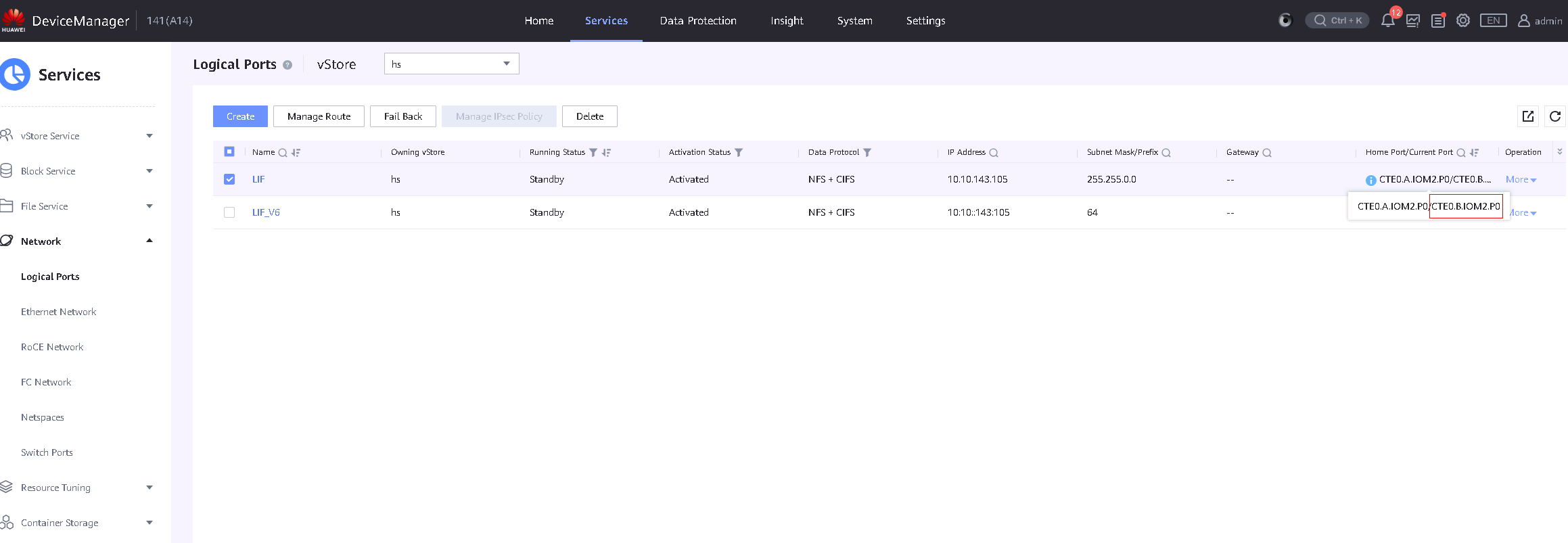
2.In step 2, I/O is uninterrupted, the reset time is within the specification range, and the logical ports failover to controller A.
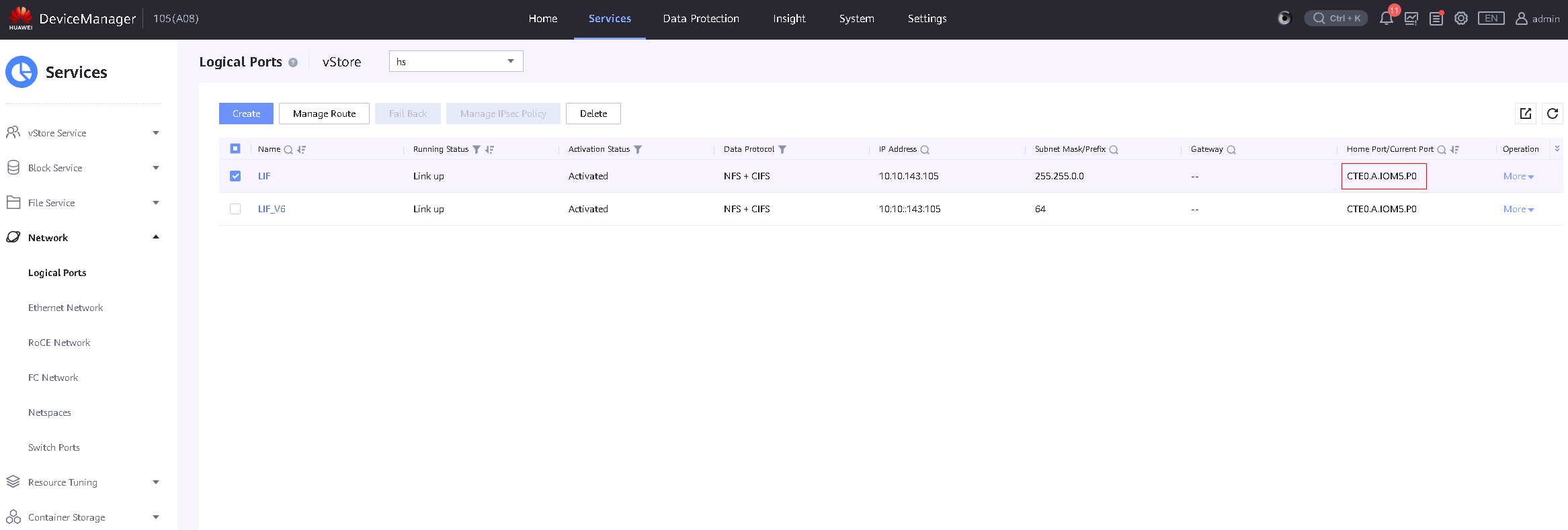
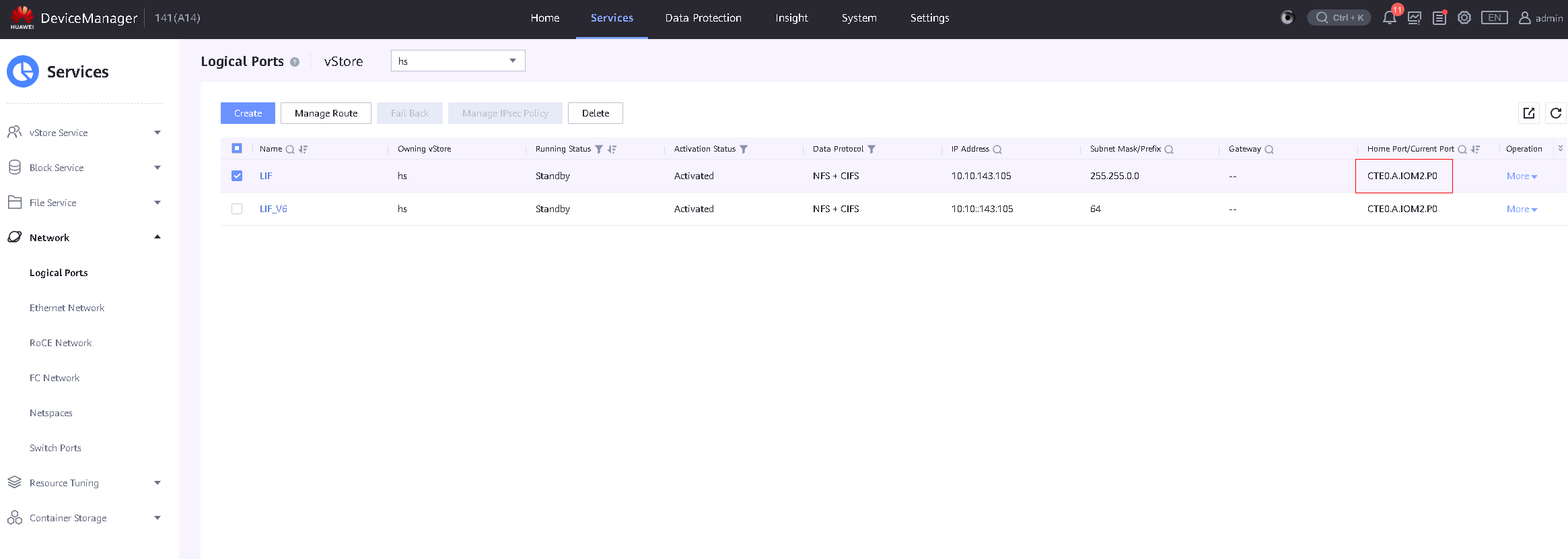
|
Test Conclusion | Passed |
3.5 Host Link Failure
Test Purpose | To Verify That Virtual Machine Failover Function Is Normal in the Host Link Failure Scenario |
Test Networking | Storage and VMware ESXi Compatibility Test Networking |
Prerequisites | 1.The network is correctly configured according to the network diagram, and the physical links are normal. 2.Two ESXi hosts are added to vCenter cluster and configured vSphere HA correctly. 3.The storage HyperMetro is configured correctly. 4.A HyperMetro vStore pair has been created. 5.A logical port has been created in HyperMetro vStore, and the running status is link up on the preferred site. 6.A file system and an NFS share have been created in HyperMetro vStore. 7.An NFS datastore has been created on the vCenter cluster. 8.Vdbench is running normally on the virtual machine. |
Test Procedure | 1.Unplug the service link of the host 1 and observe the virtual machine status. 2.Rerun vdbench on the virtual machine. 3.Migrate the virtual machine back to the host 1. |
Expected Result | 1.In step 1, I/O is interrupted and the virtual machine is migrated to host 2. 2.In step 2, vdbench is running normally on the virtual machine. 3.In step 3, the virtual machine is migrated back to the host 1. I/O is uninterrupted and the reset time is within the specification range. |
Test Record |
1.In step 1, I/O is interrupted and the virtual machine is migrated to host 2.

2.In step 2, vdbench is running normally on the virtual machine. 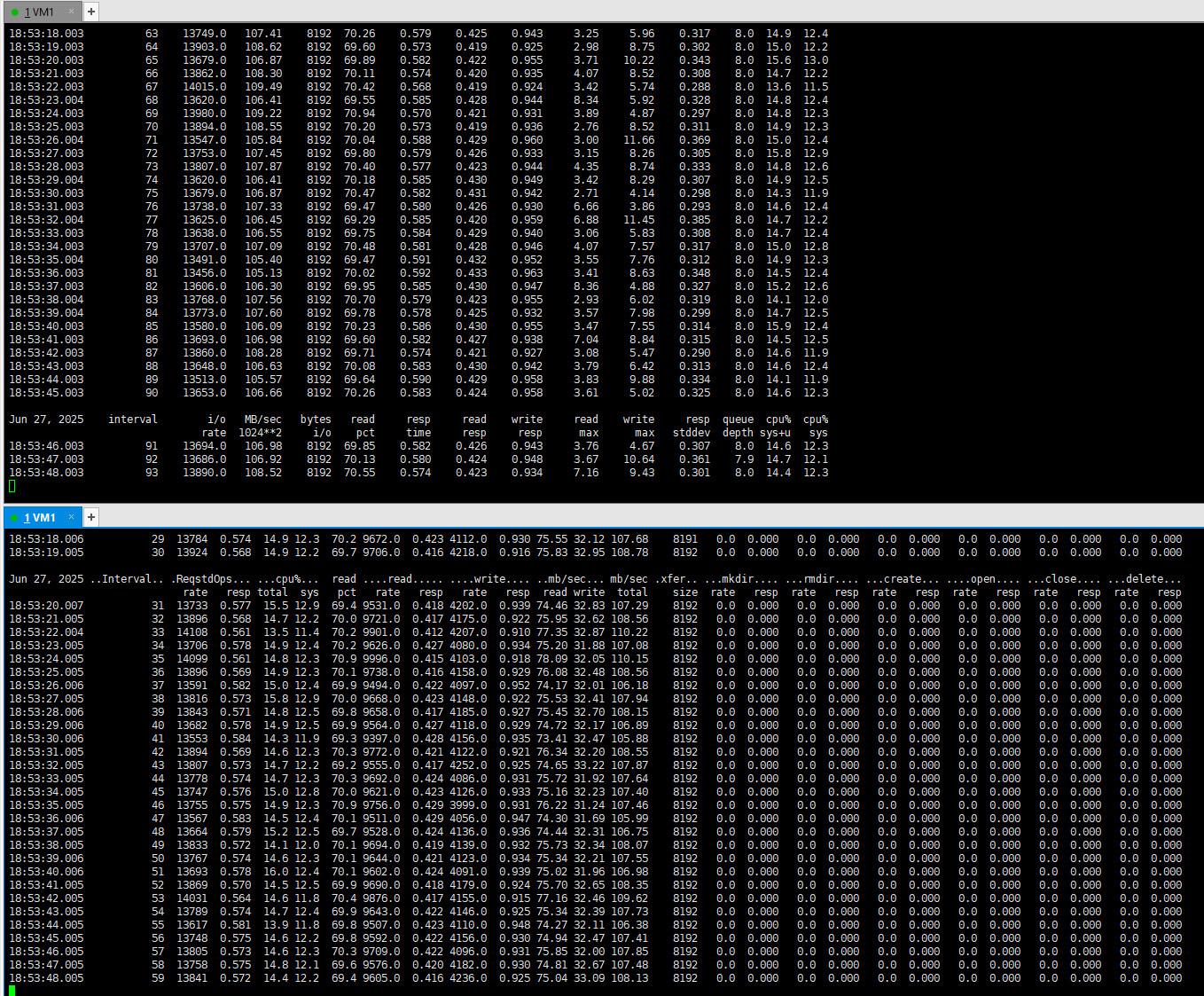
3.In step 3, the virtual machine is migrated back to the host 1. I/O is uninterrupted and the reset time is within the specification range.

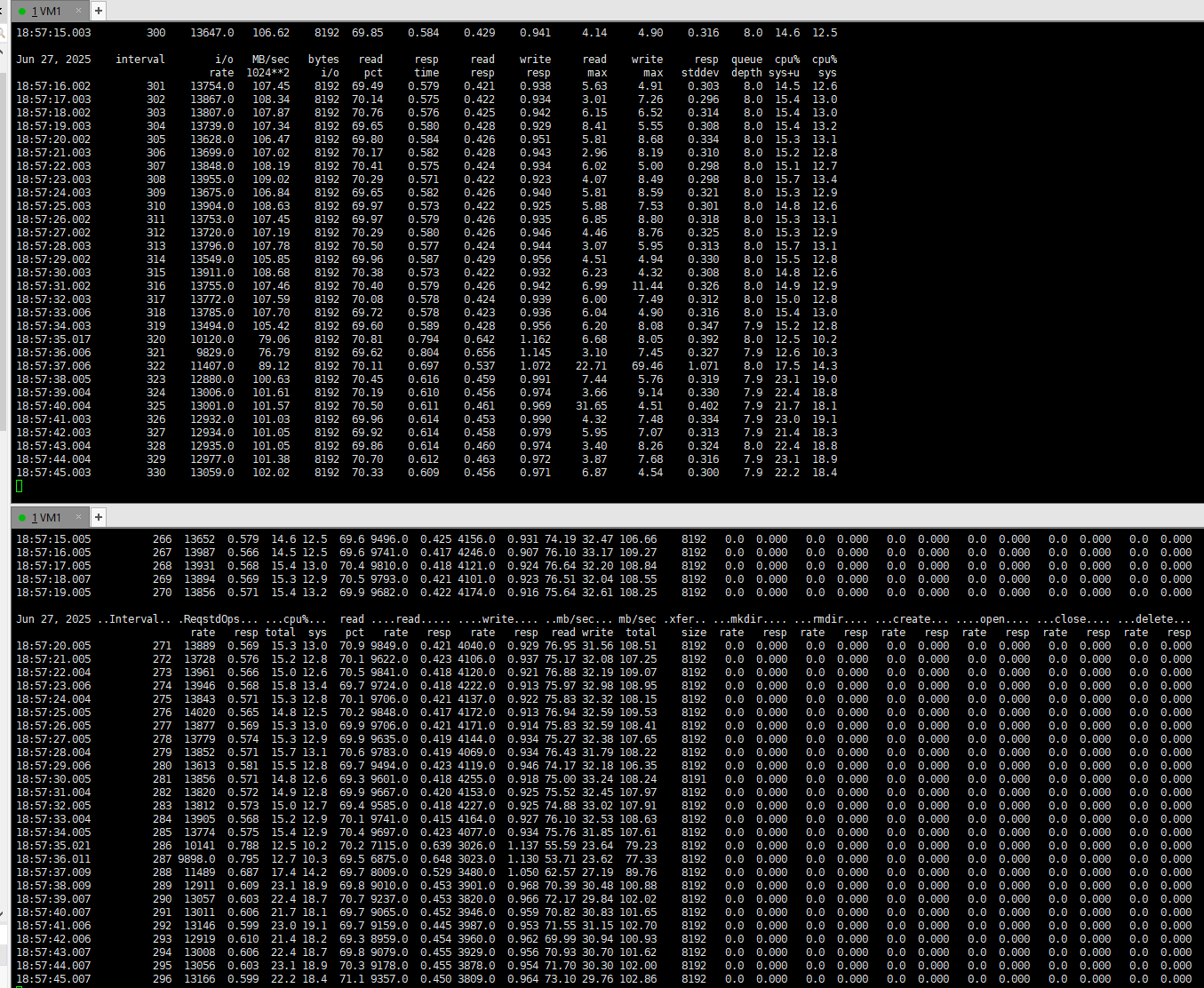
|
Test Conclusion | Passed |
3.6 Host Reboot
Test Purpose | To Verify That Virtual Machine Failover Function Is Normal in the Host Reboot Scenario |
Test Networking | Storage and VMware ESXi Compatibility Test Networking |
Prerequisites | 1.The network is correctly configured according to the network diagram, and the physical links are normal. 2.Two ESXi hosts are added to vCenter cluster and configured vSphere HA correctly. 3.The storage HyperMetro is configured correctly. 4.A HyperMetro vStore pair has been created. 5.A logical port has been created in HyperMetro vStore, and the running status is link up on the preferred site. 6.A file system and an NFS share have been created in HyperMetro vStore. 7.An NFS datastore has been created on the vCenter cluster. 8.Vdbench is running normally on the virtual machine. |
Test Procedure | 1.Reboot the host 1 and observe the virtual machine status. 2.Rerun vdbench on the virtual machine. 3.Migrate the virtual machine back to the host 1. |
Expected Result | 1.In step 1, I/O is interrupted and the virtual machine is migrated to host 2. 2.In step 2, vdbench is running normally on the virtual machine. 3.In step 3, the virtual machine is migrated back to the host 1. I/O is uninterrupted and the reset time is within the specification range. |
Test Record | 1.In step 1, I/O is interrupted and the virtual machine is migrated to host 2. 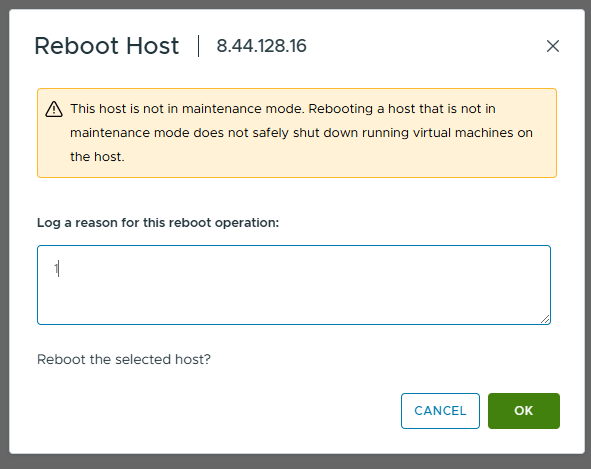

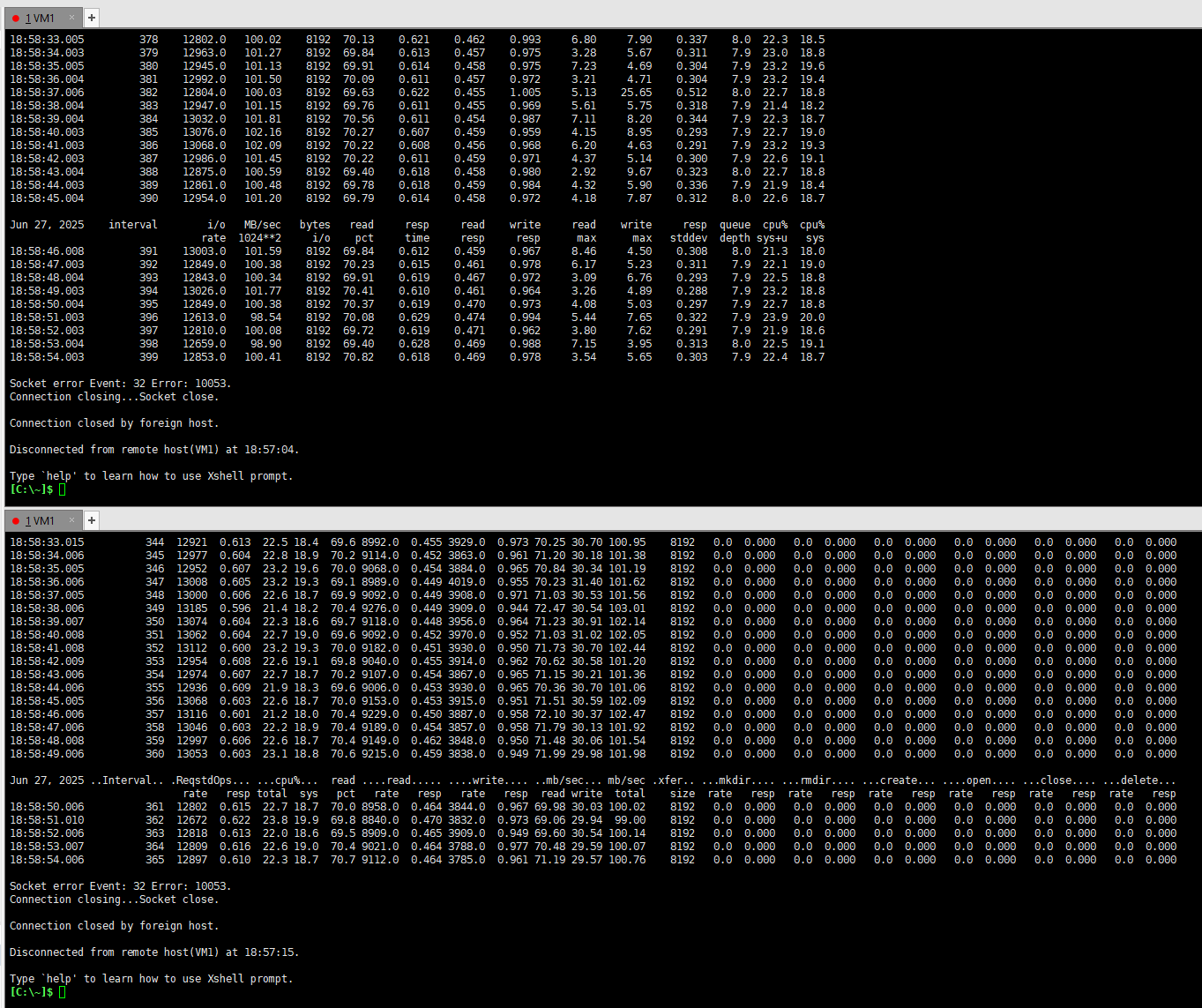
2.In step 2, vdbench is running normally on the virtual machine. 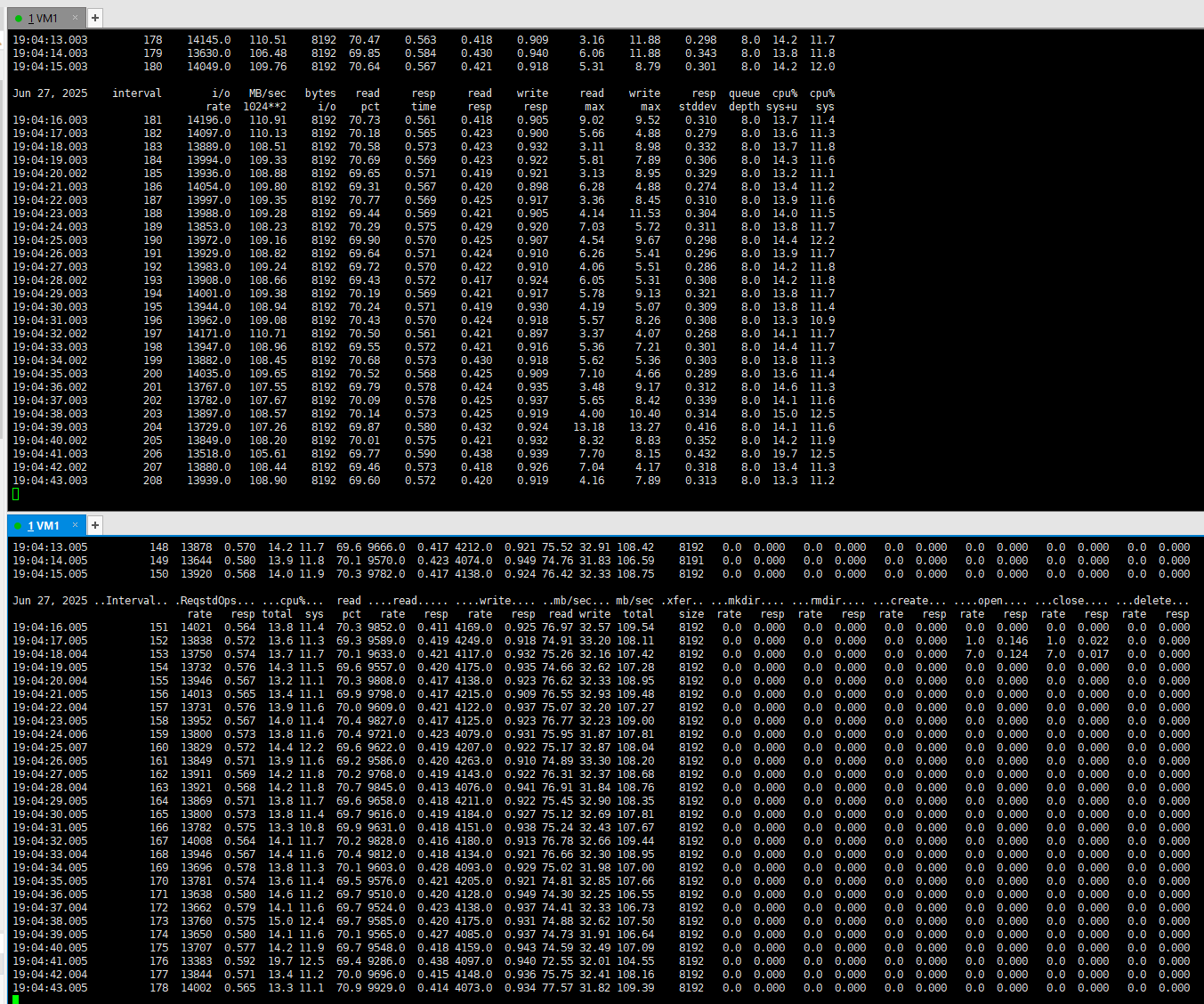
3.In step 3, the virtual machine is migrated back to the host 1. I/O is uninterrupted and the reset time is within the specification range. 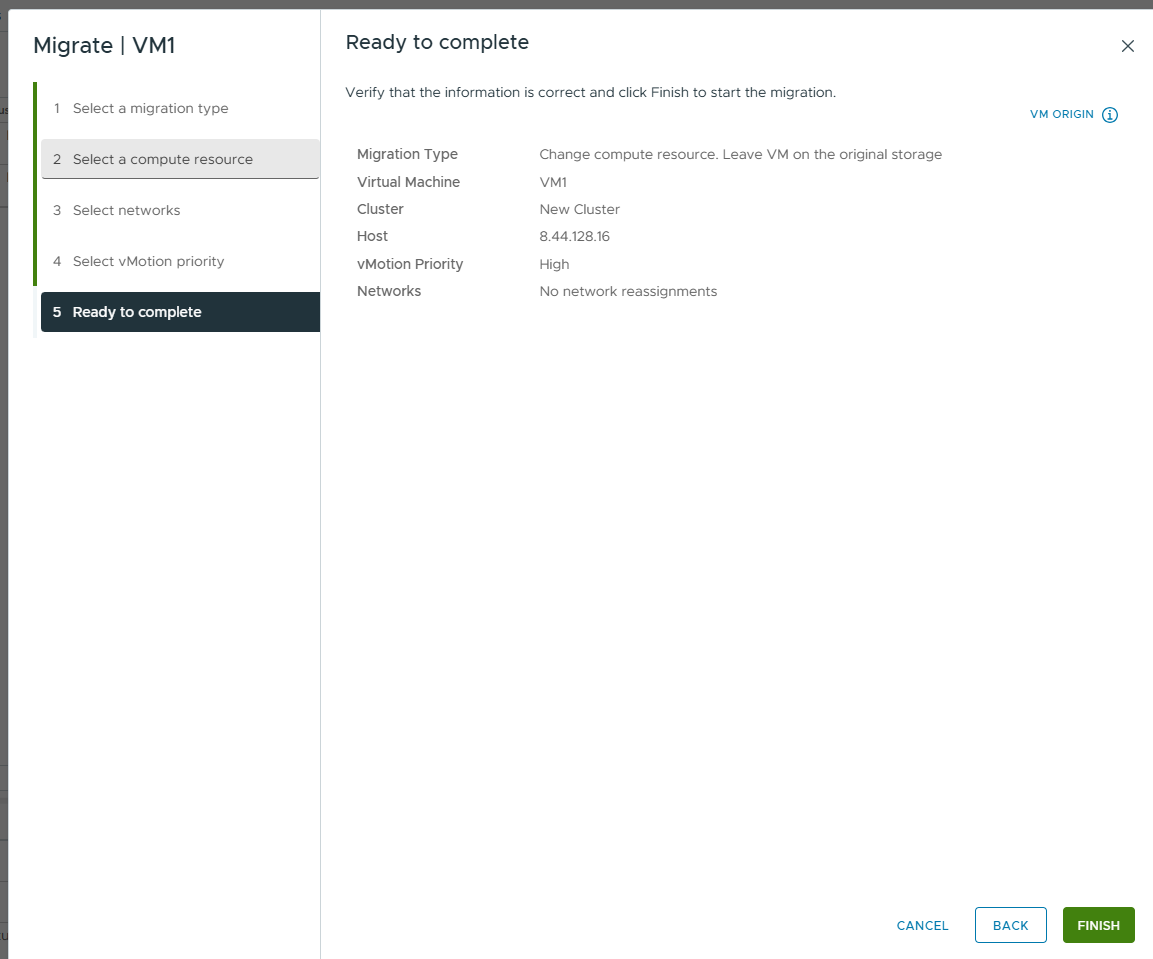

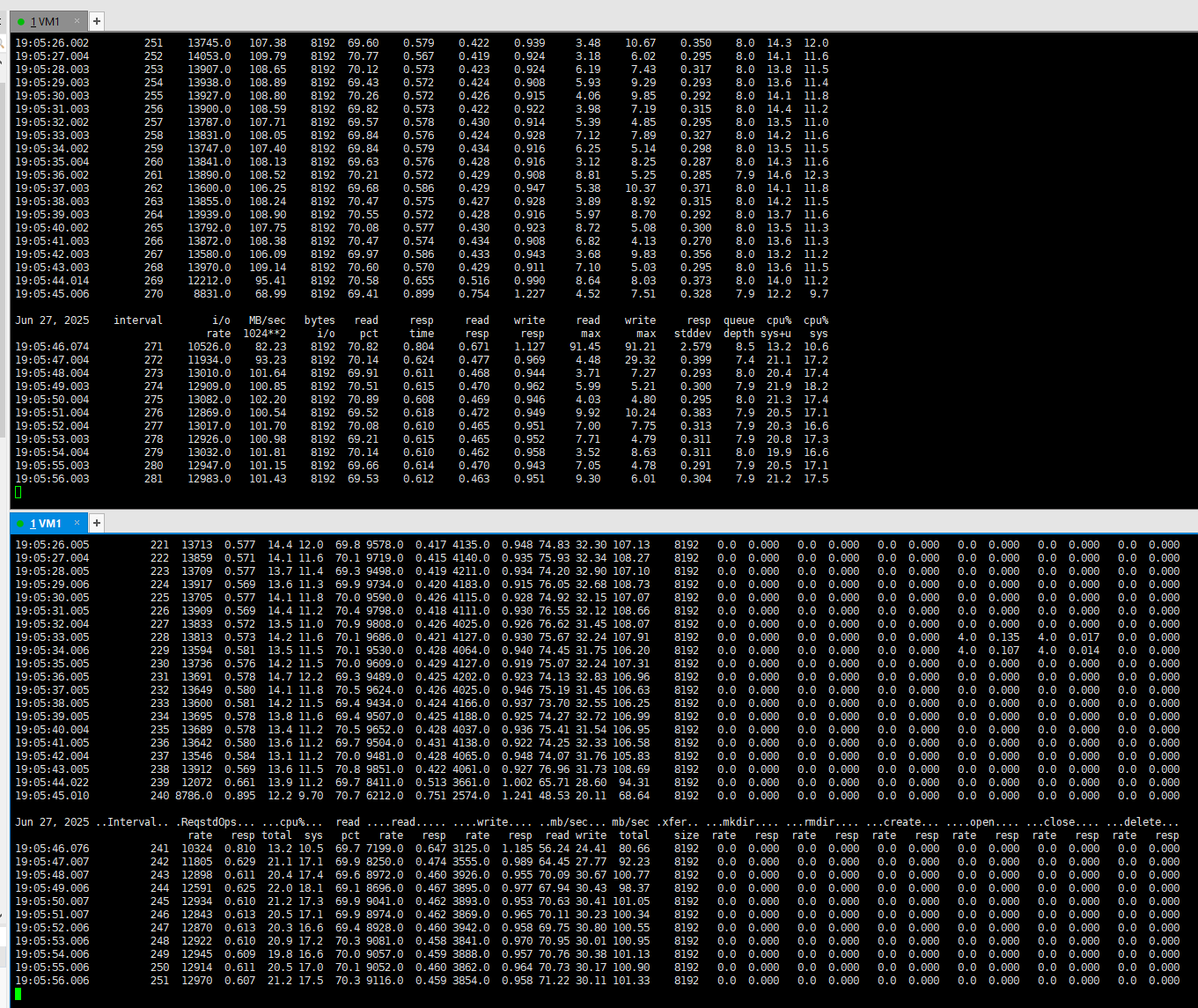
|
Test Conclusion | Passed |
